A cruise boat on the Chicago River.
6
Exploring Chicago
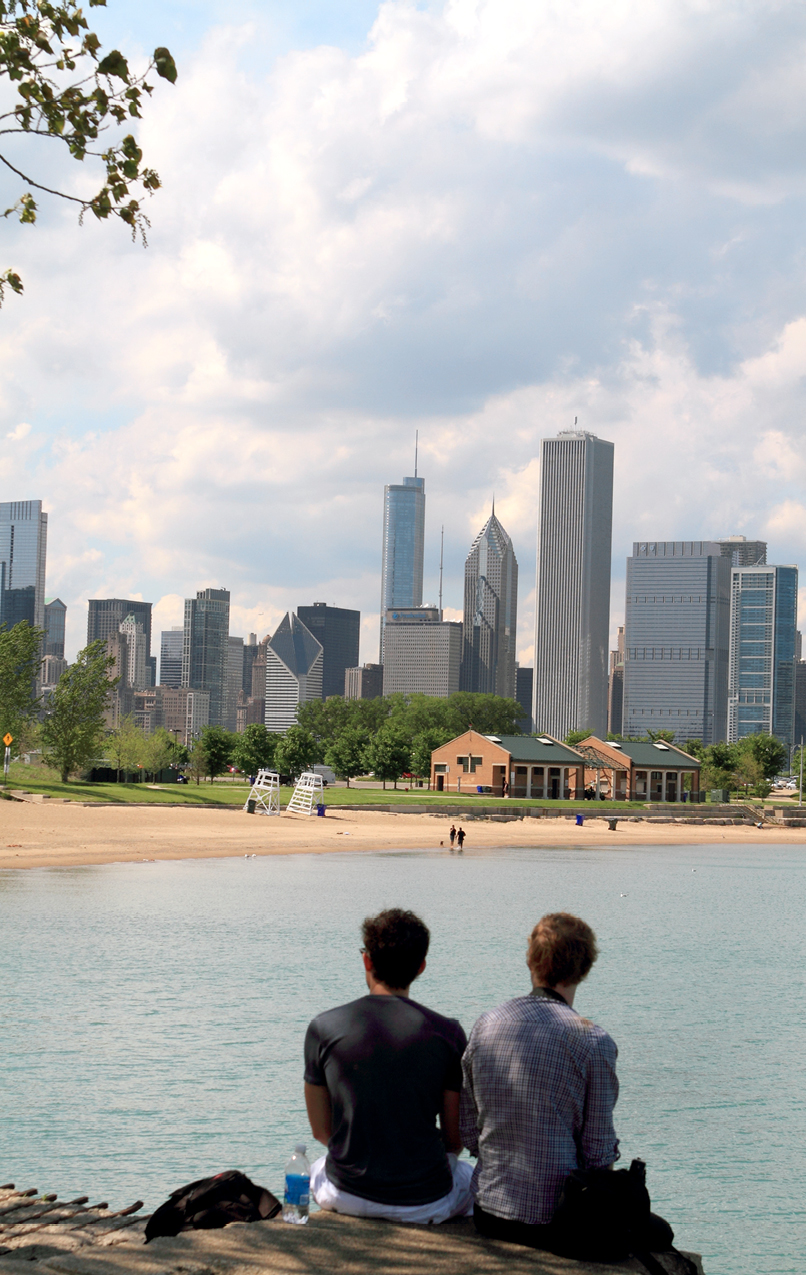
In the summer, Chicagoans flock to the Lake Michigan.
From the bustle of the Loop on a weekday morning to the tranquility of Lake Michigan on a cool fall afternoon, Chicago is an experience in contrasts. Its cultural offerings and historic attractions draw seasoned international travelers, but the city’s mix of family-friendly museums, beautiful parks, and iconic skyscrapers also attract vacationers of all ages. The fun—and the challenge—is to fit everything in one trip. You can put together a full itinerary each day and still have plenty left over for your next visit.
What you see will depend on your interests and stamina. The city’s museums alone could keep you busy for at least a week. (If you don’t have that much time, the top three exhibits that shouldn’t be missed are the Impressionist masterpieces at the Art Institute of Chicago; Sue, the biggest Tyrannosaurus rex fossil ever discovered, at the Field Museum of Natural History; and the U-505 submarine at the Museum of Science and Industry). Come summertime, a stroll through picturesque Lincoln Park Zoo on the Near North Side is the perfect way to spend an afternoon; the setting makes it worth visiting even if you don’t have kids along. (Added bonus: It’s free!)
From a traveler’s perspective, visiting Chicago is especially hassle-free because the majority of the places you’ll want to see are in or near downtown, making it easy to plan your day and get from place to place. And because this is a town with a thriving tourist economy, you have plenty of guided sightseeing options: walking tours of famous architecture, boat cruises on Lake Michigan, and even bus tours of notorious gangster sites. If you’re lucky enough to visit when the weather’s nice, you can join the locals at the parks and the beaches along Lake Michigan.
Extensive public transportation makes it simple to reach almost every tourist destination, but some of your best memories of Chicago may come from simply strolling along the sidewalks. Chicago’s neighborhoods have their own distinct styles and looks, and you’ll have a more memorable experience if you don’t limit yourself solely to the prime tourist spots. And if you really want to talk about da Bears or da Cubs, chances are, you’ll find someone who’s more than happy to join in.
In & Around the Loop: The Art Institute, the Sears Tower & Grant Park
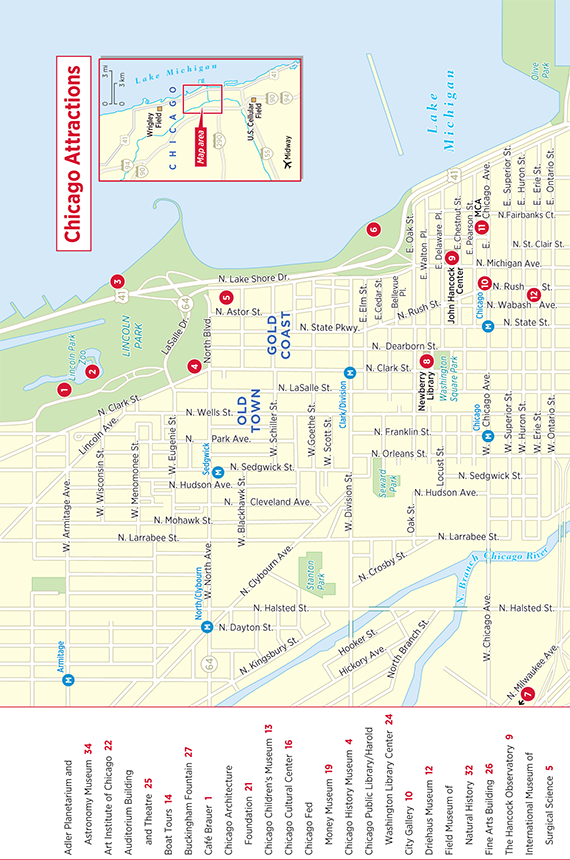
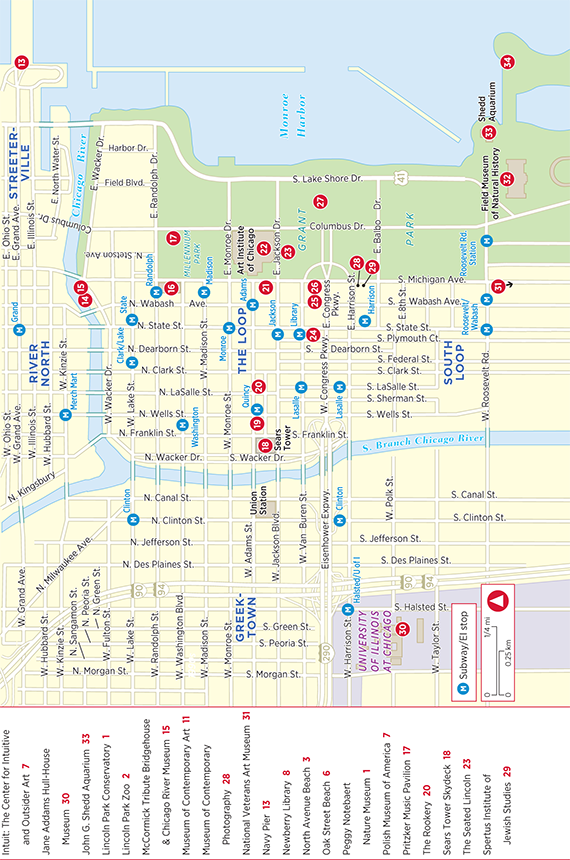
The heart of the Loop is Chicago’s business center, where you’ll find some of the city’s most famous early skyscrapers, the Chicago Board of Trade (the world’s largest commodities, futures, and options exchange), and the Sears Tower (officially renamed the Willis Tower, though Chicagoans still refer to the landmark high-rise by its original name). If you’re looking for an authentic big-city experience, wander the area on a weekday, when commuters are rushing to catch trains and businesspeople are hustling to get to work. The Loop is also home to one of the city’s top museums, the Art Institute of Chicago, as well as a number of cultural institutions including the Symphony Center (home of the Chicago Symphony Orchestra), the Auditorium Theatre, the Civic Opera House, the Goodman Theatre, and two fabulously restored historic theaters along Randolph Street. On the eastern edge of the Loop in Grant Park, three popular museums are conveniently located within a quick stroll of each other on the landscaped Museum Campus. Busy Lake Shore Drive, which brings cars zipping past the Museum Campus, was actually rerouted a few years ago to make the area easier to navigate for pedestrians.
The Top Attractions in the Loop
For a map of these attractions (or this neighborhood).
Art Institute of Chicago ★★★  You can’t—and shouldn’t—miss the Art Institute. No matter what medium or century interests you, the Art Institute has something in its collection to fit the bill. Japanese ukiyo-e prints, ancient Egyptian bronzes, Greek vases, 19th-century British photography, masterpieces by most of the greatest names in 20th-century sculpture, and modern American textiles are just some of the works on display, but for a general overview of the museum’s collection, take the free “Highlights of the Art Institute” tour, offered at 2pm on Tuesday, Saturday, and Sunday.
You can’t—and shouldn’t—miss the Art Institute. No matter what medium or century interests you, the Art Institute has something in its collection to fit the bill. Japanese ukiyo-e prints, ancient Egyptian bronzes, Greek vases, 19th-century British photography, masterpieces by most of the greatest names in 20th-century sculpture, and modern American textiles are just some of the works on display, but for a general overview of the museum’s collection, take the free “Highlights of the Art Institute” tour, offered at 2pm on Tuesday, Saturday, and Sunday.

The Art Institute of Chicago.
If time is limited, head straight to the museum’s renowned galleries of Impressionist art ★★ houses works by modern masters such as Picasso, Matisse, de Kooning, and Pollock, as well as rotating exhibits of contemporary art. Confusingly, American modern art from before 1950 is tucked into a separate gallery in the main building, but it’s well worth making a detour to see the icons that hang there (Grant Wood’s American Gothic, Edward Hopper’s Nighthawks).
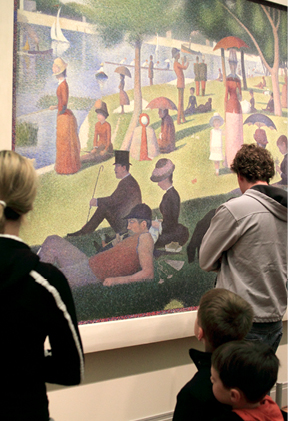
The Art Institute of Chicago’s Impressionist Art Gallery includes masterpieces by artists like Monet and Seurat.
Often overlooked but worth seeing are the Arthur Rubloff collection of delicate mid-19th-century glass paperweights, and the great hall of European arms and armor ★, dating from the 15th to the 19th centuries. Composed of more than 1,500 objects, including armor, horse equipment, swords and daggers, polearms, and maces, the collection is one of the most important assemblages of its kind in the country. (If you do head down here, you’ll see Marc Chagall’s stunning stained-glass windows at the end of the gallery.)
The Ryan Education Center on the first floor of the Modern Wing has workstations where children can create their own works of art or pick up a list of “gallery games” to make visiting the museum more fun. Another good stop for children is the Thorne Miniature Rooms ★, filled with tiny reproductions of furnished interiors from European and American history (heaven for dollhouse fanatics).
The museum has a cafeteria, an elegant full-service restaurant with Millennium Park views, and a large gift shop. It offers a busy schedule of lectures, films, and other special presentations, as well as guided tours. The museum also has a research library. Allow 3 hours.
111 S. Michigan Ave. (at Adams St.).  312/443-3600. www.artic.edu. Admission $18 adults, $12 seniors and students with ID, free for children 13 and under. Free admission 1st and 2nd Wed of the month. Mon–Fri 10:30am–5pm (Thurs until 8pm year-round, Fri until 8pm Memorial Day to Labor Day); Sat–Sun 10am–5pm. Closed Jan 1, Thanksgiving, and Christmas. Bus: 3, 4, 60, 145, 147, or 151. Subway/El: Green, Brown, Purple, or Orange line to Adams, or Red Line to Monroe/State or Jackson/State.
312/443-3600. www.artic.edu. Admission $18 adults, $12 seniors and students with ID, free for children 13 and under. Free admission 1st and 2nd Wed of the month. Mon–Fri 10:30am–5pm (Thurs until 8pm year-round, Fri until 8pm Memorial Day to Labor Day); Sat–Sun 10am–5pm. Closed Jan 1, Thanksgiving, and Christmas. Bus: 3, 4, 60, 145, 147, or 151. Subway/El: Green, Brown, Purple, or Orange line to Adams, or Red Line to Monroe/State or Jackson/State.
Sears Tower Skydeck First Sears sold the building and moved to cheaper suburban offices in 1992. Next, the Petronas Towers in Kuala Lumpur, Malaysia, claimed the title of world’s tallest building, followed by the Burj Khalifa in Dubai. Then came the final blow: In 2009, this iconic landmark was officially renamed Willis Tower, after the international insurance company that became its main tenant. Real-estate deals aside, Chicagoans stubbornly insist on calling it the Sears Tower, so feel free to do so as well.
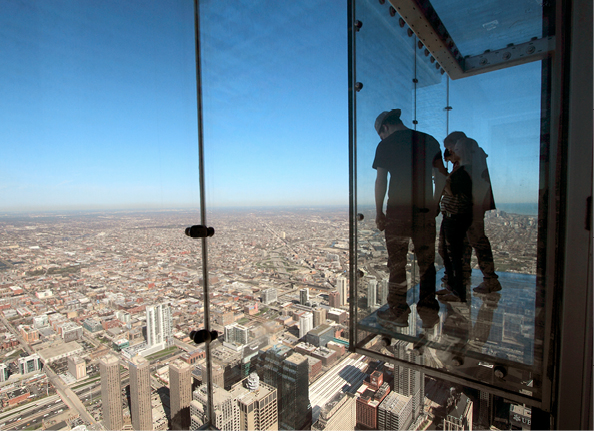
Step out onto the Sears Tower Skydeck’s “Ledge”, a nerve-wracking (and exciting!) vantage point.
Despite the fact that this observation area on the 103rd floor is called a “skydeck,” you can’t actually walk outside, but the panoramas are impressive nonetheless: On a clear day, visibility extends up to 50 miles and you can catch glimpses of four surrounding states. The most nerve-wracking viewing spot is the Ledge, a series of clear observation boxes that jut out from the side of the building: Step out, and there’s nothing between you and the ground but a layer of see-through glass. Inside the Skydeck, multimedia exhibits on Chicago history and Knee High Chicago, an exhibit for kids, add some perspective to what you’re seeing outside. Be forewarned that in the summer you may be stuck in a very long, very noisy line in the lobby, so by the time you make it to the top, your patience could be as thin as the atmosphere up there. (Come in the late afternoon or early evening to avoid most of the crowds.) The 70-second high-speed elevator trip will feel like a thrill ride for some, but it’s a nightmare for anyone with even mild claustrophobia. Allow 1 hour, more if there’s a long line.
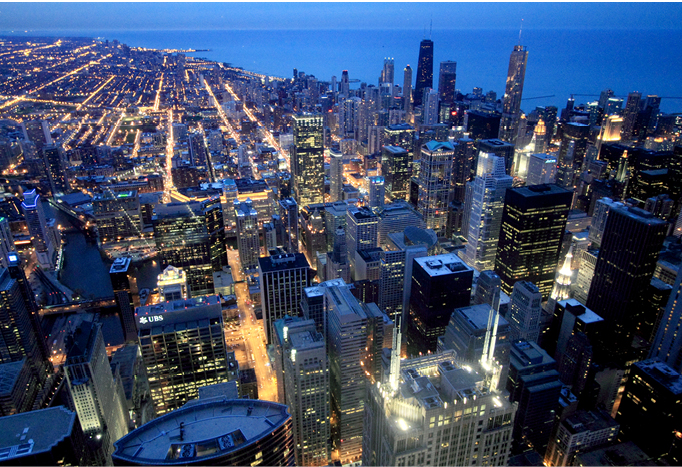
The panoramic view from the Skydeck.
233 S. Wacker Dr. (enter on Jackson Blvd.).  312/875-9696. www.the-skydeck.com. Admission $17 adults, $11 seniors and children 3–11, free for children 2 and under. Apr–Sept daily 9am–10pm; Oct–Mar daily 10am–8pm. Bus: 1, 7, 126, 146, 151, or 156. Subway/El: Brown, Purple, or Orange line to Quincy, or Red or Blue line to Jackson; and then walk a few blocks west.
312/875-9696. www.the-skydeck.com. Admission $17 adults, $11 seniors and children 3–11, free for children 2 and under. Apr–Sept daily 9am–10pm; Oct–Mar daily 10am–8pm. Bus: 1, 7, 126, 146, 151, or 156. Subway/El: Brown, Purple, or Orange line to Quincy, or Red or Blue line to Jackson; and then walk a few blocks west.
The Loop Sculpture Tour
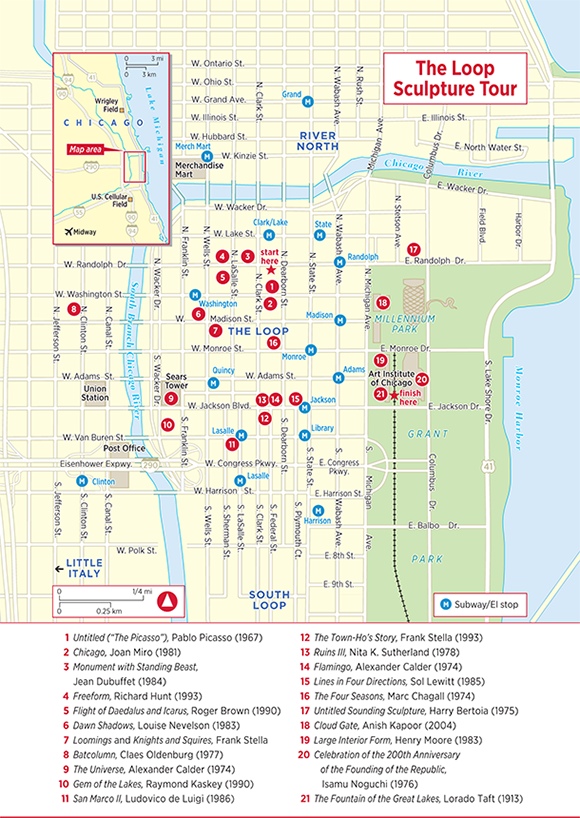
Grand monuments, statues, and contemporary sculptures are scattered in parks throughout Chicago, but the concentration of public art within the Loop and nearby Grant Park is worth noting. The best known of these works are by 20th-century artists including Picasso, Chagall, Miró, Calder, Moore, and Oldenburg. The newest addition is the massive elliptical sculpture Cloud Gate (known as “The Bean” because it looks like a giant silver kidney bean) by British artist Anish Kapoor. The sculpture, in Millennium Park, was Kapoor’s first public commission in the U.S.
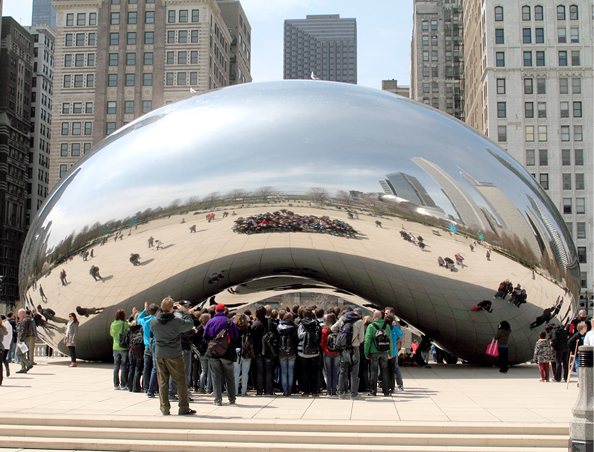
Anish Kapoor’s Cloud Gate.
A free brochure, The Chicago Public Art Guide (available at the Chicago Cultural Center, 78 E. Washington St.), can help steer you toward the best examples of monumental public art. You can also conduct a self-guided tour of the city’s best public sculptures by following “The Loop Sculpture Tour” map.
The single most famous sculpture in Chicago is Pablo Picasso’s Untitled, located in Daley Plaza and constructed out of Cor-Ten steel, the same gracefully rusting material used on the exterior of the Daley Center behind it. Viewed from various perspectives, its enigmatic shape suggests a woman, bird, or dog; the artist himself never discussed its inspiration or meaning. Perhaps because it was the first monumental modern sculpture in Chicago’s conservative business center, its installation in 1967 was met with hoots and heckles, but today “The Picasso” enjoys semiofficial status as the logo of modern Chicago. It is by far the city’s most popular photo opportunity among visiting tourists. At noon on weekdays during warm weather, you’ll likely find a dance troupe, musical group, or visual-arts exhibition here as part of the city’s long-running “Under the Picasso” multicultural program. Call 312/346-3278 for event information.
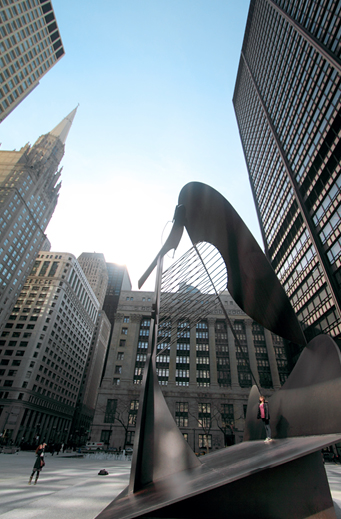
The single most famous sculpture in Chicago is Pablo Picasso’s Untitled.
Grant Park & Millennium Park
For a map of these attractions (or this neighborhood).
Thanks to architect Daniel Burnham and his coterie of visionary civic planners—who drafted the revolutionary 1909 Plan of Chicago—the city boasts a wide-open lakefront park system unrivaled by most major metropolises. Modeled after the gardens at Versailles, Grant Park (312/742-PLAY [7529]; www.chicagoparkdistrict.com) is Chicago’s front yard, composed of giant lawns segmented by allées of trees, plantings, and paths, and pieced together by major roadways and a network of railroad tracks. Incredibly, the entire expanse was created from sandbars, landfill, and debris from the Great Chicago Fire; the original shoreline extended all the way to Michigan Avenue. A few museums are spread out inside the park, but most of the space is wide open (a legacy of mail-order magnate Aaron Montgomery Ward’s late-19th-c. campaign to limit municipal buildings).
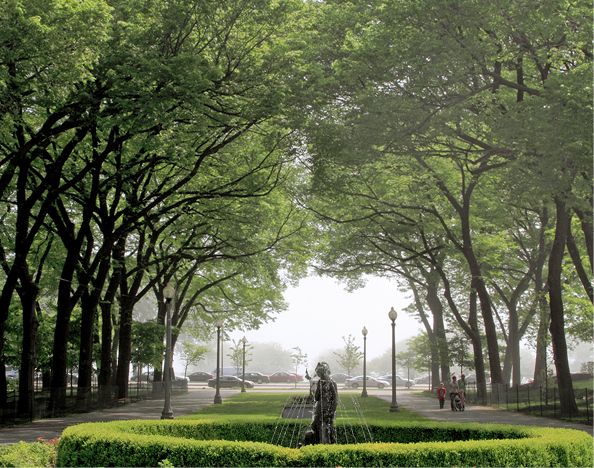
Grant Park.
The northwest corner of Grant Park (bordered by Michigan Ave. and Randolph St.) is the site of Millennium Park ★★★, one of the city’s grandest public works projects. Who cares that the park cost hundreds of millions more than it was supposed to, or the fact that it finally opened a full 4 years after the actual millennium? It’s a winning combination of beautiful landscaping, elegant architecture (the classically inspired peristyle), and public entertainment spaces (including an ice rink and theater). The park’s centerpiece is the dramatic Frank Gehry–designed Pritzker Music Pavilion, featuring massive curved ribbons of steel. The Grant Park Symphony Orchestra and Chorus stages a popular series of free outdoor classical music concerts here most Wednesday through Sunday evenings in the summer. For a schedule of concert times and dates, contact the Grant Park Music Festival (312/742-7638; www.grantparkmusicfestival.com). Two public artworks well worth checking out are the kidney bean–shaped sculpture Cloud Gate and the Crown Fountain, where children splash in the shallow water between giant faces projected on video screens. Free walking tours of the park are offered daily from May through October at 11:30am and 1pm, starting at the park’s Welcome Center, 201 E. Randolph St. (312/742-1168; www.millenniumpark.org).
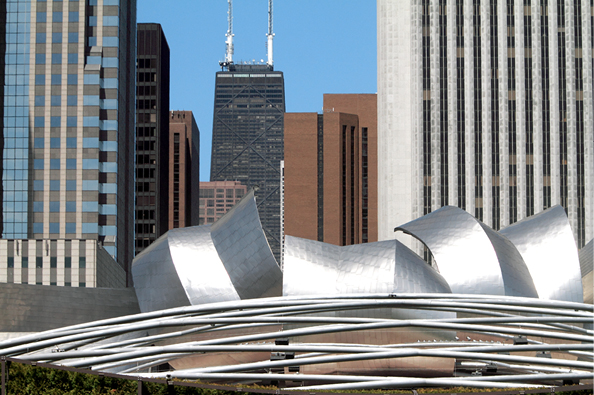
Millennium Park’s centerpiece, the Frank Gehry–designed Pritzker Music Pavilion.
During the summer, a variety of music and food festivals take over central Grant Park. Annual events that draw big crowds include a blues music festival (in June) and a jazz festival (Labor Day). The Taste of Chicago (312/744-3315; www.cityofchicago.org/specialevents) is purportedly the largest food festival in the world, with attendance estimated at 3.5 million people during the 10 days leading up to the 4th of July. Local restaurants serve up more ribs, pizza, hot dogs, and beer than you’d ever want to see, let alone eat. (See chapter 3 for a comprehensive listing of summer events in Grant Park.)
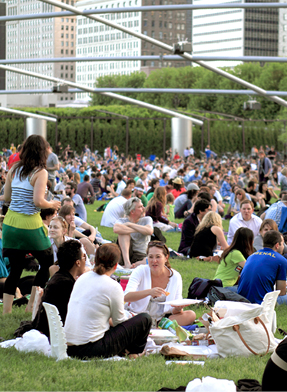
An outdoor concert at the Pritzker Pavilion.
Head south to the lake via Congress Parkway, and you’ll find Buckingham Fountain ★, the baroque centerpiece of Grant Park, composed of pink Georgia marble and patterned after—but twice the size of—the Latona Fountain at Versailles, with adjoining esplanades beautified by rose gardens in season. From April through October, the fountain spurts columns of water up to 150 feet in the air every hour on the hour, and beginning at 4pm, a whirl of colored lights and dramatic music amps up the drama. The fountain shuts down at 11pm; concession areas and bathrooms are available on the plaza.
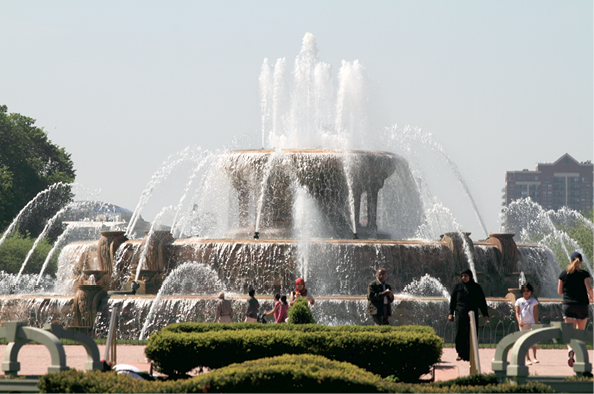
The Loop’s Buckingham Fountain spurts columns of water 150 feet in the air on the hour.
Sculptures and monuments stand throughout the park, including a sculpture of two Native Americans on horseback, The Bowman and the Spearman (at Congress Pkwy. and Michigan Ave.), which was installed in 1928 and has become the park’s trademark. Also here are likenesses of Copernicus, Columbus, and Lincoln, the latter by the great American sculptor Augustus Saint-Gaudens, located on Congress Parkway between Michigan Avenue and Columbus Drive. On the western edge of the park, at Adams Street, is the Art Institute (see above), and at the southern tip, in the area known as the Museum Campus, are the Field Museum of Natural History, the Adler Planetarium, and the Shedd Aquarium (see below for all three).
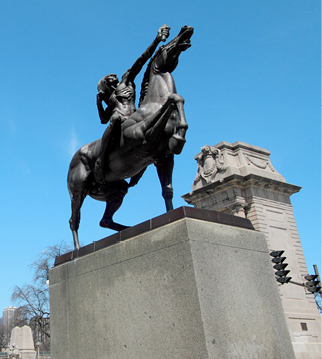
The Bowman and the Spearman.
To get to Grant Park, take bus no. 3, 4, 6, 146, or 151. If you want to take the subway/El, get off at any stop in the Loop along State or Wabash streets, and walk east.
Along South Michigan Avenue
For a map of these attractions (or this neighborhood).
The high-fashion boutiques may be clustered along the Magnificent Mile, but aesthetically, Chicago’s grandest stretch of boulevard is still the stretch of Michigan Avenue that runs south of the river. Running from the Michigan Avenue Bridge all the way down to the Field Museum, it serves as the boundary between Grant Park on one side and the Loop on the other. A stroll along this boulevard in any season offers both visual and cultural treats. Particularly impressive is the great wall of buildings from Randolph Street south to Congress Parkway (beginning with the Chicago Cultural Center and terminating at the Auditorium Building) that architecture buffs refer to as the “Michigan Avenue Cliff.”
The following attractions are listed from north to south.
McCormick Tribune Bridgehouse & Chicago River Museum  Chicago has more moveable bridges than any other city in the world, and this modest museum provides a glimpse into the machinery that operates them. Although it’s located on one of the busiest corners in town—at the southwest corner of the Michigan Avenue Bridge—the entrance is easy to miss. (You have to walk down a flight of stone steps to river level.) Inside, as you walk up the bridgehouse’s five floors, historic engravings and photos trace the history of the city as it relates to the river (including the engineering feat that reversed the river’s flow). The coolest part is the observation deck directly under the bridge, where you can gawk at the massive gears while listening to the pounding of traffic overhead. To see the gears in action, reserve a spot during one of the scheduled bridge lifts, which take place about six times a month; admission is $10 per person. (Check the museum’s website for dates.)
Chicago has more moveable bridges than any other city in the world, and this modest museum provides a glimpse into the machinery that operates them. Although it’s located on one of the busiest corners in town—at the southwest corner of the Michigan Avenue Bridge—the entrance is easy to miss. (You have to walk down a flight of stone steps to river level.) Inside, as you walk up the bridgehouse’s five floors, historic engravings and photos trace the history of the city as it relates to the river (including the engineering feat that reversed the river’s flow). The coolest part is the observation deck directly under the bridge, where you can gawk at the massive gears while listening to the pounding of traffic overhead. To see the gears in action, reserve a spot during one of the scheduled bridge lifts, which take place about six times a month; admission is $10 per person. (Check the museum’s website for dates.)
376 N. Michigan Ave. (at the Chicago River).  312/977-0227. www.bridgehousemuseum.org/home. Admission $4, seniors and children 6–12 $3, free for children 5 and under. May–Oct Thurs–Mon 10am–5pm. Bus: 3, 4, 20, 56, 145, 146, 147, 151, or 157. Subway/El: Brown, Green, Orange, or Purple line to Randolph, or Red Line to Washington.
312/977-0227. www.bridgehousemuseum.org/home. Admission $4, seniors and children 6–12 $3, free for children 5 and under. May–Oct Thurs–Mon 10am–5pm. Bus: 3, 4, 20, 56, 145, 146, 147, 151, or 157. Subway/El: Brown, Green, Orange, or Purple line to Randolph, or Red Line to Washington.
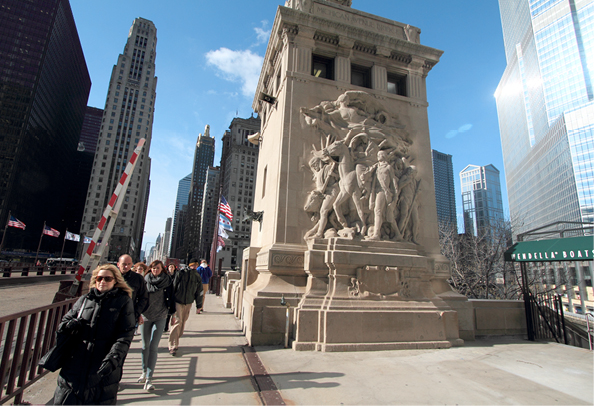
Michigan Avenue Bridge.
Chicago Cultural Center ★ inside Preston Bradley Hall on the 2nd floor, said to be the largest of its kind in the world.

The Chicago Cultural Center’s Tiffany dome.
The building also houses a Chicago Office of Tourism visitor center, which makes it an ideal place to kick-start your visit. If you stop in to pick up tourist information and take a quick look around, your visit won’t take longer than 15 minutes, but the Cultural Center also schedules an array of art exhibitions, concerts, films, lectures, and other special events (many free), which might convince you to extend your time here. A long-standing tradition is the 12:15pm Dame Myra Hess Memorial classical concert every Wednesday in the Preston Bradley Hall.
Free guided architectural tours of the Cultural Center run at 1:15pm on Wednesday, Friday, and Saturday.
78 E. Washington St.  312/FINE-ART [744-6630] for weekly events. www.chicagoculturalcenter.org. Free admission. Mon–Thurs 9am–7pm; Fri 8am–6pm; Sat 9am–6pm; Sun 10am–6pm. Closed major holidays. Bus: 3, 4, 20, 56, 145, 146, 147, 151, or 157. Subway/El: Brown, Green, Orange, or Purple line to Randolph, or Red Line to Washington.
312/FINE-ART [744-6630] for weekly events. www.chicagoculturalcenter.org. Free admission. Mon–Thurs 9am–7pm; Fri 8am–6pm; Sat 9am–6pm; Sun 10am–6pm. Closed major holidays. Bus: 3, 4, 20, 56, 145, 146, 147, 151, or 157. Subway/El: Brown, Green, Orange, or Purple line to Randolph, or Red Line to Washington.
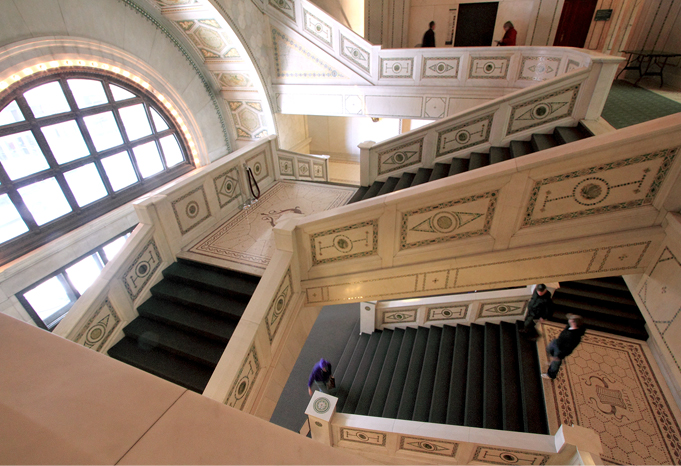
The Beaux Arts Grand Staircase in the Chicago Cultural Center.
Chicago Architecture Foundation Chicago’s architecture is one of the city’s main claims to fame, and a quick swing through this non-profit foundation’s visitor center (conveniently located across the street from the Art Institute) will help you understand why. Permanent exhibits include a scale model of downtown Chicago, profiles of the people and buildings that shaped the city’s look, and a searchable database with information on many of Chicago’s best-known skyscrapers. Two galleries also feature changing exhibits about ongoing Chicago design projects, so you can see firsthand how local architecture continues to evolve. “Architecture ambassadors” are on hand to provide information on the excellent tours run by the foundation, which are well worth experiencing, especially for visitors new to the city (see “Sightseeing Tours”). An appealing gift shop is filled with architecture-focused books, well-designed decorative accessories, and an eclectic array of gifts. Allow a half-hour, more if you want to browse in the store.
224 S. Michigan Ave.  312/922-3432, ext. 241. www.architecture.org. Free admission. Exhibits daily 9:30am–5pm. Shop and tour desk daily 9am–6:30pm. Bus: 3, 4, 145, 147, or 151. Subway/El: Brown, Green, Purple, or Orange line to Adams, or Red Line to Jackson.
312/922-3432, ext. 241. www.architecture.org. Free admission. Exhibits daily 9:30am–5pm. Shop and tour desk daily 9am–6:30pm. Bus: 3, 4, 145, 147, or 151. Subway/El: Brown, Green, Purple, or Orange line to Adams, or Red Line to Jackson.
Fine Arts Building A worthwhile brief stop for architecture and history buffs, this 1885 building was originally a showroom for Studebaker carriages. In 1917 it became an arts center, with offices, shops, two theaters, and studios for musicians, artists, and writers. Its upper stories sheltered a number of well-known publications (the Saturday Evening Post, Dial) and provided offices for such luminaries as Frank Lloyd Wright, sculptor Lorado Taft, and L. Frank Baum, author of The Wonderful Wizard of Oz. Harriet Monroe published her magazine, Poetry, here, and introduced American readers to Carl Sandburg, T. S. Eliot, and Ezra Pound. Before the literary lions prowled its halls, the building served as a rallying base for suffragettes. Located throughout the building are a number of interesting studios and musical instrument shops. Take at least a quick walk through the marble-and-wood lobby, and ride the vintage elevator to the top floor to see the Art Nouveau–era murals. Allow a half-hour.
410 S. Michigan Ave.  312/566-9800. www.fineartsbuilding.tv. Free admission. Mon–Fri 7am–10pm; Sat 7am–9pm; Sun 9am–5pm. Bus: 3, 4, 145, 147, or 151. Subway/El: Brown, Green, Purple, or Orange line to Adams, or Red Line to Jackson.
312/566-9800. www.fineartsbuilding.tv. Free admission. Mon–Fri 7am–10pm; Sat 7am–9pm; Sun 9am–5pm. Bus: 3, 4, 145, 147, or 151. Subway/El: Brown, Green, Purple, or Orange line to Adams, or Red Line to Jackson.
Auditorium Building and Theatre ★★ A truly grand theater with historic landmark status, the Auditorium gives visitors a taste of late-19th-century Chicago opulence. Because it’s still a working theater—not a museum—it’s not usually open to the public during the day; to make sure you’ll get in, schedule a guided tour, which are offered on Monday at 10:30am and noon, and Thursday at 10:30am. (Call 312/431-2389 to confirm the date and time.) Tours cost $10 per person.
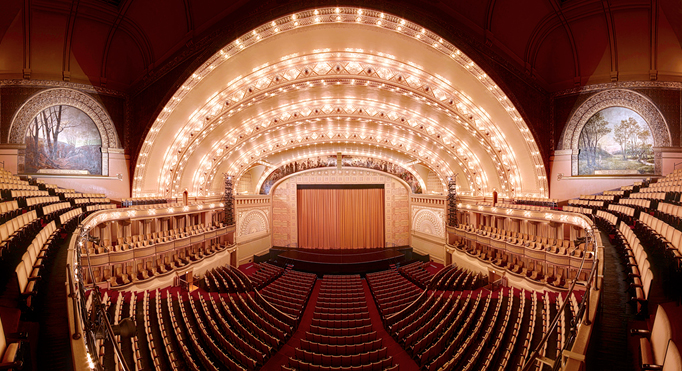
The Auditorium Theatre gives visitors a taste of late-19th-century opulence.
Designed and built in 1889 by Louis Sullivan and Dankmar Adler, the 4,000-seat Auditorium was a wonder of the world: The heaviest (110,000 tons) and most massive modern edifice on earth, the most fireproof building ever constructed, and the tallest building in Chicago. It was also the first large-scale building to be lit by electricity, and its theater was the first in the country to install air-conditioning. Originally the home of the Chicago Opera Company, Sullivan and Adler’s masterpiece is defined by powerful arches lit by thousands of bulbs and features Sullivan’s trademark ornamentation—in this case, elaborate golden stenciling and gold plaster medallions. It’s equally renowned for otherworldly acoustics and unobstructed sightlines.
During World War II, the building sheltered GIs, and its theater stage was turned into a bowling alley. The theater reopened in 1967 following a $3-million renovation made possible through the fundraising efforts of the nonprofit Auditorium Theatre Council. Remnants of the building’s halcyon days remain in the Michigan Avenue lobby, with its faux-marble ornamental columns, molded ceilings, mosaic floors, and Mexican onyx walls.
An insider tip: If you can’t get in for a tour, you can still get a glimpse of the building’s historic past. Around the corner on Michigan Avenue, walk in the entrance that now houses Roosevelt University, and you’ll get a sense of the building’s grand public spaces. Take the elevator to the school’s 10th-floor library reading room to see the theater’s original dining room, with a barrel-vaulted ceiling and marvelous views of Grant Park.
Allow 1 hour for the guided tour.
50 E. Congress Pkwy.  312/922-2110. www.auditoriumtheatre.org. For tickets to a performance at the Auditorium, call Ticketmaster at
312/922-2110. www.auditoriumtheatre.org. For tickets to a performance at the Auditorium, call Ticketmaster at  312/902-1500. Bus: 145, 147, or 151. Subway/El: Brown, Green, Orange, or Purple line to Library/Van Buren, or Red Line to Jackson.
312/902-1500. Bus: 145, 147, or 151. Subway/El: Brown, Green, Orange, or Purple line to Library/Van Buren, or Red Line to Jackson.
Museum of Contemporary Photography Ensconced in a ground-floor space at Columbia College—a progressive arts- and media-oriented institution that boasts the country’s largest undergraduate film department and a highly respected photojournalism-slanted photography department—the Museum of Contemporary Photography is the only museum in the Midwest of its kind. As the name indicates, it exhibits, collects, and promotes modern photography, with a special focus on American works from 1959 to the present. Rotating exhibitions showcase images by both nationally recognized and “undiscovered” regional artists. Related lectures and special programs take place during the year. Allow 1 hour.
600 S. Michigan Ave.  312/663-5554. www.mocp.org. Free admission. Mon–Sat 10am–5pm (Thurs until 8pm); Sun noon–5pm. Bus: 6, 146, or 151. Subway/El: Red Line to Harrison.
312/663-5554. www.mocp.org. Free admission. Mon–Sat 10am–5pm (Thurs until 8pm); Sun noon–5pm. Bus: 6, 146, or 151. Subway/El: Red Line to Harrison.
The Spertus Institute of Jewish Studies This educational center and museum collects and preserves historic Jewish ceremonial objects, textiles, and sculpture, but its stunning modern building is firmly ensconced in the present. A glass facade fills the airy, white interior with light (even on cloudy days), and an outdoor terrace off the 10th-floor exhibition space lets you gaze out over Grant Park and the lake beyond. Art from the institute’s collection is showcased throughout the building and temporary exhibits examine aspects of Jewish culture. The building also includes a 400-seat theater for lectures, films, and performances. Researchers can register to visit the Asher Library or study the Chicago Jewish Archives collection. The well-stocked gift shop carries a large selection of art, books, music, videos, and contemporary and traditional Jewish ceremonial gifts. Allow 1 hour.
610 S. Michigan Ave.  312/322-1700. www.spertus.edu. Free admission Sun–Thurs 10am–5pm. Closed for major national holidays and Jewish religious holidays. Bus: 3, 4, 6, 145, 147, or 151. Subway/El: Red Line to Harrison, or Brown, Purple, Orange, or Green line to Adams. Validated parking in nearby lots.
312/322-1700. www.spertus.edu. Free admission Sun–Thurs 10am–5pm. Closed for major national holidays and Jewish religious holidays. Bus: 3, 4, 6, 145, 147, or 151. Subway/El: Red Line to Harrison, or Brown, Purple, Orange, or Green line to Adams. Validated parking in nearby lots.
Elsewhere in the Loop
For a map of these attractions (or this neighborhood).
 Museum free Days
Museum free Days
If you time your visit right, you can save yourself some admission fees—but not during prime tourist season. While some major museums offer free admission at specific times year-round, others schedule free days only during the slowest times of the year (usually late fall and the dead of winter); keep in mind that you will still have to pay for special exhibitions and films on free days. The good news? Some smaller museums never charge admission.
Monday: Field Museum of Natural History (2nd Monday of every month), and Shedd Aquarium (mid-Sept to Nov and Jan–Feb; Oceanarium admission extra).
Tuesday: International Museum of Surgical Science, Museum of Contemporary Art, and Shedd Aquarium (mid-Sept to Nov and Jan–Feb; Oceanarium admission extra).
Wednesday: Art Institute of Chicago (first and second Wed of each month); The Spertus Institute of Jewish Studies (10am–noon).
Thursday: Chicago Children’s Museum (5–8pm), and Spertus Institute of Jewish Studies (2–6pm).
Always Free: Chicago Cultural Center, Garfield Park Conservatory, David and Alfred Smart Museum of Art, Jane Addams Hull–House Museum, Lincoln Park Conservatory, Lincoln Park Zoo, National Museum of Mexican Art, Museum of Contemporary Photography, and Newberry Library.
Chicago Fed Money Museum It’s not worth a special trip unless you’re a monetary-policy megageek, but the visitor center at the Federal Reserve Bank of Chicago is worth a quick stop during a walk around the Loop. More than just the standard history-of-banking displays, the center has kid-friendly features such as a giant cube that holds a million dollars, an exhibit that lets you try to detect counterfeit bills, and a section where visitors can play Fed chairman, showing how changes in interest rates affect the economy. A suitcase packed with $1 million makes for a fun family photo op. Free guided tours begin at 1pm on weekdays. Allow a half-hour.
230 S. LaSalle St. (at Quincy St.).  312/322-2400. www.chicagofed.org. Free admission. Mon–Fri 9am–5pm. Closed federal holidays. Bus: 134, 135, 136, or 156. Subway/El: Brown Line to Quincy/Wells or Red Line to Jackson.
312/322-2400. www.chicagofed.org. Free admission. Mon–Fri 9am–5pm. Closed federal holidays. Bus: 134, 135, 136, or 156. Subway/El: Brown Line to Quincy/Wells or Red Line to Jackson.
This giant cube at the Chicago Fed Money Museum holds a million dollars.

Chicago Public Library/Harold Washington Library Center A massive, hulking building that looks like an Italian Renaissance fortress, Chicago’s main public library is the largest in the world. Named for the city’s first and only African-American mayor, who died of a heart attack in 1987 at the beginning of his second term in office, the building fills an entire city block at State Street and Congress Parkway. The interior design has been criticized for feeling cold and impersonal (you have to go up a few floors before you even see any books), but the stunning 52-foot glass-domed Winter Garden ★ on the top floor is worth a visit. On the second floor is another treasure: The vast Thomas Hughes Children’s Library, which makes an excellent resting spot for families traveling with kids. The library also offers an interesting array of events and art exhibitions that are worth checking out. A 385-seat auditorium is the setting for a unique mix of dance and music performances, author talks, and children’s programs. Want to check your e-mail? Stop by the third-floor Computer Commons, which has about 75 terminals available for public use. Allow a half-hour.
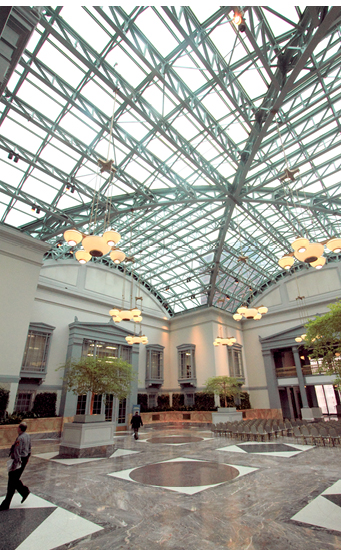
The stunning glass-domed Winter Garden on the Public Library’s top floor.
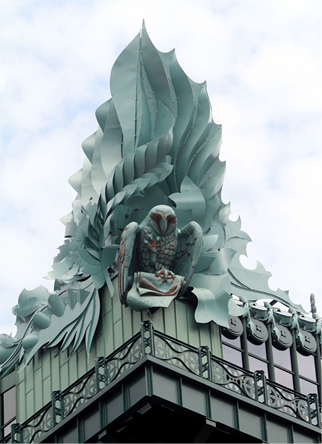
The Chicago Public Library’s facade.
400 S. State St.  312/747-4300. www.chipublib.org. Free admission. Mon–Thurs 9am–9pm; Fri–Sat 9am–5pm; Sun 1–5pm. Closed major holidays. Bus: 2, 6, 11, 29, 36, 62, 145, 146, 147, or 151. Subway/El: Red Line to Jackson, or Brown Line to Van Buren/Library.
312/747-4300. www.chipublib.org. Free admission. Mon–Thurs 9am–9pm; Fri–Sat 9am–5pm; Sun 1–5pm. Closed major holidays. Bus: 2, 6, 11, 29, 36, 62, 145, 146, 147, or 151. Subway/El: Red Line to Jackson, or Brown Line to Van Buren/Library.
The Rookery ★ From the outside, this gloomy building gives no hint of the beauty within. Designed by master architect Daniel Burnham in the 1880s, it was one of Chicago’s largest and most expensive office buildings when it was completed. (The name was a carryover from the old City Hall that previously occupied the site, a favorite of roosting birds.) In 1898, a young architect starting up an independent practice, Frank Lloyd Wright, rented an office here; a few years later, he was commissioned to update the building’s interior. The resulting work is one of the loveliest commercial interiors in the city, a two-story glass pavilion filled with natural light and gleaming white marble. Free half-hour tours are offered on Mondays and Fridays at noon; longer tours, including the on-site library, start at noon on Wednesdays and cost $10 (no advance reservations required). The ShopWright store stocks a well-edited collection of books and decorative accessories. Allow 5 minutes for a quick look, up to 45 minutes if you stay for a tour.
209 S. LaSalle St. (at Adams St.).  312/994-4000. www.gowright.org/visit/rookery.html. Free admission. Mon–Fri 9am–5pm. Closed federal holidays. Bus: 134, 135, 136, or 156. Subway/El: Brown Line to Quincy/Wells or Red Line to Jackson.
312/994-4000. www.gowright.org/visit/rookery.html. Free admission. Mon–Fri 9am–5pm. Closed federal holidays. Bus: 134, 135, 136, or 156. Subway/El: Brown Line to Quincy/Wells or Red Line to Jackson.
The Grant Park Museum Campus’s Big Three
For a map of these attractions (or this neighborhood).
With terraced gardens and broad walkways, the Museum Campus at the southern end of Grant Park makes it easy for pedestrians to visit three of the city’s most beloved institutions: the Field Museum of Natural History, Shedd Aquarium, and Adler Planetarium. To get to the Museum Campus from the Loop, walk south on Michigan Avenue to East Balbo Drive. Head east on Balbo, across Grant Park, then trek south along the lakeshore path to the museums (about a 15-min. walk). Or follow 11th Street east from South Michigan Avenue, which takes you across a walkway spanning the Metra train tracks. Cross Columbus Drive, and then pick up the path that will take you under Lake Shore Drive and into the Museum Campus. The CTA no. 146 bus will take you from downtown to all three of these attractions; it also stops at the Roosevelt El stop on the Red Line. Call 312/836-7000 (from any city or suburban area code) for the stop locations and schedule.
A large indoor parking lot is accessible from Lake Shore Drive southbound; you can park there for $16 for up to 4 hours, $19 all day. Be aware that there is no public parking during Chicago Bears games in the fall; Soldier Field is next to the Museum Campus, and football fans get first dibs on all the surrounding parking spaces.
Adler Planetarium and Astronomy Museum ★★ The building may be historic (it was the first planetarium in the Western Hemisphere), but some of the attractions here will hold the attention of even the most jaded video game addict.
Your first stop should be the modern Sky Pavilion, where the don’t-miss experience is the Space Theater ★★. Settle down under the massive dome, and you’ll take a half-hour interactive virtual-reality trip through the Milky Way and into deep space, featuring a computer-generated 3-D-graphics projection system and controls in the armrest of each seat. Six high-resolution video projectors form a seamless image above your head—you’ll feel as if you’re literally floating in space. If you’re looking for more entertainment, the Sky Theater shows movies with an astronomical bent, and the Universe Theater presents 3-D features, most shot in outer space.
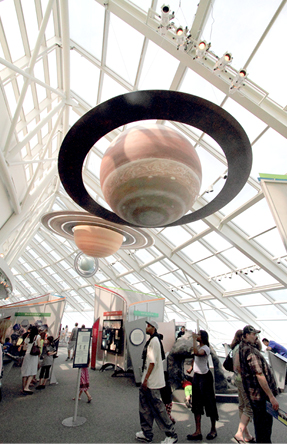
The Adler Planetarium and Astronomy Museum.
The planetarium’s exhibition galleries feature a variety of displays and interactive activities. If you’re going to see only one exhibit, check out Shoot For the Moon ★, which traces the ways different cultures have tried to make sense of astronomical phenomena, and Universe in Your Hands, which includes artifacts from the planetarium’s extensive collection of astronomical instruments. (Although suitable for older children, these can get a bit boring for little ones unless they’re real astronomy nuts.)
The museum’s cafe provides views of the lakefront and skyline. On the third Thursday evening of the month, the museum stays open until 10pm, and visitors can view dramatic close-ups of the moon, the planets, and distant galaxies through a closed-circuit monitor connected to the planetarium’s Doane Observatory telescope.
Allow 2 hours, more if you want to see more than one show.
1300 S. Lake Shore Dr.  312/922-STAR (7827). www.adlerplanetarium.org. Admission $10 adults, $8 seniors, $6 children 3–14, free for children 2 and under; admission including 2 shows $27 adults, $21 children. Memorial Day to Labor Day daily 9:30am–6pm; early Sept to late May Mon–Fri 10am–4pm; Sat–Sun 10am–4:30pm; 3rd Thurs of every month until 10pm. StarRider Theater and Sky Shows run throughout the day; call main number for current times. Bus: 146.
312/922-STAR (7827). www.adlerplanetarium.org. Admission $10 adults, $8 seniors, $6 children 3–14, free for children 2 and under; admission including 2 shows $27 adults, $21 children. Memorial Day to Labor Day daily 9:30am–6pm; early Sept to late May Mon–Fri 10am–4pm; Sat–Sun 10am–4:30pm; 3rd Thurs of every month until 10pm. StarRider Theater and Sky Shows run throughout the day; call main number for current times. Bus: 146.
 Website Extras
Website Extras
Scanning the websites of museums and other attractions before you visit can enhance your trip when you get here. At the Field Museum of Natural History website (www.fieldmuseum.org), you can download an MP3 audio tour of the museum’s permanent collection; you can also print out a Family Adventure Tour, which sends kids on a scavenger hunt throughout the museum. The Millennium Park MP3 audio tour (available at www.millenniumpark.org) includes interviews with the artists who created the park’s eye-catching artwork. And if you’re intimidated by the massive size of the Museum of Science and Industry, check out the website’s Personal Planner, which will put together a customized itinerary based your family’s interests (www.msichicago.org).
Field Museum of Natural History ★★★  Is it any wonder that Steven Spielberg thought the Field Museum of Natural History was a suitable home turf for the intrepid archaeologist and adventurer hero of his Indiana Jones movies? Spread over the museum’s 9 acres of floor space are scores of permanent and temporary exhibitions—some interactive, but most requiring the old-fashioned skills of observation and imagination.
Is it any wonder that Steven Spielberg thought the Field Museum of Natural History was a suitable home turf for the intrepid archaeologist and adventurer hero of his Indiana Jones movies? Spread over the museum’s 9 acres of floor space are scores of permanent and temporary exhibitions—some interactive, but most requiring the old-fashioned skills of observation and imagination.
Navigating all the exhibits can be daunting, so pace yourself and prioritize what you want to see. Start in the grand Stanley Field Hall, where you’ll stand face-to-face with Sue ★★★, the largest, most complete Tyrannosaurus rex fossil ever unearthed. The museum acquired the specimen—named for the paleontologist who discovered it in South Dakota in 1990—for a cool $8.4 million after a high-stakes bidding war. The real skull is so heavy that a lighter copy had to be mounted on the skeleton; the actual one is on display nearby.
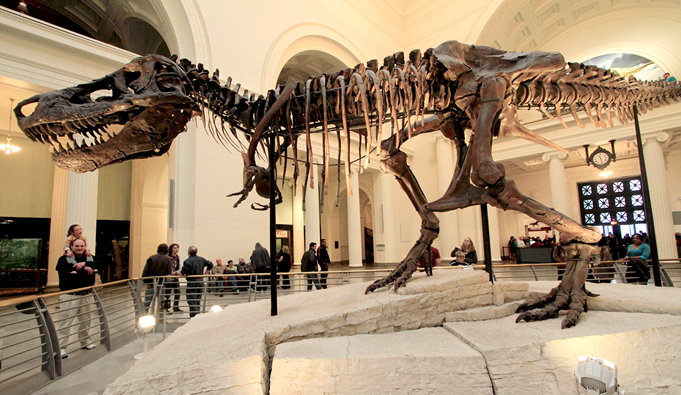
Stand face-to-face with Sue, the most complete Tyrannosaurus rex fossil ever unearthed;
Families should head downstairs for the most popular kid-friendly exhibits. Walking through Inside Ancient Egypt ★, a “total immersion environment” populated by giant robotic earwigs, centipedes, wolf spiders, and other subterranean critters. It’s a hit with kids but—annoyingly—carries an extra admission charge ($7 on top of regular admission).
You might be tempted to skip the “peoples of the world” exhibits, but the ones here are not only mind opening and well designed, but also great fun. Africa ★, hidden up on the second floor, is definitely worth a stop. Hundreds of artifacts from the museum’s oceanic collection re-create scenes of island life in the South Pacific. (There’s even a full-scale model of a Maori Meeting House.) Native Chicagoans will quickly name two more signature highlights that have been here for years: the taxidermies of Bushman (a legendary lowland gorilla that made international headlines while at the city’s Lincoln Park Zoo) and the Man-Eating Lions of Tsavo (the pair of male lions that munched nearly 140 British railway workers constructing a bridge in East Africa in 1898; their story is featured in the film The Ghost and the Darkness).
If you’ve got little kids along (ages 7 and under), don’t miss the Crown Family PlayLab, which is full of hands-on activities, including an art room, dress-up station and a soundproofed space filled with drums and other percussion instruments. (Note: The PlayLab is closed Tues and Wed.)
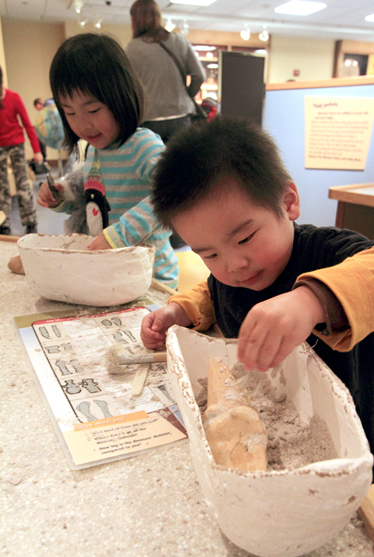
The Crown Family PlayLab is full of hands-on activities for kids.
The museum books special traveling exhibits (recent blockbusters included shows on King Tut and ancient Pompeii), but be forewarned: The high-profile exhibits are usually crowded and—again—have an additional admission charge. A much better deal is a free tour of the museum highlights; tours begin daily at 11am and 2pm.
When you’re ready to take a break, the Corner Bakery cafe, just off the main hall, serves food a cut above the usual museum food court—although there’s also a McDonald’s on the lower level. Allow 3 hours (although you could easily spend all day).
Roosevelt Rd. and Lake Shore Dr.  312/922-9410. http://fieldmuseum.org. Admission $15 adults, $12 seniors and students with ID, $10 children 3–11, free for children 2 and under. Extra fees apply for special exhibits. Free admission the second Mon of every month. Daily 9am–5pm. Closed Christmas. Bus: 146.
312/922-9410. http://fieldmuseum.org. Admission $15 adults, $12 seniors and students with ID, $10 children 3–11, free for children 2 and under. Extra fees apply for special exhibits. Free admission the second Mon of every month. Daily 9am–5pm. Closed Christmas. Bus: 146.
 Getting the Most from Your Field Museum Visit
Getting the Most from Your Field Museum Visit
You could easily spend a day at the Field Museum—so don’t waste half of it trying to decide where to go. The Field is one of Chicago’s must-see destinations for families, but it can get crowded, especially during school vacations in the winter and summer. Remember that the museum opens earlier than most people realize—at 9 in the morning—and you’ll get a jump on the crowds as long as you arrive by 10am. Head for two of the most popular exhibits first: Inside Ancient Egypt (on the ground floor) and the Dinosaur Hall (on the upper level). It also pays to take an early lunch break: The Field has two on-site restaurants (McDonald’s and Corner Bakery) but no cafeteria, and both places are often full by noon. If you plan ahead and bring your own food, you can eat in relative peace and quiet at the Siragusa Center on the lower level, a large, bright room with benches, tables, and vending machines.
John G. Shedd Aquarium ★★★ The Shedd is one of the world’s largest indoor aquariums and houses thousands of river, lake, and sea denizens in standard aquarium tanks and elaborate new habitats within its octagon-shaped marble building. The only problem with the Shedd is its relatively steep admission price. You can keep your costs down by buying “Aquarium Only” tickets; the tradeoff is that you’ll miss some of the most stunning exhibits. A CityPass (see “Museums for Less,” above) can save you money if you visit enough of the other included attractions.
The first thing you’ll see as you enter is the Caribbean Coral Reef ★. This 90,000-gallon circular tank occupies the Beaux Arts–style central rotunda, entertaining spectators who press up against the glass to ogle divers feeding nurse sharks, barracudas, stingrays, and a hawksbill sea turtle. A roving camera connected to video monitors on the tank’s periphery gives visitors close-ups of the animals inside, but I’d recommend sticking around to catch one of the daily feedings, when a diver swims around the tank and (thanks to a microphone) talks about the species and their eating habits.
The exhibits surrounding the Caribbean coral reef re-create marine habitats around the world. The best is Amazon Rising: Seasons of the River ★, a rendering of the Amazon basin that showcases frogs and other South American species, as well as fish (the sharp-toothed piranhas are pretty cool).
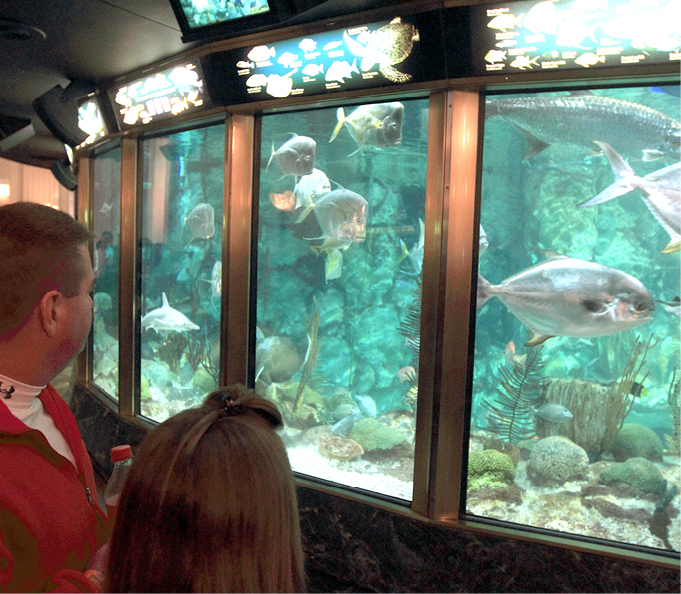
Inside the Caribbean Coral Reef exhibit at the John G. Shedd Aquarium.
You’ll pay extra to see the other Shedd highlights, but they’re quite impressive, so I’d suggest shelling out for them if you plan to spend more than an hour here. The Oceanarium ★★★, with a wall of windows revealing the lake outside, replicates a Pacific Northwest coastal environment and creates the illusion of one uninterrupted expanse of sea. On a fixed performance schedule in a large pool flanked by an amphitheater, a crew of friendly trainers puts dolphins through their paces of leaping dives, breaches, and tail walking (there’s an extra charge of $2 per person to see the show). If you’re visiting during a summer weekend, consider buying tickets in advance to make sure you can catch a show that day.
Wild Reef—Sharks at Shedd ★★ is a series of 26 connected habitats that house a Philippine coral reef patrolled by sharks and other predators. The floor-to-ceiling windows bring the toothy swimmers up close and personal (they even swim over your head at certain spots). And if you’re here with kids, you’ll want to stop by the Polar Play Zone, where little ones can pet a starfish, try on a penguin suit, or get a good look at the real thing—the Play Zone is home to a dozen rockhopper penguins.
Historic homes of Prairie Avenue
Prairie Avenue, south of the Loop, was the city’s first “Millionaire’s Row,” and its most famous address is Glessner House, 1800 S. Prairie Ave. ( 312/326-1480; www.glessnerhouse.org). A must-see for anyone interested in architectural history, and the only surviving Chicago building designed by Boston architect Henry Hobson Richardson, the 1886 structure represented a dramatic shift from traditional Victorian architecture (and inspired a young Frank Lloyd Wright).
312/326-1480; www.glessnerhouse.org). A must-see for anyone interested in architectural history, and the only surviving Chicago building designed by Boston architect Henry Hobson Richardson, the 1886 structure represented a dramatic shift from traditional Victorian architecture (and inspired a young Frank Lloyd Wright).
The imposing granite exterior gives the home a forbidding air. (Railway magnate George Pullman, who lived nearby, complained, “I do not know what I have ever done to have that thing staring me in the face every time I go out my door.”) But step inside, and the home turns out to be a welcoming, cozy retreat, filled with Arts and Crafts furnishings. Visits are by guided tour only; tours begin at 1 and 3pm Wednesday through Sunday (except major holidays) on a first-come, first-served basis (advance reservations are taken only for groups of 10 or more). Tours cost $10 for adults, $9 for students and seniors, and $6 for children 5 to 12.
A visit to Glessner House can also be combined with a tour of the nearby Clarke House Museum, a Greek Revival home that’s the oldest surviving house in the city; tours are given at noon and 2pm. Combination tickets for both Glessner House and Clarke House cost $15 for adults, $12 student and seniors, and $8 for children 5 to 12. Admission for all tours is free on Wednesday.
To get to Prairie Avenue, catch the no. 1, 3, or 4 bus from Michigan Avenue at Jackson Boulevard; get off at 18th Street and walk 2 blocks east.
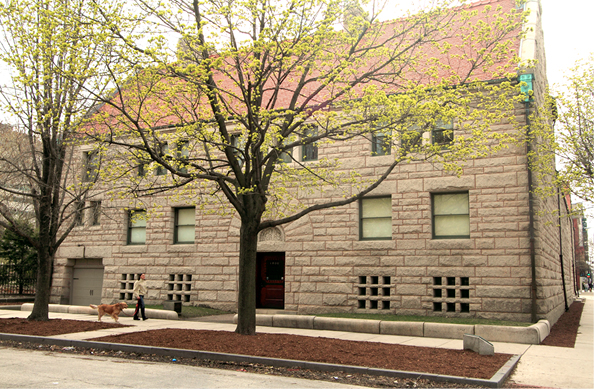
If you want a quality sit-down meal in a restaurant with a spectacular view of Lake Michigan, check out Soundings. There’s also a family-friendly cafeteria.
Allow 2 to 3 hours.
1200 S. Lake Shore Dr.  312/939-2438. www.sheddaquarium.org. Shedd Pass (for all exhibits) $29 adults, $20 seniors and children 3–11, free for children 2 and under; aquarium only $8 adults, $6 seniors and children. Free admission to aquarium only Mon–Tues mid-Sept to Oct and Jan–Feb. Memorial Day to Labor Day daily 9am–6pm; early Sept to late May Mon–Fri 9am–5pm, Sat–Sun 9am–6pm. Bus: 146.
312/939-2438. www.sheddaquarium.org. Shedd Pass (for all exhibits) $29 adults, $20 seniors and children 3–11, free for children 2 and under; aquarium only $8 adults, $6 seniors and children. Free admission to aquarium only Mon–Tues mid-Sept to Oct and Jan–Feb. Memorial Day to Labor Day daily 9am–6pm; early Sept to late May Mon–Fri 9am–5pm, Sat–Sun 9am–6pm. Bus: 146.
 A river Runs Through It
A river Runs Through It
The Chicago River remains one of the most visible of the city’s major physical features. It’s spanned by more movable bridges within the city limits (52 at last count) than any other city in the world. An almost-mystical moment occurs downtown when all the bridges spanning the main and south branches—connecting the Loop to both the Near West Side and the Near North Side—are raised, allowing for the passage of some ship, barge, or contingent of high-masted sailboats. The Chicago River has long outlived the critical commercial function that it once performed. Most of the remaining millworks that occupy its banks no longer depend on the river alone for the transport of their materials, raw and finished.
The river’s main function today is to serve as a fluvial conduit for sewage, which, owing to an engineering feat that reversed its flow inland in 1900, no longer pollutes the waters of Lake Michigan. Recently, Chicagoans have begun to discover other roles for the river, including water cruises, park areas, cafes, public art installations, and a riverside bike path that connects to the lakefront route near Wacker Drive. Actually, today’s developers aren’t the first to wonder why the river couldn’t be Chicago’s Seine. A look at the early-20th-century Beaux Arts balustrades lining the river along Wacker Drive, complete with comfortably spaced benches and Parisian-style bridge houses, shows that Chicago architect and urban planner Daniel Burnham knew full well what a treasure the city had.
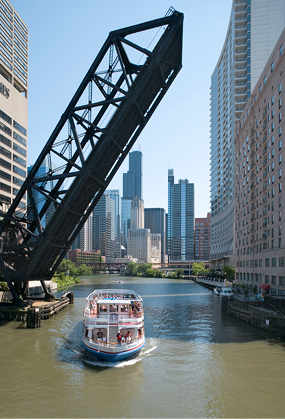
North of the Loop: The Magnificent Mile & Beyond
For a map of these attractions (or this neighborhood).
Most of these sights are either on the Magnificent Mile (North Michigan Ave.) and its surrounding blocks or close by on the Near North Side.
The Hancock Observatory ★ The Hancock may not be quite as famous as the Sears Tower, but the view from the city’s third-tallest building is as good as any in town. A high-speed elevator carries passengers to the observatory in 40 seconds, and on a clear day, you can see portions of the three states surrounding this corner of Illinois (Michigan, Indiana, and Wisconsin), for a radius of 40 to 50 miles. The view up the North Side is particularly dramatic, stretching from nearby Oak Street and North Avenue beaches, along the green strip of Lincoln Park, to the suburbs that trace the shoreline beyond. During your visit, you’re given a handheld PDA that delivers a “Sky Tour,” using audio and video to highlight features of interest across the skyline (kids get their own version). The Skywalk open-air viewing deck, surrounded on all sides by a safety screen, allows visitors to feel the rush of the wind at 1,000 feet. There’s also a cafe with an adjoining kids’ play area if you want to linger over a cappuccino and snack, and a complimentary concierge service. Allow 1 hour.
“Big John,” as some locals call the building, also has a restaurant, the Signature Room at the 95th, and a bar, the Signature Lounge. For about the same cost as the observatory, you can take in the views with a libation in hand.
94th floor, John Hancock Center, 875 N. Michigan Ave. (enter on Delaware St.).  888/875-VIEW (8439), or 312/751-3681. www.hancock-observatory.com. Admission $15 adults, $10 children 3–11, free for children 2 and under. Daily 9am–11pm. Bus: 145, 146, 147, or 151. Subway/El: Red Line to Chicago.
888/875-VIEW (8439), or 312/751-3681. www.hancock-observatory.com. Admission $15 adults, $10 children 3–11, free for children 2 and under. Daily 9am–11pm. Bus: 145, 146, 147, or 151. Subway/El: Red Line to Chicago.
 Rock Around the World
Rock Around the World
The impressive Gothic Tribune Tower, just north of the Chicago River on the east side of Michigan Avenue, is home to the Chicago Tribune newspaper. It’s also notable for an array of architectural fragments jutting out from the exterior. The newspaper’s notoriously despotic publisher, Robert R. McCormick, started the collection shortly after the building’s completion in 1925, gathering pieces during his world travels. Tribune correspondents then began supplying building fragments that they acquired on assignment. Each one now bears the name of the structure and the country from whence it came. There are 138 pieces in all, including chunks and shards from the Great Wall of China; the Taj Mahal; the White House; the Arc de Triomphe; the Berlin Wall; the Roman Colosseum; London’s Houses of Parliament; the Great Pyramid of Cheops in Giza, Egypt; and the original tomb of Abraham Lincoln in Springfield, Illinois.
Museum of Contemporary Art (MCA) ★★ The MCA’s gloomy, imposing building, designed by the German architect Josef Paul Kleihues, doesn’t offer a warm welcome, but the interior spaces are more appealing, with a bright, sun-drenched two-story central corridor, elliptical staircases, and three floors of exhibition space. Although the MCA is one of the largest contemporary art museums in the country, theaters and hallways seem to take up much of the space, making it relatively easy to see the whole collection, which emphasizes experimentation in a variety of media, including painting, sculpture, photography, video and film, and performance. Although you can see the main highlights in about an hour, art lovers will want more time to wander, especially if a high-profile exhibit is in town (the MCA has tried to raise its national profile to the level of New York’s Museum of Modern Art by booking major touring retrospectives of working artists such as Jeff Koons and Cindy Sherman).
Your first stop should be the handsome barrel-vaulted galleries on the top floor, dedicated to pieces from the permanent collection. Visitors who’d like a little guidance with making sense of the rather challenging works can rent an audio tour or take a free tour (1 and 6pm Tues; 1pm Wed–Fri; noon, 1, 2, and 3pm Sat–Sun). In addition to a range of special activities and educational programming, including films, performances, and a lecture series in a 300-seat theater, the museum features Puck’s at the MCA, a cafe operated by Wolfgang Puck of Spago restaurant fame, with seating that overlooks a 1-acre terraced sculpture garden. The store, with one-of-a-kind gift items, is worth a stop even if you don’t make it into the museum. The museum’s First Friday program, featuring after-hours performances, live music, and food and drink, takes place on the first Friday of every month. Allow 1 to 2 hours.
220 E. Chicago Ave. (1 block east of Michigan Ave.).  312/280-2660. www.mcachicago.org. Admission $12 adults, $7 seniors and students with ID, free for children 12 and under. Free admission Tues. Tues 10am–8pm; Wed–Sun 10am–5pm. Closed Jan 1, Thanksgiving, and Christmas. Bus: 3, 10, 66, 145, 146, or 151. Subway/El: Red Line to Chicago.
312/280-2660. www.mcachicago.org. Admission $12 adults, $7 seniors and students with ID, free for children 12 and under. Free admission Tues. Tues 10am–8pm; Wed–Sun 10am–5pm. Closed Jan 1, Thanksgiving, and Christmas. Bus: 3, 10, 66, 145, 146, or 151. Subway/El: Red Line to Chicago.

Elliptical staircases connect the Museum of Contemporary Art’s three floors of exhibition space.
Navy Pier ★  Built during World War I, this 3,000-foot-long pier served as a Navy training center for pilots during World War II. The military aura is long gone, and Navy Pier now thrives as a major tourist attraction, complete with carnival rides, a large food court, T-shirt shops, and boat rides. Whether or not you enjoy Navy Pier depends on your tolerance for crowds (especially in the summer), but even if you decide to bypass the souvenir stands, it’s worth walking to the very end, where you’ll be rewarded with great views of the city.
Built during World War I, this 3,000-foot-long pier served as a Navy training center for pilots during World War II. The military aura is long gone, and Navy Pier now thrives as a major tourist attraction, complete with carnival rides, a large food court, T-shirt shops, and boat rides. Whether or not you enjoy Navy Pier depends on your tolerance for crowds (especially in the summer), but even if you decide to bypass the souvenir stands, it’s worth walking to the very end, where you’ll be rewarded with great views of the city.
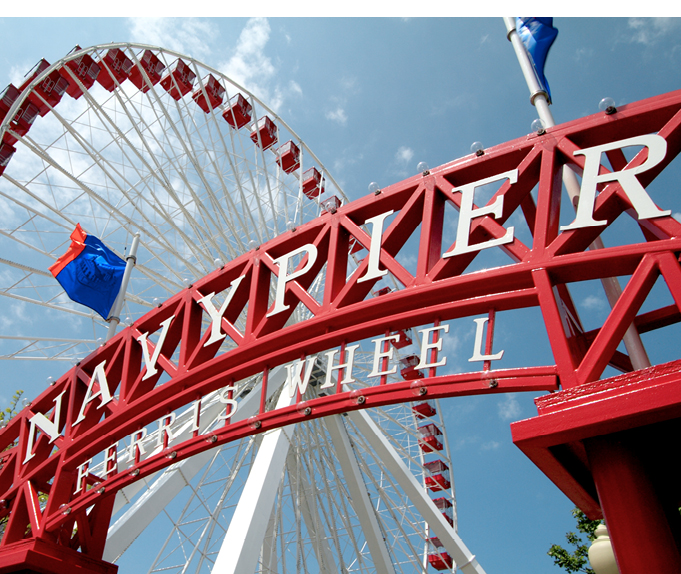
Navy Pier’s Ferris wheel is a replica of the one built for the 1893 World’s Fair.
 Free Fireworks!
Free Fireworks!
Yes, Navy Pier can be chaotic, crowded, and loud, but come summer, it’s also a prime gathering spot for visitors from around the world. From Memorial Day through Labor Day, the pier sponsors twice-weekly fireworks shows, where you can watch spectacular light displays reflected in the water of Lake Michigan below. It’s a great way to appreciate the city at night (along with a few thousand of your fellow travelers). The shows start at 9:30pm on Wednesday and 10:15pm on Saturday.
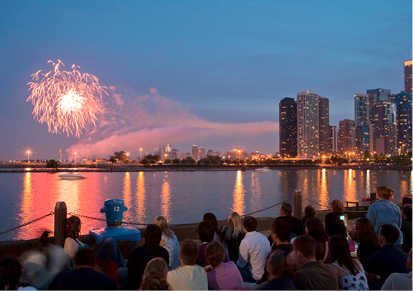
Midway down the pier are the Crystal Gardens ★, a lovely glass-enclosed atrium with 70 full-size palm trees, dancing fountains, and other flora; a carousel and kiddie carnival rides; and a 15-story Ferris wheel, a replica of the original that made its debut at Chicago’s 1893 World’s Fair. The pier is also home to the Chicago Children’s Museum, a 3-D IMAX theater (312/595-5629), a small ice-skating rink, and the Chicago Shakespeare Theatre. The shops tend to be bland and touristy, but there are a number of good dining options. They include the white-tablecloth seafood restaurant Riva; a beer garden with live music; and outposts of two popular local restaurants, Charlie’s Ale House, a casual pub with top-notch burgers, and the sports-themed Harry Caray’s Tavern. Summer is one long party at the pier, with fireworks on Wednesday and Saturday evenings.
The Smith Museum of Stained Glass Windows ★★ may sound dull, but decorative-art aficionados shouldn’t miss this remarkable installation of more than 150 stained-glass windows set in illuminated display cases. Occupying an 800-foot-long expanse on the ground floor of Navy Pier, the free museum features works by Frank Lloyd Wright, Louis Sullivan, John LaFarge, and Louis Comfort Tiffany.
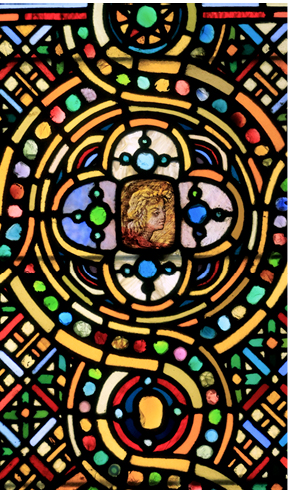
A Tiffany copy of a medieval window at the Smith Museum of Stained Glass Windows.
If the noise and commercialism get overwhelming, take the half-mile stroll to the end of the pier, where you can enjoy the wind, the waves, and the city view, which is the real delight of a place like this. Or unwind in Olive Park, a small sylvan haven with a sliver of beach just north of Navy Pier.
You’ll find more than half a dozen sailing vessels moored at the south dock, including a couple of dinner-cruise ships, the pristine white-masted tall ship Windy, and the 70-foot speedboats Seadog I, II, and III. In the summer months, water taxis speed between Navy Pier and other Chicago sights. For more specifics on sightseeing and dinner cruises, see “Lake & River Cruises”. Allow 1 hour.
600 E. Grand Ave. (at Lake Michigan).  800/595-PIER (7437; outside 312 area code), or 312/595-PIER [7437]. www.navypier.com. Free admission. Summer Sun–Thurs 10am–10pm, Fri–Sat 10am–midnight; fall–spring Mon–Thurs 10am–8pm, Fri–Sat 10am–10pm, Sun 10am–7pm. Parking: $20/day Mon–Thurs; $24/day Fri–Sun (lots fill quickly). Bus: 29, 65, 66, 120, or 121. Subway/El: Red Line to Grand; transfer to city bus no. 65 or board a free pier trolley bus.
800/595-PIER (7437; outside 312 area code), or 312/595-PIER [7437]. www.navypier.com. Free admission. Summer Sun–Thurs 10am–10pm, Fri–Sat 10am–midnight; fall–spring Mon–Thurs 10am–8pm, Fri–Sat 10am–10pm, Sun 10am–7pm. Parking: $20/day Mon–Thurs; $24/day Fri–Sun (lots fill quickly). Bus: 29, 65, 66, 120, or 121. Subway/El: Red Line to Grand; transfer to city bus no. 65 or board a free pier trolley bus.
Newberry Library The Newberry Library, housed in a stately five-story granite building, is a bibliophile’s dream. Established in 1887, thanks to a bequest by Chicago merchant and financier Walter Loomis Newberry, the noncirculating research library contains many rare books and manuscripts (such as Shakespeare’s first folio and Jefferson’s copy of The Federalist Papers). The library is also a major destination for genealogists digging at their roots, with holdings that are free to the public (over the age of 16 with a photo ID). The collections include more than 1.5 million volumes and 75,000 maps, many of which are on display during an ongoing series of public exhibitions. For an overview, take a free 1-hour tour Thursday at 3pm or Saturday at 10:30am. The Newberry operates a fine bookstore and also sponsors a series of concerts (including those by its resident early music ensemble, the Newberry Consort), lectures, and children’s story hours throughout the year. One popular annual event is the Bughouse Square debates ★. Held across the street in Washington Square Park in late July, the debates re-create the fiery soapbox orations of the left-wing agitators in the 1930s and 1940s. Allow a half-hour.
60 W. Walton St. (at Dearborn Pkwy.).  312/943-9090, or 312/255-3700 for programs. www.newberry.org. Reading room Tues–Fri 9am–5pm; Sat 9am–1pm. Exhibit gallery Mon, Fri, and Sat 8:15am–5pm; Tues–Thurs 8:15am–7:30pm. Bus: 22, 36, 125, 145, 146, 147, or 151. Subway/El: Red Line to Chicago.
312/943-9090, or 312/255-3700 for programs. www.newberry.org. Reading room Tues–Fri 9am–5pm; Sat 9am–1pm. Exhibit gallery Mon, Fri, and Sat 8:15am–5pm; Tues–Thurs 8:15am–7:30pm. Bus: 22, 36, 125, 145, 146, 147, or 151. Subway/El: Red Line to Chicago.
What to See & Do in Lincoln Park
For a map of these attractions (or this neighborhood).

Augustus Saint-Gaudens’s statue of the standing Abraham Lincoln.
Lincoln Park is the city’s largest park, and certainly one of the longest. Straight and narrow, the park begins at North Avenue and follows the shoreline of Lake Michigan north for several miles. Within its 1,200 acres are a world-class zoo; half a dozen beaches; a botanical conservatory; two excellent museums; a golf course; and the meadows, formal gardens, sporting fields, and tennis courts typical of urban parks. To get to the park, take bus no. 22, 145, 146, 147, 151, or 156.
The park, named after Abraham Lincoln, is home to the statue of the standing Abraham Lincoln (just north of the North Ave. and State St. intersection), one of the city’s two Lincoln statues by Augustus Saint-Gaudens (the seated Lincoln is in Grant Park). Saint-Gaudens also designed the Bates Fountain near the conservatory.
Cafe Brauer This landmark 1900 building is not technically open to the public, aside from a restaurant on the ground floor. (The lovely second-floor Great Hall, flanked by two curving loggias, is one of the city’s most popular wedding reception spots; if you stop by on a weekend, chances are, you can sneak a peek while the caterers are setting up.) Even if you don’t make it inside, Cafe Brauer is a nice stopping-off point during a walk around the park. Best of all, though, is the picture-postcard view from the adjacent bridge spanning the pond of the John Hancock Center and neighboring skyscrapers beyond Lincoln Park’s treetops. Allow a quarter-hour.
2021 Stockton Dr.  312/742-2400. Daily 10am–5pm. Bus: 151 or 156.
312/742-2400. Daily 10am–5pm. Bus: 151 or 156.

Sit and relax at the Park Place Cafe, next to Cafe Brauer.
Chicago History Museum ★★, which fills the museum’s second floor. A survey of the city’s history—from it s founding as a frontier trading post to the riots at the 1968 Democratic Convention—it’s filled with photos, artifacts, and newsreels that make the past come alive; surrounding galleries track the development of local sports teams, architecture, music, and art. Although the exhibit is geared toward families with older children (you can even download an MP3 audio tour for teenagers from the museum’s website), little ones love the re-creation of an 1890s El station, where they can run inside the city’s first elevated train. The Children’s Gallery on the ground floor has interactive exhibits for kids, including a giant table where you can experience the “Smells of Chicago” (both good and bad!).
Another museum highlight is the hall of dioramas that re-create scenes from Chicago’s past. Although they’ve been around for decades (and are decidedly low-tech), they’re a fun way to trace the city’s progression from a few small cabins to the grand World’s Columbian Exposition of 1893. The museum’s Costume and Textile Gallery showcases pieces from the museum’s renowned collection of historic clothing; recent exhibitions included couture gowns by French designer Christian Dior and a survey of American quilts.
There’s a small cafe with sandwiches and salads that makes a convenient lunch stop. The History Museum also presents a wide range of lectures, seminars, and tours, including walking tours of the surrounding neighborhood; check the museum’s website for details, as the schedules change frequently. Allow 1 to 2 hours.
1601 N. Clark St. (at North Ave.).  312/642-4600. www.chicagohistory.org. Admission $14 adults, $12 seniors and students, free for children 12 and under. Mon–Sat 9:30am–4:30pm; Sun noon–5pm. Bus: 11, 22, 36, 72, 151, or 156.
312/642-4600. www.chicagohistory.org. Admission $14 adults, $12 seniors and students, free for children 12 and under. Mon–Sat 9:30am–4:30pm; Sun noon–5pm. Bus: 11, 22, 36, 72, 151, or 156.

Inside the Chicago History Museum.
Lincoln Park Conservatory ★ Just beyond the zoo’s northeast border is a lovely botanical garden housed in a soaring glass-domed structure. Inside are four great halls filled with thousands of plants. If you’re visiting Chicago in the wintertime, this lush haven of greenery provides a welcome respite from the snow and ice outside. The Palm House features giant palms and rubber trees (including a 50-ft. fiddle-leaf rubber tree dating back to 1891); the Fernery nurtures plants that grow close to the forest floor; and the Tropical House is a shiny symphony of flowering trees, vines, and bamboo. The fourth environment is the Show House, where seasonal flower shows take place.
Even better than the plants inside, however, might be what lies outside the front doors. The expansive lawn, with its French garden and lovely fountain on the conservatory’s south side, is one of the best places in town for an informal picnic (especially nice if you’re visiting the zoo and want to avoid the congestion at its food concession venues).
The Lincoln Park Conservatory has a sister facility on the city’s West Side, in Garfield Park, that is even more impressive. In fact, the 2-acre Garfield Park Conservatory, 300 N. Central Park Ave. (312/746-5100), designed by the great landscape architect Jens Jensen in 1907, is one of the largest gardens under glass in the world. Unfortunately, it’s surrounded by a pretty rough neighborhood with a high crime rate, so it’s best to visit if you have a car, rather than using public transportation to get there. It’s open 365 days a year from 9am to 5pm.
Allow a half-hour for the Lincoln Park Conservatory.
Fullerton Ave. (at Stockton Dr.).  312/742-7736. Free admission. Daily 9am–5pm. Bus: 73, 151, or 156.
312/742-7736. Free admission. Daily 9am–5pm. Bus: 73, 151, or 156.

The Lincoln Park Conservatory’s expansive lawn is the perfect place for a picnic.
Lincoln Park Zoo ★★★  One of the city’s treasures, this family-friendly attraction is not only open every day of the year, but it’s also free. Even if you don’t have time for a complete tour of the various habitats, it’s worth at least a quick stop during a stroll through Lincoln Park. The term zoological gardens truly fits here: Landmark Georgian Revival brick buildings and modern structures sit among gently rolling pathways, verdant lawns, and a kaleidoscopic profusion of flower gardens. The late Marlon Perkins, legendary host of the Mutual of Omaha’s Wild Kingdom TV series, got his start here as the zoo’s director and filmed a pioneering TV show called Zoo Parade (Wild Kingdom’s predecessor) in the basement of the old Reptile House.
One of the city’s treasures, this family-friendly attraction is not only open every day of the year, but it’s also free. Even if you don’t have time for a complete tour of the various habitats, it’s worth at least a quick stop during a stroll through Lincoln Park. The term zoological gardens truly fits here: Landmark Georgian Revival brick buildings and modern structures sit among gently rolling pathways, verdant lawns, and a kaleidoscopic profusion of flower gardens. The late Marlon Perkins, legendary host of the Mutual of Omaha’s Wild Kingdom TV series, got his start here as the zoo’s director and filmed a pioneering TV show called Zoo Parade (Wild Kingdom’s predecessor) in the basement of the old Reptile House.
The Regenstein African Journey ★★★, a series of linked indoor and outdoor habitats that’s home to giraffes, rhinos, and other large mammals, shouldn’t be missed. Large glass-enclosed tanks allow visitors to go face-to-face with swimming pygmy hippos, meerkats, colobus monkeys, and other exotic species, including (not for the faint of heart) a rocky ledge filled with Madagascar hissing cockroaches.
Your second stop should be the Regenstein Center for African Apes ★★. Lincoln Park Zoo has had remarkable success breeding gorillas and chimpanzees, and watching these ape families interact can be mesmerizing (and touching). One caveat: The building can get incredibly noisy when it’s crowded, so be prepared.
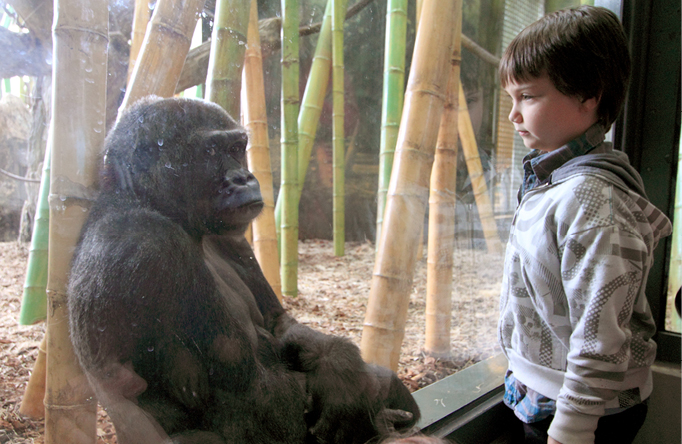
The Regenstein Center for African Apes at the Lincoln Park Zoo.
Other exhibits worth a visit are the Small Mammal–Reptile House, which features a glass-enclosed walk-through ecosystem simulating river, savanna, and forest habitats; and the popular Sea Lion Pool in the center of the zoo, which is home to harbor seals, gray seals, and California sea lions (walk down the ramp and take a look at the underwater viewing area). The zoo’s large carousel features beautifully rendered figures of endangered species. If you’re here for a while and need nourishment, there’s an indoor food court, as well as the Big Cats Café, located on a terrace above the gift shop. Allow 3 hours. For the adjoining children’s zoo, see “Kid Stuff”.
2200 N. Cannon Dr. (at Fullerton Pkwy.).  312/742-2000. www.lpzoo.com. Free admission. Buildings daily 10am–5pm (Memorial Day to Labor Day until 6:30pm Sat–Sun). Grounds Memorial Day to Labor Day daily 9am–7pm; Apr to late May and early Sept to Oct daily 9am–6pm; Nov–Mar daily 9am–5pm. Parking $17 for up to 3 hr. in on-site lot. Bus: 22, 36, 151, or 156.
312/742-2000. www.lpzoo.com. Free admission. Buildings daily 10am–5pm (Memorial Day to Labor Day until 6:30pm Sat–Sun). Grounds Memorial Day to Labor Day daily 9am–7pm; Apr to late May and early Sept to Oct daily 9am–6pm; Nov–Mar daily 9am–5pm. Parking $17 for up to 3 hr. in on-site lot. Bus: 22, 36, 151, or 156.
Peggy Notebaert Nature Museum ★  Built into a slope that was once the site of an ancient sand dune—and part of the shoreline of Lake Michigan—this museum bills itself as “an environmental museum for the 21st century.” Many of the exhibits are hands-on and designed for kids, making this a good stop for families.
Built into a slope that was once the site of an ancient sand dune—and part of the shoreline of Lake Michigan—this museum bills itself as “an environmental museum for the 21st century.” Many of the exhibits are hands-on and designed for kids, making this a good stop for families.
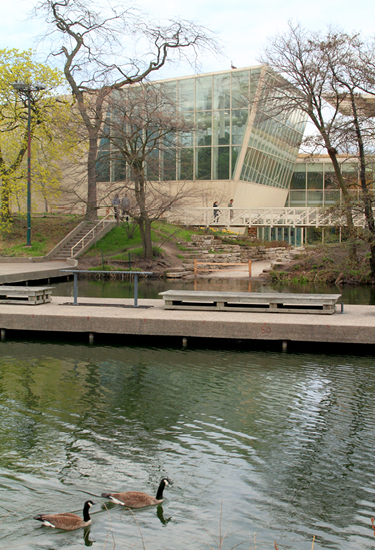
The uniquely designed Peggy Notebaert Nature Museum resembles a sand dune.
Shaded by huge cottonwoods and maples, the sand-colored exterior, with its horizontal lines composed of interlocking trapezoids, resembles a sand dune. Rooftop-level walkways give strollers a view of birds and other urban wildlife below, and paths wind through gardens planted with native Midwestern wildflowers and grasses. Inside, large windows create a dialogue between the outdoor environment and the indoor exhibits designed to illuminate it. The museums’ best known exhibit is the Butterfly Haven ★, a bungalow where kids can play while learning how they can be environmentally friendly, and RiverWorks, a water play exhibit that gives children an excuse to splash around while building dams and maneuvering boats along a mini river. Allow 1 to 2 hours.
Fullerton Ave. and Cannon Dr.  773/755-5100. www.chias.org. Admission $9 adults, $7 seniors and students, $6 children 3–12, free for children 2 and under. Free admission Thurs. Mon–Fri 9am–5pm; Sat–Sun 10am–5pm. Closed Jan 1, Thanksgiving, and Christmas. Bus: 22, 36, 151, or 156.
773/755-5100. www.chias.org. Admission $9 adults, $7 seniors and students, $6 children 3–12, free for children 2 and under. Free admission Thurs. Mon–Fri 9am–5pm; Sat–Sun 10am–5pm. Closed Jan 1, Thanksgiving, and Christmas. Bus: 22, 36, 151, or 156.
Exploring Hyde Park
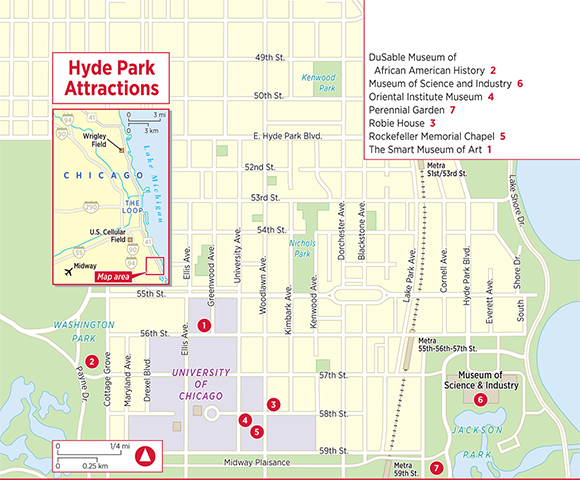
Hyde Park, south of the Loop, is the birthplace of atomic fission, home to the University of Chicago and the popular Museum of Science and Industry, and definitely worth a trip. It’s gotten an added boost of publicity ever since a certain former resident, Barack Obama, came to national prominence. The Obamas are such fans of the area that they’ve kept their house here. (For more about the Obama connection, see “Obama’s Chicago” in chapter 2.) Allow at least half a day to explore the University of Chicago campus and surrounding neighborhood (one of Chicago’s most successfully integrated). If you want to explore a museum or two as well, plan on a full day.
Some Hyde Park History When Hyde Park was settled in 1850, it became Chicago’s first suburb. A hundred years later, in the 1950s, it added another first to its impressive résumé, one that the current neighborhood is not particularly proud of: an urban-renewal plan. At the time, a certain amount of old commercial and housing stock—just the kind of buildings that would be prized today—was demolished rather than rehabilitated and replaced by projects and small shopping malls that actually make some corners of Hyde Park look more like a post–World War II suburb than an urban neighborhood.
What Hyde Park can be proud of is that, in racially divided Chicago, this neighborhood has found an alternative vision. As Southern blacks began to migrate to Chicago’s South Side during World War I, many whites fled. But most whites here, especially those who wanted to stay near the university, chose integration as the only realistic strategy to preserve their neighborhood. The 2000 census proved that integration still works: About 40% of the residents are white and 37% are black; there is also a significant Asian population. Hyde Park is decidedly middle class, with pockets of affluence that reflect the early-20th-century period when the well-to-do moved here to escape the decline of Prairie Avenue. A well-known black resident from the area is the late Elijah Muhammad, and numerous Nation of Islam families continue to worship in a mosque, formerly a Greek Orthodox cathedral, that is one of the neighborhood’s architectural landmarks. Surrounding this unusual enclave, however, are many marginal blocks where poverty and slum housing abound. For all its nobility, Hyde Park’s achievement in integration merely emphasizes that socioeconomic differences are even more unwieldy than racial ones.
The University of Chicago is widely hailed as one of the more intellectually exciting institutions of higher learning in the country and has been home to some 73 Nobel laureates, including physicist Enrico Fermi, novelist Saul Bellow, and economist Milton Friedman. (Almost one-third of all the Nobel Prizes in Economics have gone to University of Chicago professors, twice as many as any other institution.) Another long-time faculty member was English professor Norman Maclean, author of A River Runs Through It. Though they may joke about the school’s staid social life, U of C undergrads take pride in their school’s nerdy reputation.
The year the university opened its doors in 1892 was a big one for Hyde Park, but 1893 was even bigger. In that year, Chicago, chosen over other cities in a competitive international field, played host to the World’s Columbian Exposition, commemorating the 400th anniversary of Columbus’s arrival in America. To create a fairground, the landscape architect Frederick Law Olmsted was enlisted to fill in the marshlands along
Hyde Park’s lakefront and link what was to become Jackson Park to existing Washington Park on the neighborhood’s western boundary with a narrow concourse called the Midway Plaisance. On the resulting 650 acres—at a cost of $30 million—12 exhibit palaces, 57 buildings devoted to U.S. states and foreign governments, and dozens of smaller structures were constructed under the supervision of architect Daniel Burnham. Most of the buildings followed Burnham’s preference for the Classical Revival style and white stucco exteriors. With the innovation of outdoor electric lighting, the sparkling result was the “White City,” which attracted 27 million visitors in a single season, from May 1 to October 31, 1893. The exposition sponsors, in that brief time, had remarkably recovered their investment, but within a few short years of the fair’s closing, vandalism and fire destroyed most of its buildings. Only the Palace of Fine Arts, occupying the eastern tip of the midway, survives to this day, and it now houses the Museum of Science and Industry. (For more on the behind-the-scenes drama at the Exposition, read The Devil in the White City, by Erik Larson, a nonfiction history book that reads like a thriller.)
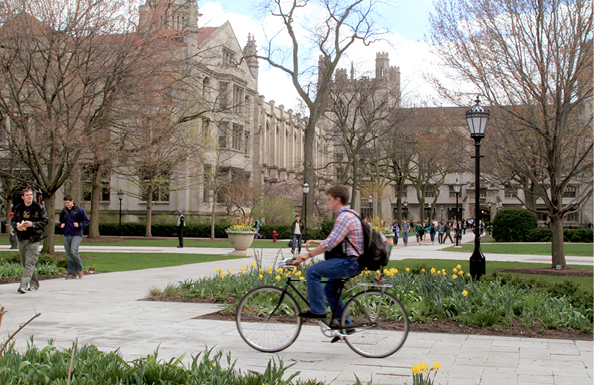
The University of Chicago.
Getting There From the Loop, the ride to Hyde Park on the no. 6 Jeffrey Express bus takes about 30 minutes. The bus originates on Wacker Drive, travels south along State Street, and ultimately follows Lake Shore Drive to Hyde Park. The bus runs daily from early morning to late evening, with departures about every 5 minutes on weekdays and every 10 minutes on weekends and holidays. The southbound express bus fare adds a surcharge of 25¢ to the normal fare of $2.25 (there’s no surcharge if you use a CTA transit card). The no. 1 local bus originates at Union Station on Jackson Boulevard and Canal Street and takes about an hour.
For a faster trip, take the Metra Electric train on the South Chicago line, which goes from downtown to Hyde Park in about 15 minutes. Trains run every hour (more frequently during rush hour) Monday through Saturday from 5:15am to 12:50am, and every 30 to 90 minutes on Sunday and holidays from 5am to 12:55am. Downtown stations are at Randolph Street and Michigan Avenue, Van Buren Street and Michigan Avenue, and Roosevelt Road and Michigan Avenue (near the Museum Campus in Grant Park). Printed schedules are available at the stations. The fare is approximately $2.50 each way.
For CTA bus and Metra train information, call 312/836-7000, or visit www.transitchicago.com or www.metrarail.com.
For taxis, dial 312/TAXI-CAB (829-4222) for Yellow Cab or 312/CHECKER (243-2537) for Checker. The one-way fare from downtown is around $15 to $20.
A Suggested Itinerary A long 1-day itinerary for Hyde Park should include the following: a walk through the University of Chicago campus (including a stroll along the Midway Plaisance); a visit to the Museum of Science and Industry (for families), Frank Lloyd Wright’s Robie House, or one of the other local museums; and lunch or dinner in the neighborhood’s commercial center.
 Hyde Park Bites
Hyde Park Bites
When you’re ready to take a break, Hyde Park has an eclectic selection of restaurants. As in any university town, you’ll find plenty of affordable, student-friendly hangouts. The most famous University of Chicago gathering spot is Jimmy’s Woodlawn Tap, 1172 E. 55th St. ( 773/643-5516). This 50-year-old bar and grill doesn’t offer much in the way of atmosphere, but the hamburgers and sandwiches are cheap, and the person sitting next to you might just be a Nobel Prize–winning professor. Another casual spot near campus is Medici, 1327 E. 57th St. (
773/643-5516). This 50-year-old bar and grill doesn’t offer much in the way of atmosphere, but the hamburgers and sandwiches are cheap, and the person sitting next to you might just be a Nobel Prize–winning professor. Another casual spot near campus is Medici, 1327 E. 57th St. ( 773/667-7394; www.medici57.com), where a few generations’ worth of students have carved their names into the tables while chowing down on pizza, the house specialty. About a block from the main Hyde Park Metra station you’ll find La Petite Folie, 1504 E. 55th St. (
773/667-7394; www.medici57.com), where a few generations’ worth of students have carved their names into the tables while chowing down on pizza, the house specialty. About a block from the main Hyde Park Metra station you’ll find La Petite Folie, 1504 E. 55th St. ( 773/493-1394; www.lapetitefolie.com), a French bistro that offers a refined escape from student life.
773/493-1394; www.lapetitefolie.com), a French bistro that offers a refined escape from student life.
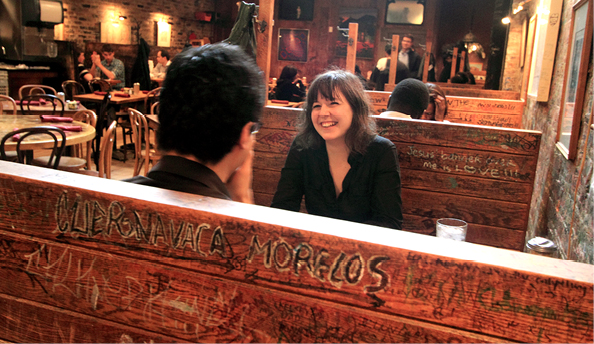
The Top Attractions
DuSable Museum of African-American History The DuSable Museum is a repository of the history, art, and artifacts pertaining to the African-American experience and culture. Named for Chicago’s first permanent settler, Jean Baptiste Point du Sable, a French-Canadian of Haitian descent, it was founded in 1961 in the home of Dr. Margaret Burroughs, an art teacher at the city’s DuSable High School. In 1973, as a result of a community-based campaign, the museum took up residence in its present building (a former parks administration facility and police lockup), on the eastern edge of Washington Park. Despite beginning with no major endowment, the DuSable Museum has managed to accumulate a wide range of artifacts, including an excellent collection of paintings, drawings, and sculpture by African-American and African artists.
In 1993, the DuSable Museum added a 25,000-square-foot wing named in honor of the city’s first and only African-American mayor, Harold Washington. The permanent exhibit on Washington contains memorabilia and personal effects, and surveys important episodes in his political career. Other recent exhibits have included “Red, White, Blue and Black,” an examination and celebration of the African-American experience in the armed forces, as well as showings of African art. The museum also has a gift shop, a research library, and an extensive program of community-related events, such as a jazz and blues music series, poetry readings, film screenings, and other cultural events, all presented in a 466-seat auditorium. Allow 1 to 2 hours.
740 E. 56th Place.  773/947-0600. www.dusablemuseum.org. Admission $10 adults, $6 students and seniors, $3 children 6–11, free for children 5 and under. Free admission Sun. Tues–Sat 10am–5pm; Sun noon–5pm. Closed major holidays. Bus: 6 or Metra Electric train to 57th St. and Lake Park Ave., and then a short cab ride.
773/947-0600. www.dusablemuseum.org. Admission $10 adults, $6 students and seniors, $3 children 6–11, free for children 5 and under. Free admission Sun. Tues–Sat 10am–5pm; Sun noon–5pm. Closed major holidays. Bus: 6 or Metra Electric train to 57th St. and Lake Park Ave., and then a short cab ride.
Museum of Science and Industry ★★  Even if you don’t plan on spending the day in Hyde Park, you’ll likely pass through the neighborhood on your way to one of Chicago’s most popular tourist attractions. The massive Museum of Science and Industry is the granddaddy of interactive museums, with some 2,000 exhibits. Schedule at least 3 hours here; a comprehensive visit can take all day, especially if you catch an OMNIMAX movie.
Even if you don’t plan on spending the day in Hyde Park, you’ll likely pass through the neighborhood on your way to one of Chicago’s most popular tourist attractions. The massive Museum of Science and Industry is the granddaddy of interactive museums, with some 2,000 exhibits. Schedule at least 3 hours here; a comprehensive visit can take all day, especially if you catch an OMNIMAX movie.
While the museum is constantly adding new displays to cover the latest scientific breakthroughs, you shouldn’t miss certain tried-and-true exhibits that have been here for years and epitomize the museum for Chicagoans. The U-505 ★★, which dates back to 1934, incorporates modern mining techniques into the exhibit—but the best part is the simulated trip down into a dark, mysterious mine and the clattering mini-trains that transport you through the shadowy tunnels. Get to these exhibits quickly after the museum opens because they attract amusement-park-length lines during the day, with waits for the Coal Mine sometimes running up to an hour.
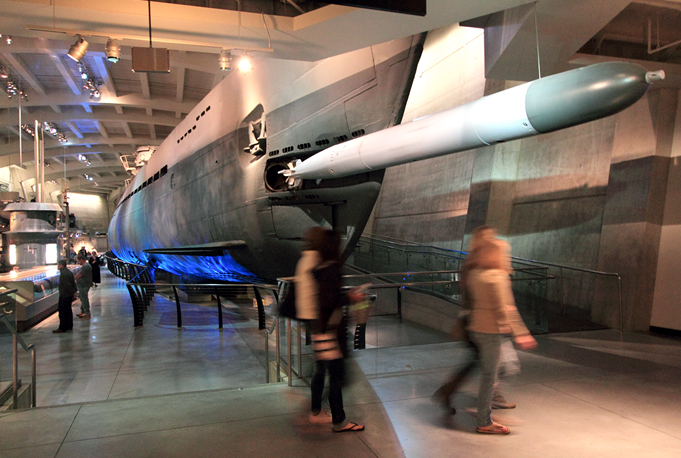
The U-505, a German submarine displayed in the Museum of Science and Industry.
Kids who love planes, trains, and automobiles shouldn’t miss All Aboard the Silver Streak, a refurbished Burlington Pioneer Zephyr train with onboard interactive exhibits; the massive model-train exhibit that makes up The Great Train Story ★, you create an avatar who guides you through the technology that makes the Internet possible. More low-tech—but fun for kids—are The Farm (where children can sit at the wheel of a giant combine) and the chick hatchery inside the exhibit Genetics: Decoding Life, where you can watch as tiny newborn chicks poke their way out of eggs. Enterprise ★ immerses mini-capitalists in the goings-on of a virtual company and includes an entire automated toy-making assembly line. If you have really little ones (under age 5), head for the Idea Factory, which is filled with hands-on play equipment (admission is limited to a set number of kids, so pick up a free timed ticket in advance).

The Great Train Story, a massive model train exhibit.
Girly girls will love Colleen Moore’s Fairy Castle ★★, a lavishly decorated miniature palace filled with priceless treasures (yes, those are real diamonds and pearls in the chandeliers). It’s hidden on the lower level, but worth the effort. Also tucked away in an inconspicuous spot—along the Blue stairwell between the Main Floor and the Balcony—are the Human Body Slices, actual slivers of human cadavers that are guaranteed to impress teenagers in search of something truly gross.
The Henry Crown Space Center ★★ is a museum-within-the-museum that documents the story of space exploration in copious detail, highlighted by a simulated space-shuttle experience through sight and sound at the center’s five-story OMNIMAX Theater. The theater offers double features on the weekends; call for show times.
When you’ve worked up an appetite, you can visit the museum’s large food court or the old-fashioned ice-cream parlor; there’s also an excellent gift shop.
Although it’s quite a distance from the rest of Chicago’s tourist attractions, the museum is easy enough to reach without a car. During the summer, the no. 10 bus runs from downtown to the museum’s front entrance; you can find a route map and schedule on the museum’s website. At other times of the year, your best options are the no. 6 Jeffrey Express bus and the Metra Electric train.
57th St. and Lake Shore Dr.  800/468-6674 outside the Chicago area, 773/684-1414, or TTY 773/684-3323. www.msichicago.org. Admission to museum only: $15 adults, $14 seniors, $10 children 3–11, free for children 2 and under. Free admission weekdays in Jan. Memorial Day to Labor Day daily 9:30am–5:30pm; early Sept to late May daily 9:30am–4pm. Closed Christmas. Bus: 6 or Metra Electric train to 57th St. and Lake Park Ave.
800/468-6674 outside the Chicago area, 773/684-1414, or TTY 773/684-3323. www.msichicago.org. Admission to museum only: $15 adults, $14 seniors, $10 children 3–11, free for children 2 and under. Free admission weekdays in Jan. Memorial Day to Labor Day daily 9:30am–5:30pm; early Sept to late May daily 9:30am–4pm. Closed Christmas. Bus: 6 or Metra Electric train to 57th St. and Lake Park Ave.
Oriental Institute Museum ★ Near the midpoint of University of Chicago’s campus, the Oriental Institute houses one of the world’s major collections of Near Eastern art. Although most of the galleries have been renovated within the last few years, this is still a very traditional museum: lots of glass cases and very few interactive exhibits (in other words, there’s not much to interest young children). A few impressive pieces make it worth at least a brief stop, although history and art buffs should allow more time to linger.
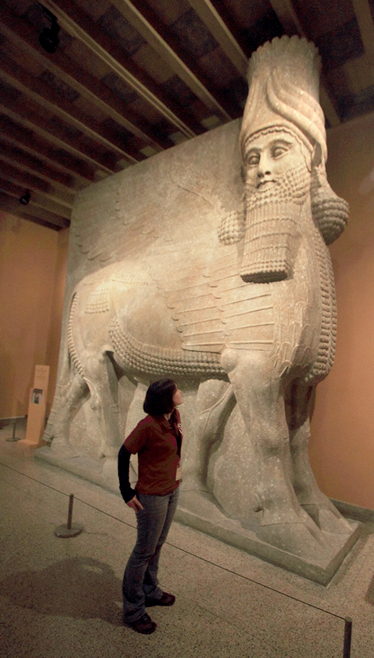
This 16-foot sculpture, displayed at the Oriental Institute Museum, once stood in the palace of Assyrian King Sargon II.
Your first stop should be the Egyptian Gallery ★★, which showcases the finest objects among the museum’s 35,000 Egyptian artifacts. At the center stands a monumental 17-foot solid-quartzite statue of the boy king Tutankhamen; the largest Egyptian sculpture in the Western Hemisphere, it tips the scales at 6 tons. The surrounding exhibits have a wonderfully accessible approach that emphasizes themes, not chronology. Among them are mummification (there are 14 mummies on display, 5 people and 9 animals), kingship, society, and writing (including a deed for the sale of a house, a copy of the Book of the Dead, and a schoolboy’s homework).
The Oriental Institute also houses important collections of artifacts from civilizations that once flourished in what are now Iran and Iraq. The highlight of the Mesopotamian Gallery ★ is a massive 16-foot-tall sculpture of a winged bull with a human head, which once stood in the palace of Assyrian king Sargon II. The gallery also contains some of the earliest man-made tools ever excavated, along with many other pieces that have become one-of-a-kind since the destruction and looting of the National Museum in Baghdad in 2003. Allow 1 hour.
1155 E. 58th St. (at University Ave.).  773/702-9514. www.oi.uchicago.edu. Free admission; suggested donation $7 adults, $4 children. Tues–Sat 10am–6pm (Wed until 8:30pm); Sun noon–6pm. Closed major holidays. Bus: 6 or Metra Electric train to 57th St. and Lake Park Ave.
773/702-9514. www.oi.uchicago.edu. Free admission; suggested donation $7 adults, $4 children. Tues–Sat 10am–6pm (Wed until 8:30pm); Sun noon–6pm. Closed major holidays. Bus: 6 or Metra Electric train to 57th St. and Lake Park Ave.
Robie House ★★ For architectural history buffs, Robie House is a must-see. Frank Lloyd Wright designed this 20th-century American architectural masterpiece for Frederick Robie, a bicycle and motorcycle manufacturer. The home, which was completed in 1909, is a classic example of Wright’s Prairie School of design, with its open layout and linear geometry of form. Wright prided himself on creating all-encompassing, stylistically harmonious environments, and he oversaw everything from the furniture to the exquisite leaded- and stained-glass doors and windows. It was among the last of Wright’s Prairie School–style homes: During its construction, he abandoned both his family and his Oak Park practice to follow other pursuits, most prominently the realization of his Taliesin home and studio in Spring Green, Wisconsin. Docents from Oak Park’s Frank Lloyd Wright Home and Studio Foundation lead 1-hour tours of the interior, and after a massive, 10-year restoration in honor of the house’s 100th anniversary, it looks better than ever. Note: Advance reservations are a good idea in the summer.
A Wright specialty bookshop is in the building’s former three-car garage—which was highly unusual for the time in which it was built. Advance reservations are recommended in the summer; you can order tickets through Robie House’s website. Allow 1 hour per tour, plus time to browse the gift shop.
5757 S. Woodlawn Ave. (at 58th St.).  773/834-1847. www.gowright.org/visit/robie-house.html. Admission $15 adults, $12 seniors and children 4–17, free for children 3 and under. Thurs–Mon tours at 11am, noon, 1, and 2pm. Bookshop daily 10am–5pm. Bus: 6 or Metra Electric train to 57th St. and Lake Park Ave.
773/834-1847. www.gowright.org/visit/robie-house.html. Admission $15 adults, $12 seniors and children 4–17, free for children 3 and under. Thurs–Mon tours at 11am, noon, 1, and 2pm. Bookshop daily 10am–5pm. Bus: 6 or Metra Electric train to 57th St. and Lake Park Ave.
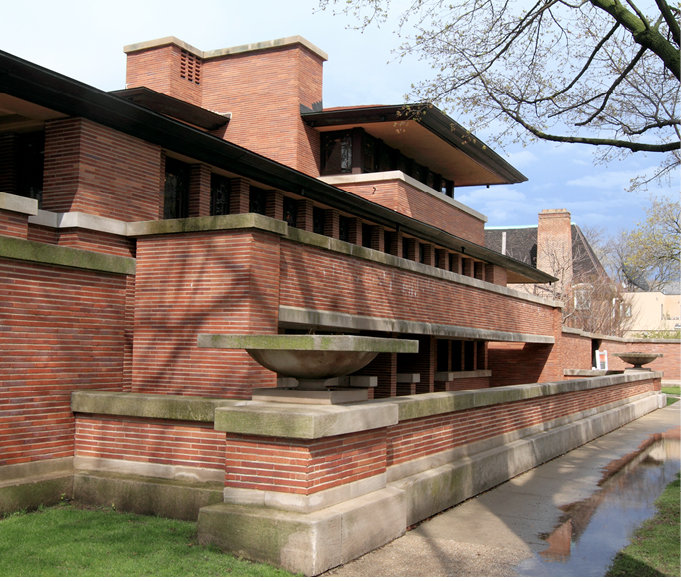
The Robie House is a classic example of Frank Lloyd Wright’s Prairie School of design.
Rockefeller Memorial Chapel To call the Rockefeller Memorial Chapel a chapel is false modesty, even for a Rockefeller. When the university first opened its doors, the students sang the following ditty:
John D. Rockefeller, wonderful man is he
Gives all his spare change to the U of C.
John D. was a generous patron, indeed. He founded the university (in cooperation with the American Baptist Society), built the magnificent mini-cathedral that now bears his name, and shelled out an additional $35 million in donations over the course of his lifetime. Memorial Chapel, designed by Bertram Goodhue, an architect known for his ecclesiastical buildings—including the Cadet Chapel at West Point and New York City’s St. Thomas Church—was dedicated in 1928.
In keeping with the rest of the campus, which is patterned after Oxford, the chapel is reminiscent of English Gothic structures; however, it was built from limestone using modern construction techniques. Its most outstanding features are the circular stained-glass window high above the main altar (the windows, in general, are among the largest of any church or cathedral anywhere) and the world’s second-largest carillon, which John D. Rockefeller, Jr., donated in 1932 in memory of his mother, Laura. The chapel’s organ is nearly as impressive, with four manuals, 126 stops, and more than 10,000 pipes. Choir concerts, carillon performances, and other musical programs run throughout the year, usually for a small donation. Allow a half-hour.
5850 S. Woodlawn Ave.  773/702-2100. http://rockefeller.uchicago.edu. Free admission. Daily 8am–4pm (except during religious services). Bus: 6 or Metra Electric train to 57th St. and Lake Park Ave.
773/702-2100. http://rockefeller.uchicago.edu. Free admission. Daily 8am–4pm (except during religious services). Bus: 6 or Metra Electric train to 57th St. and Lake Park Ave.
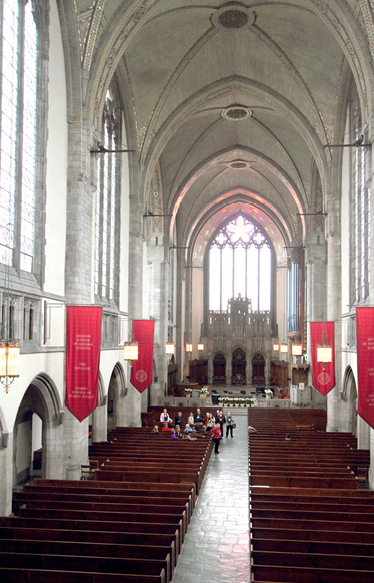
The Rockefeller Memorial Chapel.
The Smart Museum of Art ★ The University of Chicago’s fine-arts museum looks rather modest, but it packs a lot of talent into a compact space. Its permanent collection of more than 7,000 paintings and sculptures spans Western and Eastern civilizations, ranging from classical antiquity to the present day. Bona fide treasures include ancient Greek vases, Chinese bronzes, and Old Master paintings; Frank Lloyd Wright furniture; Tiffany glass; sculptures by Degas, Matisse, and Rodin; and 20th-century paintings and sculptures by Mark Rothko, Arthur Dove, Diego Rivera, Henry Moore, and Chicago sculptor Richard Hunt. Built in 1974, the contemporary building doesn’t really fit in with the campus’s Gothic architecture, but its sculpture garden and outdoor seating area make a nice place for quiet contemplation. The museum also has a gift shop and cafe. Allow 1 hour.
5550 S. Greenwood Ave. (at E. 55th St.).  773/702-0200. www.smartmuseum.uchicago.edu. Free admission. Tues–Fri 10am–4pm (Thurs until 8pm); Sat–Sun 11am–5pm. Closed major holidays. Bus: 6 or Metra Electric train to 57th St. and Lake Park Ave.
773/702-0200. www.smartmuseum.uchicago.edu. Free admission. Tues–Fri 10am–4pm (Thurs until 8pm); Sat–Sun 11am–5pm. Closed major holidays. Bus: 6 or Metra Electric train to 57th St. and Lake Park Ave.
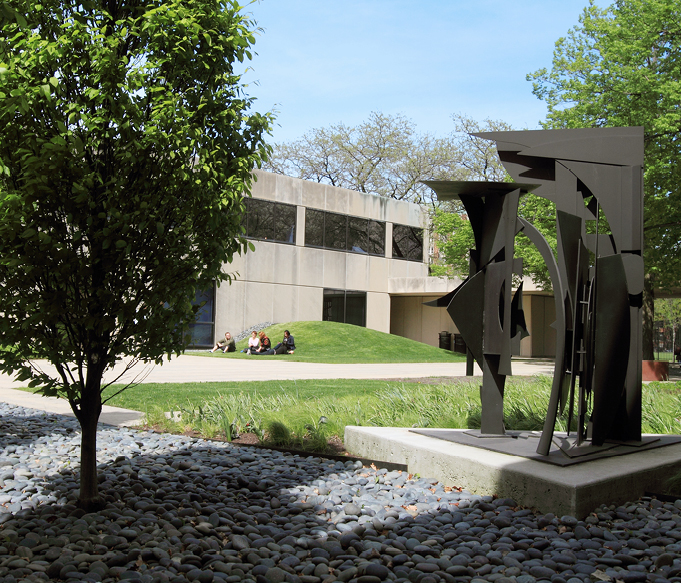
The Smart Museum’s sculpture garden.
Exploring the University of Chicago
Walking around the Gothic spires of the University of Chicago campus is bound to conjure up images of the cloistered academic life. Allow about an hour to stroll through the grassy quads and dramatic stone buildings. (If the weather’s nice, do as the students do, and chill out for a while on the grass.) If you’re visiting on a weekday, your first stop should be the university’s Visitors Information Desk (773/702-9739), on the first floor of Ida Noyes Hall, 1212 E. 59th St., where you can pick up campus maps and get information on university events. The center is open Monday through Friday from 10am to 7pm. If you stop by on a weekend when the Visitors Information Desk is closed, you can get the scoop on campus events at the Reynolds Clubhouse student center (773/702-8787).
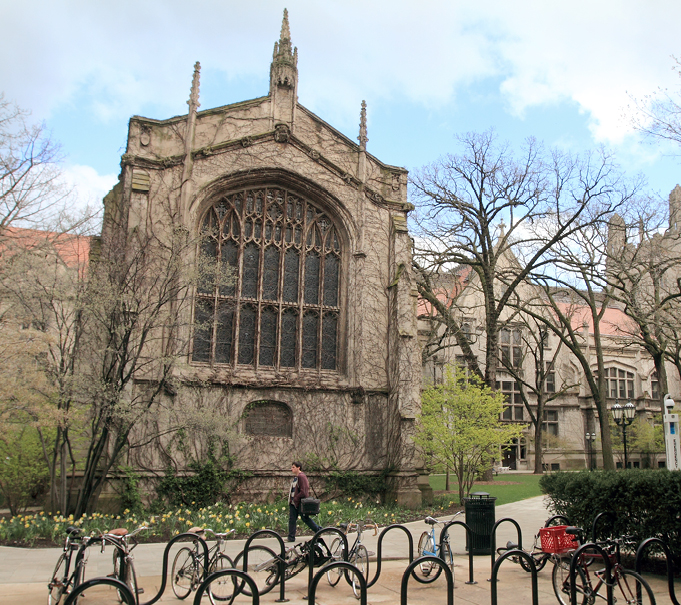
The charming, intimate Bond Chapel.
Start your tour at the Henry Moore statue, Nuclear Energy, on South Ellis Avenue between 56th and 57th streets. It’s next to the Regenstein Library, which marks the site of the old Stagg Field, where, on December 2, 1942, the world’s first sustained nuclear reaction was achieved in a basement laboratory below the field. Then turn left and follow 57th Street until you reach the grand stone Hull Gate; walk straight to reach the main quad, or turn left through the column-lined arcade to reach Hutchinson Court (designed by John Olmsted, son of revered landscape designer Frederick Law Olmsted). The Reynolds Clubhouse, the university’s main student center, is here; you can take a break at the C-Shop cafe or settle down at a table at Hutchinson Commons. The dining room and hangout right next to the cafe will bring to mind the grand dining halls of Oxford and Cambridge.

Henry Moore’s Nuclear Energy.
Other worthy spots on campus include the charming, intimate Bond Chapel, behind Swift Hall on the main quad, and the blocks-long Midway Plaisance, a wide stretch of green that was the site of carnival sideshow attractions during the World’s Columbian Exposition in 1893. (Ever since, the term midway has referred to carnivals in general.)
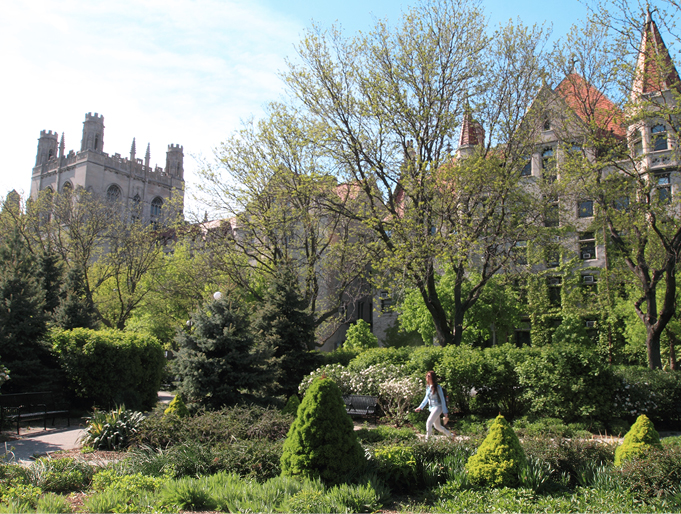
The University of Chicago’s Midway Plaisance.
The Seminary Co-op Bookstore, 5757 S. University Ave. (773/752-4381; www.semcoop.com), is a treasure trove of academic and scholarly books. Its selection of more than 100,000 titles has won it an international reputation as “the best bookstore west of Blackwell’s in Oxford.” It’s open Monday through Friday from 8:30am to 8pm, Saturday from 10am to 6pm, and Sunday from noon to 6pm.
Enjoying the Outdoors in Hyde Park
Hyde Park is not only a haven for book lovers and culture aficionados; the community also has open-air attractions. Worthy outdoor environments near Lake Michigan include Lake Shore Drive, where many stately apartment houses follow the contour of the shoreline. A suitable locale for a quiet stroll during the day is Promontory Point, at 55th Street and Lake Michigan, a bulb of land that juts into the lake and offers a good view of Chicago to the north and the seasonally active 57th Street beach to the south.
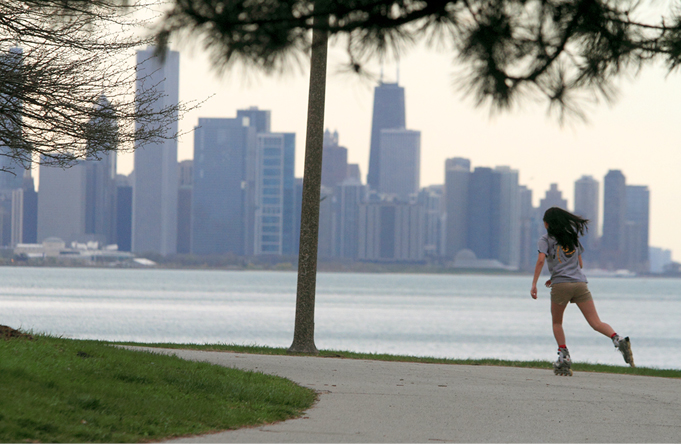
Promontory Point.
Farther south, just below the Museum of Science and Industry, is Wooded Island in Jackson Park, the site of the Japanese Pavilion during the Columbian Exposition and today a lovely garden of meandering paths. In the Perennial Garden at 59th Street and Stony Island Avenue in Jackson Park, more than 180 varieties of flowering plants display a palette of colors that changes with the seasons.
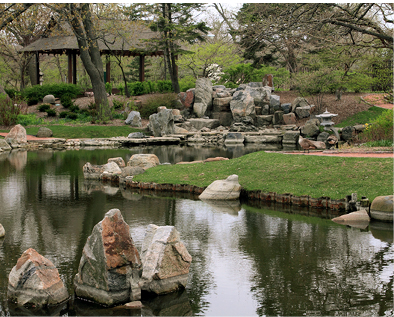
The lovely, meandering paths at Wooded Island.
Kenwood Historic District
A fun side trip for architecture and history buffs is the Kenwood Historic District, a short walk north of Hyde Park. The area originally developed as a suburb of Chicago, when local captains of industry (including Sears founder Julius Rosenwald) began building lavish mansions in the mid-1850s. The neighborhood’s large lots and eclectic mix of architecture (everything from elaborate Italianate to Prairie-style homes) make it unique in Chicago, especially compared to the closely packed buildings in Hyde Park. Although many of the fine homes here became dilapidated after the South Side’s “white flight” of the 1950s and ’60s, a new generation of black and white middle-class homeowners has lovingly renovated these one-of-a-kind mansions. Today the blocks between 47th and 51st streets (north-south) and Blackstone and Drexel boulevards (east-west) make for a wonderful walking tour, with broad, shady streets full of newly restored buildings.
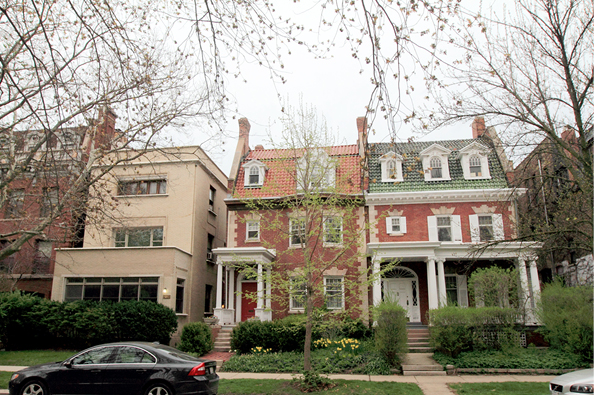
The Kenwood Historic District’s eclectic architecture.
More Museums
City Gallery Along with the pumping station across the street, the Chicago Water Tower is one of only a handful of buildings to survive the Great Chicago Fire of 1871. It has long been a revered symbol of the city’s resilience and fortitude, although today the building is dwarfed by the high-rise shopping centers and hotels of North Michigan Avenue. The Gothic-style limestone building is now an art gallery. The spiffed-up interior is intimate and sunny, and it’s a convenient, quick pit stop of culture on your way to the Water Tower shopping center or the tourist information center across the street in the pumping station. Exhibits focus mostly on photography, usually featuring Chicago-based artists such as the fashion photographer Victor Skrebneski. Allow 15 minutes.
806 N. Michigan Ave. (btw. Chicago Ave. and Pearson St.).  312/742-0808. Free admission. Mon–Sat 10am–6:30pm; Sun 10am–5pm. Bus: 3, 145, 146, 147, or 151.
312/742-0808. Free admission. Mon–Sat 10am–6:30pm; Sun 10am–5pm. Bus: 3, 145, 146, 147, or 151.
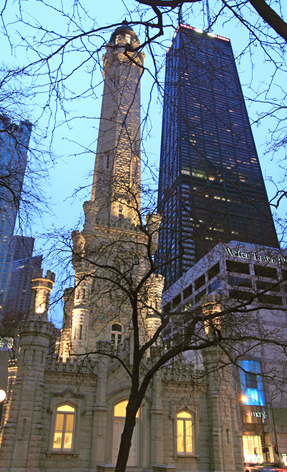
City Gallery, housed in the 19th-century Chicago Water Tower.
Driehaus Museum Investment advisor Richard H. Driehaus is one of Chicago’s leading philanthropists and a passionate supporter of historic architecture (given that only the most avant-garde buildings tend to win design awards, he even awards his own prize for the best new uses of traditional architecture). This museum, a few blocks from the Magnificent Mile, is his personal love letter to the Gilded Age—an immaculate restoration of a grand 19th-century mansion that re-creates the sumptuousness of the era. Throughout, the decorative details astound, from the two-story marble-clad front hall to the huge stained-glass dome in the Gallery ceiling; the museum also houses one of the largest collections of objects by designer Louis Comfort Tiffany. Visits are by guided tour only, with no advance reservations taken. Allow 1 hour.
50 E. Erie St. (at Wabash Ave.).  312/932-8665. www.driehausmuseum.org. Admission $25 adults, $18 seniors, $12.50 students and children 12–16. Tours offered Tues, Wed, and Sat at 10am, 1pm, and 3pm. Subway/El: Red Line to Grand.
312/932-8665. www.driehausmuseum.org. Admission $25 adults, $18 seniors, $12.50 students and children 12–16. Tours offered Tues, Wed, and Sat at 10am, 1pm, and 3pm. Subway/El: Red Line to Grand.
Historic Pullman ★★ Railway magnate George Pullman may have been a fabulously wealthy industrialist, but he fancied himself more enlightened than his 19th-century peers. So when it came time to build a new headquarters for his Pullman Palace Car Company, he dreamed of something more than the standard factory surrounded by tenements. Instead, he built a model community for his workers, a place where they could live in houses with indoor plumbing and abundant natural light—amenities almost unheard of for industrial workers in the 1880s. Pullman didn’t do all this solely from the goodness of his heart: He hoped that the town, named after him, would attract the most skilled workers (who would be so happy that they wouldn’t go on strike). As one of the first “factory towns,” Pullman caused an international sensation and was seen as a model for other companies to follow. The happy workers that Pullman envisioned did go on strike in 1894, however, frustrated by the company’s control of every aspect of their lives.
Today the Pullman district makes a fascinating stop for anyone with a historical or architectural bent. While most of the homes remain private residences, a number of public buildings (including the Hotel Florence, the imposing Clock Tower, and the two-story colonnaded Market Hall) still stand. You can walk through the area on your own (stop by the visitor center for a map), or take a guided a tour at 1:30pm on the first Sunday of the month from May through October ($7 adults, $5 seniors, $4 students). Allow 1½ hours for the guided tour.
11141 S. Cottage Grove Ave.  773/785-8901. www.pullmanil.org. Visitor center Tues–Sun 11am–3pm. Free admission. Train: Metra Electric line to Pullman (111th St.), turn right on Cottage Grove Ave., and walk 1 block to the visitor center.
773/785-8901. www.pullmanil.org. Visitor center Tues–Sun 11am–3pm. Free admission. Train: Metra Electric line to Pullman (111th St.), turn right on Cottage Grove Ave., and walk 1 block to the visitor center.
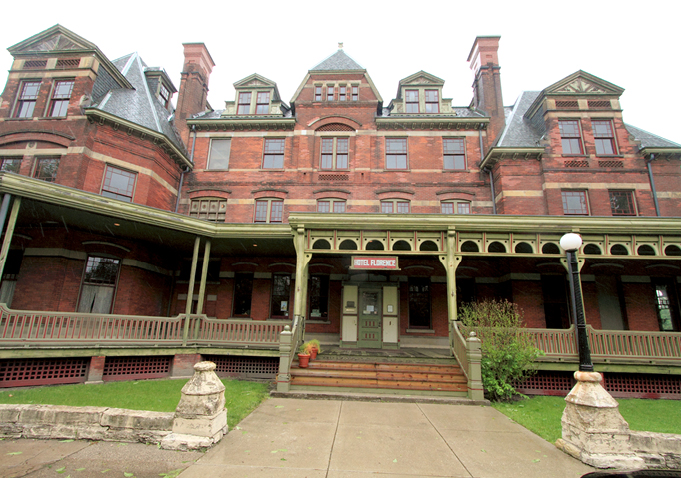
The Hotel Florence in Historic Pullman.
International Museum of Surgical Science ★  This unintentionally macabre shrine to medicine may be the oddest tourist attraction in town. Not for the faint of stomach, it occupies a historic 1917 Gold Coast mansion designed by the noted architect Howard Van Doren Shaw, who modeled it after Le Petit Trianon at Versailles. Displayed throughout its four floors are surgical instruments, paintings, and sculptures depicting the history of surgery and healing practices in Eastern and Western civilizations. (It’s run by the International College of Surgeons.) The exhibits are old-fashioned (no interactive computer displays here), but that’s part of the museum’s offbeat charm.
This unintentionally macabre shrine to medicine may be the oddest tourist attraction in town. Not for the faint of stomach, it occupies a historic 1917 Gold Coast mansion designed by the noted architect Howard Van Doren Shaw, who modeled it after Le Petit Trianon at Versailles. Displayed throughout its four floors are surgical instruments, paintings, and sculptures depicting the history of surgery and healing practices in Eastern and Western civilizations. (It’s run by the International College of Surgeons.) The exhibits are old-fashioned (no interactive computer displays here), but that’s part of the museum’s offbeat charm.
You’ll look at your doctor in a whole new way after viewing the trepanned skulls excavated from an ancient tomb in Peru. The accompanying tools bored holes in patients’ skulls, a horrific practice thought to release the evil spirits causing their illness. (Some skulls show signs of new bone growth, meaning that some lucky headache-sufferers actually survived the low-tech surgery.) There are also battlefield amputation kits, a working iron-lung machine in the polio exhibit, and oddities such as a stethoscope designed to be transported inside a top hat. Other attractions include an apothecary shop and dentist’s office (ca. 1900) re-created in a historic street exhibit, and the hyperbolically titled Hall of Immortals, a sculpture gallery depicting 12 historic figures in medicine, from Hippocrates to Madame Curie. Allow 1 hour.
1524 N. Lake Shore Dr. (btw. Burton Place and North Ave.).  312/642-6502. www.imss.org. Admission $10 adults, $6 seniors, students, and children ages 4–13. Free admission Tues. Tues–Sat 10am–5pm; May–Sept Sun 10am–5pm. Closed major holidays. Bus: 151.
312/642-6502. www.imss.org. Admission $10 adults, $6 seniors, students, and children ages 4–13. Free admission Tues. Tues–Sat 10am–5pm; May–Sept Sun 10am–5pm. Closed major holidays. Bus: 151.
Intuit: The Center for Intuitive and Outsider Art Chicago is home to an active community of collectors of “outsider art,” a term attached to a group of unknown, unconventional artists who do their work without any formal training or connection to the mainstream art world. Often called folk or self-taught artists, they produce highly personal and idiosyncratic work using a range of media, from bottle caps to immense canvases. Intuit was founded in 1991 to bring attention to these artists through exhibitions and educational lectures. It’s in the warehouse district northwest of the Loop, and has two galleries and a performance area. The museum offers a regular lecture series, and if you time your visit right, you might be here for one of the center’s tours of a private local art collection. Allow 1 hour.
756 N. Milwaukee Ave. (at Chicago and Ogden aves.).  312/243-9088. www.art.org. Admission $5 adults, free for children 11 and under. Tues–Sat 11am–5pm (Thurs until 7:30pm). Bus: 56 or 66. Subway/El: Blue Line to Chicago.
312/243-9088. www.art.org. Admission $5 adults, free for children 11 and under. Tues–Sat 11am–5pm (Thurs until 7:30pm). Bus: 56 or 66. Subway/El: Blue Line to Chicago.
Jane Addams Hull-House Museum In 1889, a young woman named Jane Addams bought a mansion on Halsted Street surrounded by the shanties of poor immigrants. Here, Addams and her co-worker, Ellen Gates Starr, launched the American settlement-house movement with the establishment of Hull-House, a place where residents of the surrounding slums could learn English, find affordable childcare, and receive social services; eventually, Addams was awarded the Nobel Peace Prize for her work in social justice. In 1963, most of the settlement, along with the entire residential neighborhood in its immediate vicinity, was demolished to make room for the University of Illinois at Chicago campus, which now owns the museum buildings. Of the original settlement, what remain today are the Hull-House Museum, located in the original mansion, and the residents’ dining hall, snuggled among the ultramodern, poured-concrete buildings of the university campus. Inside are the original furnishings, Addams’s office, and numerous settlement maps and photographs. Rotating exhibits re-create the history of the settlement and the work of its residents, showing how Addams was able to help transform the dismal streets around her into stable inner-city environments worth fighting over. Public tours are given on Wednesdays and Sundays at 1pm. Allow a half-hour.
University of Illinois at Chicago, 800 S. Halsted St. (at Polk St.).  312/413-5353. www.uic.edu/jaddams/hull. Free admission. Tues–Fri 10am–4pm; Sun noon–4pm. Closed university holidays. Bus: 8. Subway/El: Blue Line to Halsted/University of Illinois.
312/413-5353. www.uic.edu/jaddams/hull. Free admission. Tues–Fri 10am–4pm; Sun noon–4pm. Closed university holidays. Bus: 8. Subway/El: Blue Line to Halsted/University of Illinois.
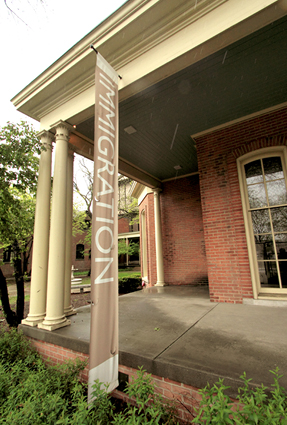
The Jane Addams Hull-House Museum, located in the original mansion.
National Museum of Mexican Art ★ Chicago’s vibrant Pilsen neighborhood, just southwest of the Loop, is home to one of the nation’s largest Mexican-American communities. Ethnic pride emanates from every doorstep, taqueria, and bakery, and colorful murals splash across building exteriors and alleyways. This institution—the only Latino museum accredited by the American Association of Museums—may be the neighborhood’s most prized possession. That’s quite an accomplishment, given that it was founded in 1987 by a passel of public school teachers who pooled $900 to get it started.
Exhibits showcase Mexican and Mexican-American visual and performing artists, often drawing on the permanent collection of more than 5,000 works, but the visiting artists, festival programming, and community participation make the museum really shine. Its Day of the Dead celebration, which runs for about 8 weeks beginning in September, is one of the most ambitious in the country. The Del Corazon Mexican Performing Arts Festival, held in the spring, features programs by local and international artists here and around town; the Sor Juana Festival, presented in the fall, honors Mexican writer and pioneering feminist Sor Juana Ines de la Cruz with photography and painting exhibits, music and theater performances, and poetry readings by Latina women.
The museum is very family oriented, with educational workshops for kids and parents. It also has an excellent gift shop and stages a holiday market, featuring items from Mexico, on the first weekend in December. Allow 1 hour.
1852 W. 19th St. (a few blocks west of Ashland Ave.).  312/738-1503. www.nationalmuseumofmexicanart.org. Free admission. Tues–Sun 10am–5pm. Closed major holidays. Bus: 9. Subway/El: Blue Line to 18th St.
312/738-1503. www.nationalmuseumofmexicanart.org. Free admission. Tues–Sun 10am–5pm. Closed major holidays. Bus: 9. Subway/El: Blue Line to 18th St.
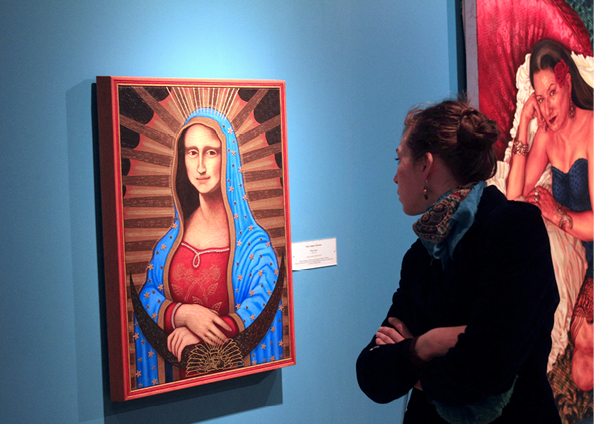
The National Museum of Mexican Art, in Chicago’s vibrant Pilsen neighborhood.
National Veterans Art Museum ★, comprises more than 58,000 dog tags with the names of the men and women who died in the Vietnam War—it creates an emotional effect similar to that of the Wall in Washington, D.C. The complex also houses a small theater, a gift shop, and an outdoor plaza with a flagpole that has deliberately been left leaning because that’s how veterans saw them in combat. Allow 1 hour.
1801 S. Indiana Ave. (at 18th St.).  312/326-0270. www.nvam.org. Admission $10 adults, $7 seniors and students with ID. Tues–Sat 10am–5pm. Closed major holidays. Bus: 3 or 4.
312/326-0270. www.nvam.org. Admission $10 adults, $7 seniors and students with ID. Tues–Sat 10am–5pm. Closed major holidays. Bus: 3 or 4.
Polish Museum of America One million people of Polish ancestry live in Chicago, giving the city the largest Polish population outside of Warsaw, so it’s no surprise that the Polish Museum of America is here, in the neighborhood where many of the first immigrants settled. The museum has one of the most important collections of Polish art and historical materials outside Poland. (It is also the largest museum in the U.S. devoted exclusively to an ethnic group.) The museum’s programs include rotating exhibitions, films, lectures, and concerts, and a permanent exhibit about Pope John Paul II. There’s also a library with a large Polish-language collection, and archives where visitors can research genealogical history. (Call in advance if you want to look through those records.) Allow a half-hour.
984 N. Milwaukee Ave. (at Augusta Blvd.).  773/384-3352. www.polishmuseumofamerica.org. Admission $7 adults, $6 students and seniors, $5 children 11 and under. Fri–Wed 11am–4pm. Subway/El: Blue Line to Division.
773/384-3352. www.polishmuseumofamerica.org. Admission $7 adults, $6 students and seniors, $5 children 11 and under. Fri–Wed 11am–4pm. Subway/El: Blue Line to Division.
Exploring the ’Burbs
Oak Park
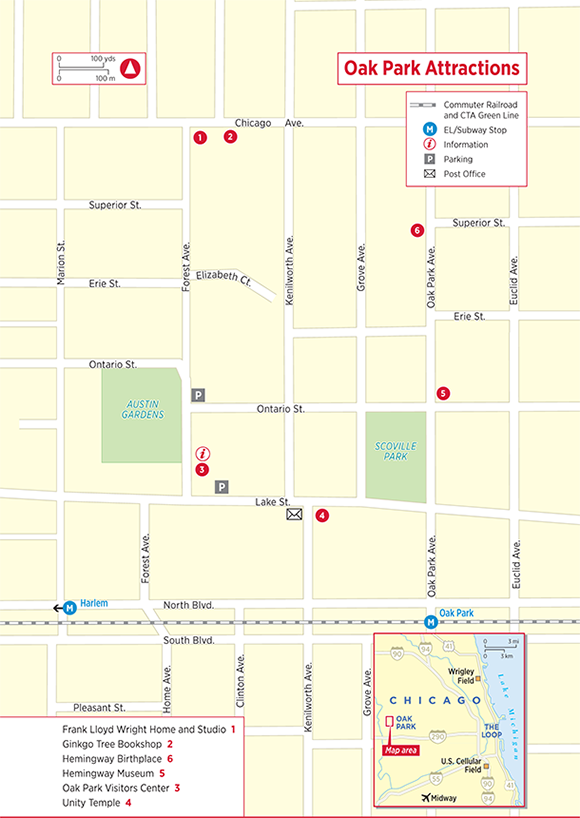
Architecture and literary buffs alike make pilgrimages to Oak Park, a nearby suburb on the western border of the city that is easily accessible by car or train. Bookworms flock here to see the town where Ernest Hemingway was born and grew up, while others come to catch a glimpse of the Frank Lloyd Wright–designed homes that line the well-maintained streets.
Getting There
By Car Oak Park is 10 miles due west of downtown Chicago. By car, take the Eisenhower Expressway (I-290) west to Harlem Avenue (Ill. 43) and exit north. Continue on Harlem north to Lake Street. Take a right on Lake Street and continue to Forest Avenue. Turn left here, and immediately on your right you’ll see the Oak Park Visitor Center (see below).
By Public Transportation Take the Green Line west to the Harlem stop, roughly a 25-minute ride from downtown. Exit the station onto Harlem Avenue, and proceed north to Lake Street. Take a right on Lake Street, follow it to Forest Avenue, and then turn left to the Oak Park Visitor Center (see below).
By Tour The Chicago Architecture Foundation regularly runs guided tours from downtown Chicago to Oak Park. For details, see “Sightseeing Tours”.
Visitor Information
The Oak Park Visitor Center, 158 Forest Ave. (888/OAK-PARK [625-7275]; www.visitoakpark.com), is open daily from 10am to 5pm April through October, and from 10am to 4pm November through March. Stop here for an orientation, maps, and guidebooks. There’s a city-operated parking lot next door. The heart of the historic district and the Frank Lloyd Wright Home and Studio are only a few blocks away.
An extensive tour of Oak Park’s historic district leaves from the Ginkgo Tree Bookshop, 951 Chicago Ave., on weekends from 11am to 3:30pm (exact departure times vary, depending on how many people show up). The tour lasts 1 hour and costs $15 for adults, $12 for seniors and children ages 4 to 17 (free for children 3 and under). If you can’t make it to Oak Park on the weekend, you can follow a self-guided map and audiocassette tour of the historic district for the same price; the audio tour is available at the Ginkgo Tree Bookshop from 10am to 3:30pm. In addition to homes designed by Wright, you will see work by several of his disciples, as well as some charming examples of the Victorian styling that he so disdained. A more detailed map, Architectural Guide Map of Oak Park and River Forest, includes text and photos of all 80 sites of interest in Oak Park and neighboring River Forest.
wright’s Oak Park
Oak Park has the highest concentration of Frank Lloyd Wright–designed and –built houses or buildings anywhere. People come here to marvel at the work of a man who saw his life as a twofold mission: to wage a single-handed battle against excessively ornamental architecture (Victorian, in particular), and to create in its place a new form that would be, at the same time, functional, appropriate to its natural setting, and stimulating to the imagination.
Not everyone who comes to Oak Park shares Wright’s architectural philosophy, but scholars and enthusiasts admire him for being consistently true to his vision, out of which emerged a unique and genuinely American architectural statement. The reason for Wright’s success could stem from the fact that he was a living exemplar of a quintessential American type. In a deep sense, he embodied the ideal of the self-made and self-sufficient individual who had survived, even thrived, in the frontier society—qualities that he expressed in his almost-puritanical insistence that each spatial or structural form in his buildings serve some useful purpose. He was also an aesthete in Emersonian fashion, deriving his idea of beauty from natural environments, where apparent simplicity often belies a subtle complexity.
The three principal ingredients of a tour of Wright-designed structures in Oak Park are the Frank Lloyd Wright Home and Studio Tour, the Unity Temple Tour, and a walking tour—guided or self-guided—to view the exteriors of homes throughout the neighborhood that were built by the architect. Oak Park has 25 homes and buildings by Wright, constructed between 1892 and 1913, which constitute the core output of his Prairie School period.
The Wright Stuff
Frank Lloyd Wright Home and Studio ★★★ For the first 20 years of Wright’s career, this remarkable complex served first and foremost as the sanctuary where he designed and executed more than 130 of 430 completed buildings. The home began as a simple shingled cottage that the 22-year-old Wright built for his bride in 1889, but it became a living laboratory for his revolutionary reinvention of interior spaces. Wright remodeled the house constantly until 1911, when he moved out permanently. During Wright’s fertile early period, the house was Wright’s showcase, but it also embraces many idiosyncratic features molded to his own needs rather than those of a client. With many add-ons—including a barrel-vaulted children’s playroom and a studio with an octagonal balcony suspended by chains—the place has a certain whimsy that others might have found less livable. This was not an architect’s masterpiece, but rather the master’s home, and visitors can savor every room for the view it offers into of the workings of a remarkable mind.
Advance reservations are recommended, especially during the busy summer months; you can book online or by phone (800/514-3849). Allow 1 hour for the tour, more time if you want to browse in the bookshop.
951 Chicago Ave.  708/848-1976. www.gowright.org. Admission $15 adults, $12 seniors and children 4–17, free for children 3 and under; combined admission for the home and studio tour and guided or self-guided historic district tour $25 adults, $20 seniors and students 4–17. Admission to the home and studio is by guided tour only; tours depart from bookshop daily 11am–4pm. Closed Jan 1, last week in Jan, Thanksgiving, and Christmas. Facilities for people with disabilities are limited; please call in advance.
708/848-1976. www.gowright.org. Admission $15 adults, $12 seniors and children 4–17, free for children 3 and under; combined admission for the home and studio tour and guided or self-guided historic district tour $25 adults, $20 seniors and students 4–17. Admission to the home and studio is by guided tour only; tours depart from bookshop daily 11am–4pm. Closed Jan 1, last week in Jan, Thanksgiving, and Christmas. Facilities for people with disabilities are limited; please call in advance.
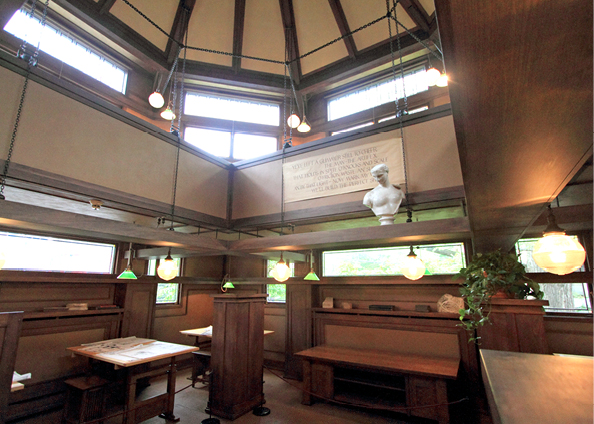
Frank Lloyd Wright’s modest home became a living laboratory for his revolutionary work.
Unity Temple ★ After a fire destroyed its church around 1900, a Unitarian Universalist congregation asked one of its members, Frank Lloyd Wright, to design an affordable replacement. Using poured concrete with metal reinforcements—a necessity due to a small $40,000 budget—Wright created a building that on the outside seems as forbidding as a mausoleum but inside contains all the elements of the Prairie School that has made Wright’s name immortal. Wright believed conventional church architecture was overpowering—he complained that he didn’t feel a part of the Gothic-style cathedral across the street, for example—and Unity Temple was intended to offer a new model for houses of worship.
Yet his vision in this regard was somewhat confused and contradictory. He wanted Unity Temple to be “democratic,” but perhaps Wright was unable to subdue his own personal hubris and hauteur in the creative process, for the ultimate effect of his chapel, and much of the building’s interior, is grand and imperial. This is no simple meetinghouse; instead, its principal chapel looks like the chamber of the Roman Senate.
Wright was a true hands-on, can-do person; he knew his materials as intimately as the artisans who carried out his plans. He added pigment to the plaster (rather than the paint) to achieve a pale, natural effect. His use of wood trim and other decorative touches is still exciting to behold; his sensitivity to grain, tone, and placement was akin to that of an exceptionally gifted woodworker. His stunning, almost minimalist use of form is what still sets him apart as a relevant and brilliant artist. Unity Temple still feels groundbreaking 100 years later—which Wright would consider the ultimate compliment. Allow a half-hour.
875 Lake St.  708/383-8873. www.unitytemple-utrf.org. Self-guided tours $9 adults; $7 seniors, children 6–12, and students with ID; free for children 5 and under. Mon–Fri 10:30am–4:30pm; Sat 10am–2pm; Sun 1–4pm. Closed New Year’s Day, Thanksgiving, and Christmas. Church events can alter schedule; call in advance.
708/383-8873. www.unitytemple-utrf.org. Self-guided tours $9 adults; $7 seniors, children 6–12, and students with ID; free for children 5 and under. Mon–Fri 10:30am–4:30pm; Sat 10am–2pm; Sun 1–4pm. Closed New Year’s Day, Thanksgiving, and Christmas. Church events can alter schedule; call in advance.
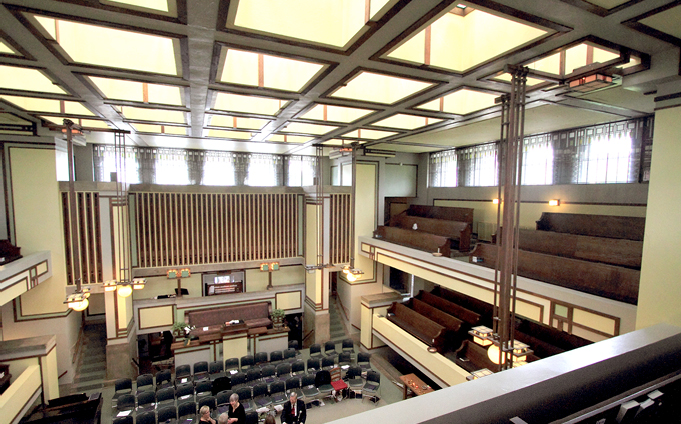
Wright’s Unity Temple still feels groundbreaking, 100 years later.
On the Trail of Hemingway
Hemingway Museum Frank Lloyd Wright isn’t Oak Park’s only famous native son; the town was also the birthplace of writer Ernest Hemingway. Hemingway had no great love for Oak Park; he moved away right after high school and later referred to his hometown as a place of “wide lawns and narrow minds.” But that hasn’t stopped Oak Park from laying claim to the great American writer. A portion of the ground floor of this former church, now the Oak Park Arts Center, holds a small but interesting display of Hemingway memorabilia. A 6-minute video sheds considerable light on Hemingway’s time in Oak Park, where he spent the first 18 years of his life, and covers his high school experiences particularly well.
The Ernest Hemingway Birthplace Home is 2 blocks north, at 339 N. Oak Park Ave. The lovely Queen Anne house—complete with wraparound porch and turret—was the home of Hemingway’s maternal grandparents, and it’s where the writer was born on July 21, 1899. Its connection to Hemingway is actually pretty tenuous—he spent most of his boyhood and high school years at 600 N. Kenilworth Ave., a few blocks away (that house is still privately owned)—but the birthplace has been carefully restored to replicate its appearance at the end of the 19th century, making this an appealing stop for fans of historic house tours (whether they’re Hemingway fans or not). The hours are the same as the Hemingway Museum’s. Allow 1 hour.
200 N. Oak Park Ave.  708/848-2222. www.ehfop.org. Combined admission to Hemingway Museum and Ernest Hemingway Birthplace Home $10 adults, $8 seniors and children 6–12, free for children 5 and under. Sun–Fri 1–5pm; Sat 10am–5pm. Closed major holidays.
708/848-2222. www.ehfop.org. Combined admission to Hemingway Museum and Ernest Hemingway Birthplace Home $10 adults, $8 seniors and children 6–12, free for children 5 and under. Sun–Fri 1–5pm; Sat 10am–5pm. Closed major holidays.
The North Shore
Between Chicago and the state border of Wisconsin is one of the nation’s most affluent residential areas, a swath of suburbia known as the North Shore. Although towns farther west like to co-opt the name for its prestige, the North Shore proper extends from Evanston, Chicago’s nearest neighbor to the north, along the lakefront to tony Lake Forest, originally built as a resort for Chicago’s aristocracy. Dotted with idyllic, picture-perfect towns such as Kenilworth, Glencoe, and Winnetka, this area has long attracted filmmakers such as Robert Redford, who filmed Ordinary People in Lake Forest, and the North Shore’s own John Hughes, who shot most of his popular coming-of-age comedies (Sixteen Candles, Ferris Bueller’s Day Off, Home Alone, and so on) here.
Although a Metra train line extends to Lake Forest and neighboring Lake Bluff, I highly recommend that you rent a car and drive north along Sheridan Road, which winds its leisurely way through many of these communities, past palatial homes and mansions designed in a startling array of architectural styles. Aside from Lake Shore Drive in Chicago, you won’t find a more impressive stretch of roadway in the entire metropolitan area.
Exploring Evanston
Despite being frequented by Chicagoans, Evanston, the city’s oldest suburb, retains an identity all its own. A unique hybrid of sensibilities, it manages to combine the tranquillity of suburban life with a highly cultured, urban charm. It’s great fun to wander amid the shops and cafes in its downtown area or along funky Dempster Street at its southern end. The beautiful lakefront campus of Northwestern University (847/491-3741; www.northwestern.edu) is here, and many of its buildings—such as Alice Millar Chapel, with its sublime stained-glass facade, and the Mary and Leigh Block Gallery, a fine-arts haven that offers a top-notch collection and intriguing temporary exhibitions—are well worth several hours of exploration
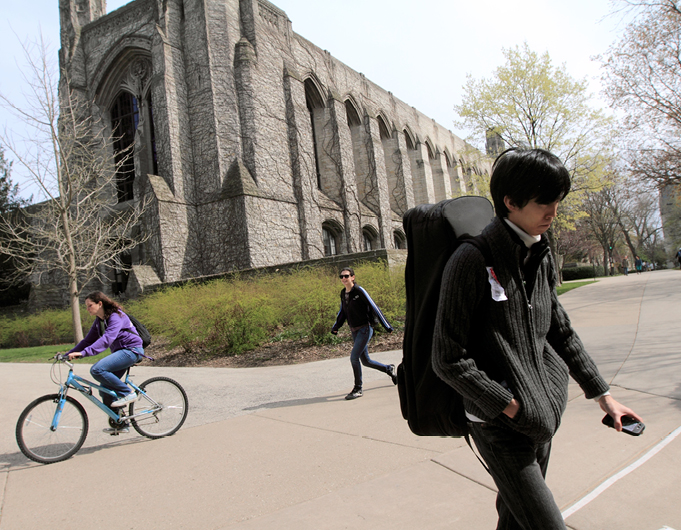
Northwestern University.
.
Evanston was also the home of Frances Willard, founder of the Women’s Christian Temperance Union (WCTU). The Francis Willard House Museum, 1730 Chicago Ave. (847/328-7500; www.franceswillardhouse.org), is open to visitors on the first and third Sundays of every month from 1 to 4pm ($10 adults, $5 children 12 and under). Nine of the 17 rooms in this old Victorian “Rest Cottage” (as Willard called it) have been converted into a museum of period furnishings and temperance memorabilia. Among her personal effects is the bicycle she affectionately called “Gladys” and learned to ride late in life, in the process spurring women across the country to do the same. The headquarters of the WCTU are still on-site.
Tucked away in north Evanston, a few miles from the Northwestern campus, is the unusual and informative Mitchell Museum of the American Indian, 2600 Central Park Ave. (847/475-1030; www.mitchellmuseum.org). The collection ranges from stoneware tools and weapons to the work of contemporary Native-American artists. The museum is open Tuesday through Saturday from 10am to 5pm (Thurs until 8pm), and Sunday from noon to 4pm. It’s closed on holidays and during the last 2 weeks of August. Admission is $5 for adults, $2.50 for seniors and children. Call in advance to arrange a volunteer-led tour.
For a bit of serenity, head to Grosse Point Lighthouse and Maritime Museum, 2601 Sheridan Rd. (847/328-6961; www.grossepointlighthouse.net), a historic lighthouse built in 1873, when Lake Michigan still teemed with cargo-laden ships. Tours of the lighthouse, situated in a nature center, take place on weekends from June to September at 2, 3, and 4pm ($6 adults, $3 children 8–12; children 7 and under not admitted, for safety reasons). The adjacent Lighthouse Beach is a favorite spot for local families during the summer. If you’re here between Memorial Day and Labor Day, you’ll have to pay to frolic on the sand ($7 adults, $5 children 1–11), but it’s a great place for a (free) stroll on a sunny spring or fall day.

Tours of the historic Grosse Point Lighthouse are offered on summer weekends.
Other Area Attractions
Bahá’í House of Worship Up the road from Evanston in Wilmette is the most visited of all the sights in the northern suburbs, the Bahá’í House of Worship, an ethereal edifice that seems not of this earth. The gleaming white stone temple, designed by the French-Canadian Louis Bourgeois and completed in 1953, is essentially a soaring, nine-sided, 135-foot dome, draped in a delicate lacelike facade, that reveals the Eastern influence of the Bahá’í faith’s native Iran. Surrounded by formal gardens, it is one of seven Bahá’í temples in the world and the only one in the Western Hemisphere. The dome’s latticework is even more beautiful as you gaze upward from the floor of the sanctuary, which, during the day, is flooded with light. Downstairs, displays in the visitor center explain the Bahá’í faith. Temple members offer informal tours of the building and exhibits to anyone who inquires. Allow a half-hour.
100 Linden Ave. (at Sheridan Rd.), Wilmette.  847/853-2300. www.bahai.us/bahai-temple. Free admission. Daily 7am–10pm; visitor center 10am–5pm (until 8pm May–Sept). From Chicago, take the El Red Line north to Howard St. Change for the Evanston train and go to the end of the line, Linden Ave. (Or take the Purple/Evanston Express and stay on the same train all the way.) Turn right on Linden and walk 2 blocks east. If you’re driving, go north on the Outer Dr. (Lake Shore Dr.), which feeds into Sheridan Rd.
847/853-2300. www.bahai.us/bahai-temple. Free admission. Daily 7am–10pm; visitor center 10am–5pm (until 8pm May–Sept). From Chicago, take the El Red Line north to Howard St. Change for the Evanston train and go to the end of the line, Linden Ave. (Or take the Purple/Evanston Express and stay on the same train all the way.) Turn right on Linden and walk 2 blocks east. If you’re driving, go north on the Outer Dr. (Lake Shore Dr.), which feeds into Sheridan Rd.
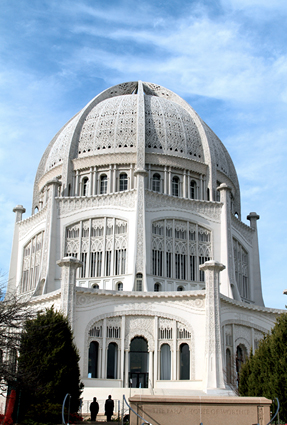
Wilmette’s Bahá’í temple is a soaring, nine-sided dome, one of only seven such temples in the world.
Chicago Botanic Garden ★★  Despite its name, the world-class Chicago Botanic Garden is 25 miles north of the city in the suburb of Glencoe. This 385-acre living preserve includes eight large lagoons and a variety of distinct botanical environments, including the Illinois prairie, an English walled garden, and a three-island Japanese garden. Also on the grounds are a large fruit-and-vegetable garden, an “enabling garden” (which shows how gardening can be adapted for people with disabilities), and a 100-acre old-growth oak woodland. If you’re here in the summer, don’t miss the extensive rose gardens, with more than 7,750 plants. The Botanic Garden also has an exhibit hall, auditorium, museum, library, education greenhouses, outdoor pavilion, carillon, cafe, designated bike path, and garden shop. Carillon concerts take place at 7pm Monday evenings from late June through August; tours of the carillon are offered beforehand.
Despite its name, the world-class Chicago Botanic Garden is 25 miles north of the city in the suburb of Glencoe. This 385-acre living preserve includes eight large lagoons and a variety of distinct botanical environments, including the Illinois prairie, an English walled garden, and a three-island Japanese garden. Also on the grounds are a large fruit-and-vegetable garden, an “enabling garden” (which shows how gardening can be adapted for people with disabilities), and a 100-acre old-growth oak woodland. If you’re here in the summer, don’t miss the extensive rose gardens, with more than 7,750 plants. The Botanic Garden also has an exhibit hall, auditorium, museum, library, education greenhouses, outdoor pavilion, carillon, cafe, designated bike path, and garden shop. Carillon concerts take place at 7pm Monday evenings from late June through August; tours of the carillon are offered beforehand.
Every summer the Botanic Garden stages a special outdoor exhibition. (One year giant animal-shaped topiaries stood in unexpected locations throughout the grounds; another year, model railroads wound through miniature versions of American national parks.) Check the website or call for event schedules. Allow 3 hours.
1000 Lake-Cook Rd. (just east of Edens Expwy./I-94), Glencoe.  847/835-5440. www.chicago-botanic.org. Free admission. Daily 8am–sunset. Tram tours Apr–Oct. Closed Christmas. From Chicago, take Sheridan Rd. north along Lake Michigan or the Edens Expwy. (I-94) to Lake-Cook Rd. Parking $20/day.
847/835-5440. www.chicago-botanic.org. Free admission. Daily 8am–sunset. Tram tours Apr–Oct. Closed Christmas. From Chicago, take Sheridan Rd. north along Lake Michigan or the Edens Expwy. (I-94) to Lake-Cook Rd. Parking $20/day.
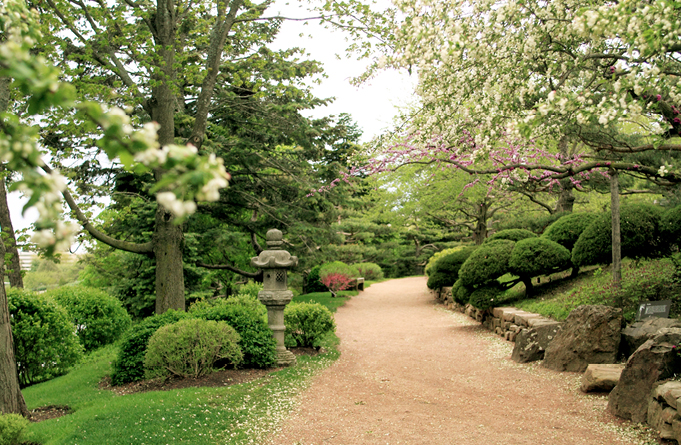
The Chicago Botanic Garden’s serene Japanese garden.
Ravinia Festival ★★  Want to know where the natives get away from it all? Come summertime, you’ll find them chilling on the lawn at Ravinia, the summer home of the highly regarded Chicago Symphony Orchestra in suburban Highland Park. In operation since 1904, Ravinia started off as an amusement park. The Martin Theatre—built in the Prairie style—still remains and is the only building still standing from the early days. Over the years, the festival has hosted an amazing array of performers, from Louis Armstrong, Duke Ellington, George Gershwin, and Ella Fitzgerald to Janis Joplin and Steven Sondheim. The season runs from mid-June to Labor Day and includes far more than classical concerts: You can also catch pop acts, dance performances, operatic arias, and blues concerts. Tickets are available for the lawn or the covered pavilion, where you get a reserved seat and a view of the stage. The lawn is the real joy of Ravinia: sitting under the stars and a canopy of leafy branches while listening to music and indulging in an elaborate picnic. (It’s a local tradition to try to outdo everyone else by bringing candelabras and fine china.)
Want to know where the natives get away from it all? Come summertime, you’ll find them chilling on the lawn at Ravinia, the summer home of the highly regarded Chicago Symphony Orchestra in suburban Highland Park. In operation since 1904, Ravinia started off as an amusement park. The Martin Theatre—built in the Prairie style—still remains and is the only building still standing from the early days. Over the years, the festival has hosted an amazing array of performers, from Louis Armstrong, Duke Ellington, George Gershwin, and Ella Fitzgerald to Janis Joplin and Steven Sondheim. The season runs from mid-June to Labor Day and includes far more than classical concerts: You can also catch pop acts, dance performances, operatic arias, and blues concerts. Tickets are available for the lawn or the covered pavilion, where you get a reserved seat and a view of the stage. The lawn is the real joy of Ravinia: sitting under the stars and a canopy of leafy branches while listening to music and indulging in an elaborate picnic. (It’s a local tradition to try to outdo everyone else by bringing candelabras and fine china.)
Don’t let the distance from downtown discourage you from visiting, because Ravinia is served by an extremely convenient public-transportation system. On concert nights, a special Ravinia Metra commuter train leaves at 5:50pm from the North Western train station at Madison and Canal streets (just west of the Loop). The train stops at the festival at 6:30pm, allowing plenty of time to enjoy a picnic before an 8 o’clock show. After the concert, trains wait right outside the gates to take commuters back to the city. The round-trip train fare is $6, a real bargain, considering that traffic around the park can be brutal.
Dining options at the park range from the fine-dining restaurant Mirabelle (847/432-7550 for reservations) to prepacked picnic spreads from the Gatehouse, featuring gourmet items to go. For $10, you can rent a pair of lawn chairs and a table from booths set up near the park entrance. In case you’re wondering about the weather conditions at concert time, dial Ravinia’s Weather Line (847/433-5010).
Green Bay and Lake-Cook rds., Highland Park.  847/266-5100. www.ravinia.org. Pavilion tickets $20–$90; lawn $10–$25. Most concerts are in the evening.
847/266-5100. www.ravinia.org. Pavilion tickets $20–$90; lawn $10–$25. Most concerts are in the evening.

Visit historic Long Grove’s many specialty stores, galleries and restaurants.
The North & Northwest Suburbs
The North Shore is only one slice of life north of Chicago. To its west lies a sprawling thicket of old and new suburbs, from the bucolic environs of equestrian-minded Barrington and its ring of smaller satellite communities in the far northwest, to near-northwest shopping mecca Schaumburg, home to the gigantic Woodfield Mall. While Woodfield attracts a steady stream of dedicated shoppers—allowing it to tout its status as one of the top tourist destinations in Illinois—it’s not that distinctive; you’ll find most of the same stores at your local megamall back home.
A more pastoral option for visitors with time on their hands might be a day trip to the historic village of Long Grove, about 30 miles northwest of Chicago. Settled in the 1840s by German immigrants and pioneers traveling west from New England, Long Grove has assiduously preserved its old-fashioned character. Set amid 500 acres of oak- and hickory-tree groves, the village maintains nearly 100 specialty stores, galleries, and restaurants, many of which are in former smithies, wheelwright barns, and century-old residences. (Don’t skip the Long Grove Confectionery Company, a local institution.) By village ordinance, all new buildings constructed in the shopping district must conform to the architecture of the early 1900s. The village schedules several cultural and entertainment events, festivals, and art fairs throughout the year. The biggest and best is the annual Strawberry Festival, held during the last weekend in June. Call the village’s information center or check the town’s website (847/634-0888; www.longgroveonline.com) for updates on coming events. To get there from the Chicago Loop, take the I-94 tollway (also known as the Kennedy Expwy.) north until it separates at I-90, another tollway that runs northwest. Follow I-90 until you reach Rte. 53, and drive north on 53 until it dead-ends at Lake-Cook Road. Take the west exit off 53, and follow Lake-Cook Road to Hicks Road. Turn right on Hicks Road and then left on Old McHenry Road, which will take you right into the center of town.
Arlington International Racecourse With its gleaming-white, palatial, six-story grandstand and lush gardens, this racecourse is one of the most beautiful showcases for thoroughbred horse racing in the world. Its storied history stretches back to 1927, and such equine stars as Citation, Secretariat, and Cigar have graced the track. The annual Arlington Million (the sport’s first million-dollar race, held in mid-Aug) attracts top jockeys, trainers, and horses, and is part of the World Series Racing Championship, which includes the Breeders Cup races. Arlington’s race days are thrilling to behold, with all of racing’s time-honored pageantry on display—from the bugler in traditional dress to the parade of jockeys.
Arlington likes to say that it caters to families, and the ambience is more Disney than den of iniquity. “Family days” throughout the summer include live music and entertainment ranging from petting zoos to puppet shows.
2200 W. Euclid Ave., Arlington Heights.  847/385-7500. www.arlingtonpark.com. May–Sept Wed–Sun gates open 11am, 1st post 1pm. No racing Oct–Apr. General admission $6 adults, $3–$6 additional per person for reserved seating. Take the Kennedy (I-94) Expwy. to the I-90 tollway, and exit north on Rte. 53. Follow 53 north to the Euclid exit. Or take Metra train to Arlington Heights. Free parking.
847/385-7500. www.arlingtonpark.com. May–Sept Wed–Sun gates open 11am, 1st post 1pm. No racing Oct–Apr. General admission $6 adults, $3–$6 additional per person for reserved seating. Take the Kennedy (I-94) Expwy. to the I-90 tollway, and exit north on Rte. 53. Follow 53 north to the Euclid exit. Or take Metra train to Arlington Heights. Free parking.

Arlington International Racecourse.
The Western Suburbs
So many corporations have taken to locating their offices beyond the city limits that today more people work in the suburbs than commute into Chicago. Much of the suburban sprawl in counties such as DuPage and Kane consists of seas of aluminum-sided houses that seem to sprout from cornfields overnight. But there are also some lovely older towns, such as upscale Hinsdale and, much farther west, the quaint tandem of St. Charles and Geneva, which lie across the Fox River from each other. Perhaps there is no more fitting symbol of this booming area than the city of Naperville. A historic, formerly rural community with a Main Street U.S.A. downtown district worthy of Norman Rockwell, Naperville has exploded from a population of about 30,000 residents in the early 1970s to approximately 145,000 today—which makes it the third-largest municipality in the state. Naperville maintains a collection of 19th-century buildings in an outdoor setting known as Naper Settlement, and its river walk is the envy of neighboring village councils. But much of its yesteryear charm seems to be disappearing bit by bit as new subdivisions and strip malls ooze forth across the prairie.
Brookfield Zoo ★★  In contrast to the more modest Lincoln Park Zoo, Brookfield is enormous, spreading out over 216 acres and housing thousands of animals—camels, dolphins, giraffes, baboons, wolves, tigers, green sea turtles, Siberian tigers, snow leopards, and more—in naturalistic environments that put them side by side with other inhabitants of their regions. These creative indoor and outdoor settings, filled with activities to keep kids interested, are what set Brookfield apart.
In contrast to the more modest Lincoln Park Zoo, Brookfield is enormous, spreading out over 216 acres and housing thousands of animals—camels, dolphins, giraffes, baboons, wolves, tigers, green sea turtles, Siberian tigers, snow leopards, and more—in naturalistic environments that put them side by side with other inhabitants of their regions. These creative indoor and outdoor settings, filled with activities to keep kids interested, are what set Brookfield apart.
Start out at Habitat Africa! ★ explores the west coast of Chile and Peru, and includes everything from a tank of plate-size moon jellies to a rocky shore where Humboldt penguins swim and nest as Inca terns and gray gulls fly freely overhead. The Swamp re-creates the bioregions of a southern cypress swamp and an Illinois river scene, and discusses what people can do to protect wetlands. The dolphins at the Seven Seas Panorama ★★ put on an amazing show that has been a Brookfield Zoo fixture for years. If you go on a weekend, buy tickets to the dolphin show at least a couple of hours before the one you plan to attend, because they tend to sell out quickly.
The Hamill Family Play Zoo is a wonderful stop for kids. They not only get to pet animals, but can also build habitats, learn how to plant a garden, and even play animal dress-up. The only catch: the separate admission fee ($3.50 adults, $2.50 children). Allow 3 hours.
First Ave. and 31st St., Brookfield.  708/485-0263. www.brookfieldzoo.org. Admission $14 adults, $9.50 seniors and children 3–11, free for children 2 and under. Parking $9. Free admission Tues and Thurs Oct–Feb. Memorial Day to Labor Day daily 9:30am–6pm (Sun until 7:30pm); fall–spring daily 10am–5pm. Bus: 304 or 311. Take the Stevenson (I-55) and Eisenhower (I-290) expressways 14 miles west of the Loop.
708/485-0263. www.brookfieldzoo.org. Admission $14 adults, $9.50 seniors and children 3–11, free for children 2 and under. Parking $9. Free admission Tues and Thurs Oct–Feb. Memorial Day to Labor Day daily 9:30am–6pm (Sun until 7:30pm); fall–spring daily 10am–5pm. Bus: 304 or 311. Take the Stevenson (I-55) and Eisenhower (I-290) expressways 14 miles west of the Loop.
Morton Arboretum Feel like getting away from it all? This suburban oasis, covering almost 2,000 acres, is dedicated to preserving an amazing variety of trees and shrubs in a peaceful, welcoming setting. You can follow walking trails through solemn forests, explore a re-creation of an original Illinois prairie, or wander the twisting pathways of the Maze Garden. (If you’d rather watch others wander, climb up to the viewing platform built around the trunk of a 60-ft.-tall sycamore tree.) Covering the arboretum’s vast acreage requires some driving—and you’ll need a car to get here, since it’s not accessible by public transportation.
The arboretum’s modestly named Children’s Garden is more like a family wonderland, with dozens of nature-friendly attractions. Highlights include streams built for splashing, hidden grottoes, and a wooden walkway suspended between evergreen trees. Morton Arboretum also offers regular nature talks, as well as special exhibits at the Sterling Morton Library. The Visitor Center has an attractive gift shop and restaurant.
4100 Illinois Rte. 53, Lisle.  630/968-0074. www.mortonarb.org. Grounds open daily year-round 7am–7pm (or sunset, whichever comes soonest). Visitor Center 9am–5pm (until 6pm May–Oct). Admission $11 adults, $10 seniors, $8 children 2–17. Take the Stevenson (I-290) Expwy. west from downtown Chicago to I-88. Exit north onto Rte. 53 and follow the signs for ½ mile to the entrance.
630/968-0074. www.mortonarb.org. Grounds open daily year-round 7am–7pm (or sunset, whichever comes soonest). Visitor Center 9am–5pm (until 6pm May–Oct). Admission $11 adults, $10 seniors, $8 children 2–17. Take the Stevenson (I-290) Expwy. west from downtown Chicago to I-88. Exit north onto Rte. 53 and follow the signs for ½ mile to the entrance.
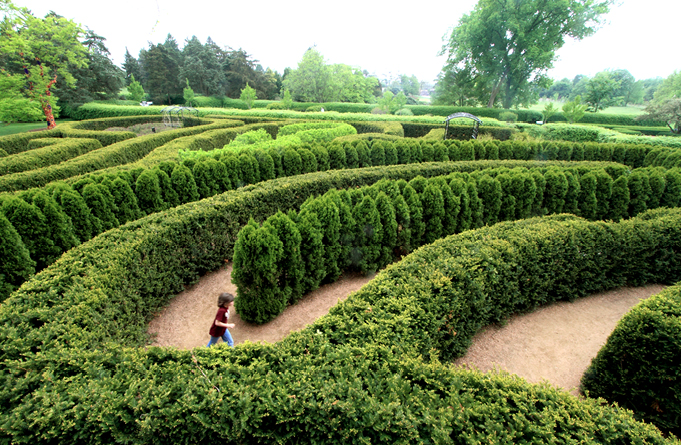
Wander the twisting pathways of the Morton Arboretum’s Maze Garden.
Kid Stuff
Chicago Children’s Museum ★★  Located on tourist-filled Navy Pier, this museum is one of the most popular family attractions in the city. The building has areas especially for preschoolers as well as for children up to age 10, and several permanent exhibits allow kids a maximum of hands-on fun. Dinosaur Expedition re-creates an expedition to the Sahara, allowing kids to experience camp life, conduct scientific research, and dig for the bones of Suchomimus, a Saharan dinosaur discovered by Chicago paleontologist Paul Sereno (a full-scale model stands nearby).
Located on tourist-filled Navy Pier, this museum is one of the most popular family attractions in the city. The building has areas especially for preschoolers as well as for children up to age 10, and several permanent exhibits allow kids a maximum of hands-on fun. Dinosaur Expedition re-creates an expedition to the Sahara, allowing kids to experience camp life, conduct scientific research, and dig for the bones of Suchomimus, a Saharan dinosaur discovered by Chicago paleontologist Paul Sereno (a full-scale model stands nearby).
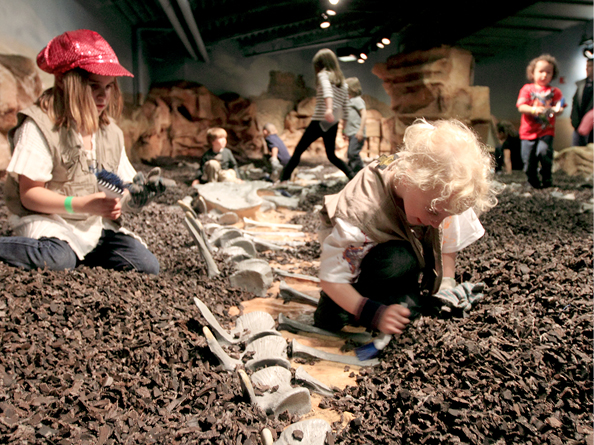
Kids dig for the bones of Suchomimus, a Saharan dinosaur, at the Chicago Children’s Museum Dinosaur Expedition.
The Inventing Lab will appeal to budding scientists—here kids can take the Alarm Clock Challenge and wake up the sleeping bear or slide down the musical Grand Piano Slide. The BIG Backyard is an urban garden filled with enormous insects, giggling flowers, and giant toadstools.
There’s also a three-level schooner that children can board for a little climbing, from the crow’s nest to the gangplank; PlayMaze, a toddler-scale cityscape with everything from a gas station to a city bus that children 4 and under can touch and explore; and an arts-and-crafts area where visitors can create original artwork to take home. Allow 2 to 3 hours.
Navy Pier, 700 E. Grand Ave.  312/527-1000. www.chichildrensmuseum.org. Admission $10 adults and children, $9 seniors. Free admission Thurs 5–8pm; free for ages 15 and under the first Sun of every month. Daily 10am–5pm (Thurs until 8pm). Closed Thanksgiving and Christmas. Bus: 29, 65, or 66. Subway/El: Red Line to Grand; transfer to city bus or Navy Pier’s free trolley bus.
312/527-1000. www.chichildrensmuseum.org. Admission $10 adults and children, $9 seniors. Free admission Thurs 5–8pm; free for ages 15 and under the first Sun of every month. Daily 10am–5pm (Thurs until 8pm). Closed Thanksgiving and Christmas. Bus: 29, 65, or 66. Subway/El: Red Line to Grand; transfer to city bus or Navy Pier’s free trolley bus.
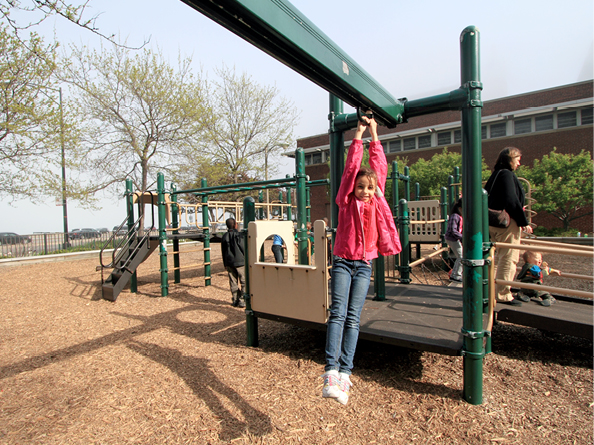
The playground at Lake Shore Park.
Lincoln Park Pritzker Children’s Zoo & Farm-in-the-Zoo ★ 
 After hours of looking at animals from afar in the rest of Lincoln Park Zoo, kids can come here to get up close and personal. Unlike many other children’s zoos, there are no baby animals at the Pritzker Children’s Zoo; instead, the outdoor habitats feature wildlife of the North American woods, including wolves, beavers, and otters. Although there are a few interactive displays outside, most kids head inside to the Treetop Canopy Climbing Adventure, a 20-foot-high wood-and-fabric tree (encased in soft safety netting) that kids can scramble up and down. There are also a few small padded play areas for little ones.
After hours of looking at animals from afar in the rest of Lincoln Park Zoo, kids can come here to get up close and personal. Unlike many other children’s zoos, there are no baby animals at the Pritzker Children’s Zoo; instead, the outdoor habitats feature wildlife of the North American woods, including wolves, beavers, and otters. Although there are a few interactive displays outside, most kids head inside to the Treetop Canopy Climbing Adventure, a 20-foot-high wood-and-fabric tree (encased in soft safety netting) that kids can scramble up and down. There are also a few small padded play areas for little ones.
The Farm-in-the-Zoo ★ is a working reproduction of a Midwestern farm, complete with a white-picket-fenced barnyard, chicken coops, and demonstrations of butter churning and weaving. You’ll also spot plenty of livestock, including cows, sheep, and pigs. Inside the Main Barn (filled with interactive exhibits), the main attraction is the huge John Deere tractor that kids can climb up into and pretend to drive. (Can you say “photo opportunity”?) Allow 1 hour.
2200 N. Cannon Dr.  312/742-2000. www.lpzoo.com. Free admission. Daily 9am–5pm. Bus: 151 or 156.
312/742-2000. www.lpzoo.com. Free admission. Daily 9am–5pm. Bus: 151 or 156.
 Downtown Playgrounds
Downtown Playgrounds
As anyone who’s traveled with little kids well knows, children can take only so much museum-going. Sometimes they have to let loose and run around—luckily, there are playgrounds tucked away in unassuming spots, as long as you know where to look. The Seneca Playlot, 228 E. Chicago Ave., is directly east of the Chicago Water Works Visitor Center and across the street from Water Tower Place mall. The play structures are mostly low-to-the-ground, making it a good choice for toddlers. Walk a few blocks east and you’ll come to Lake Shore Park, 808 N. Lake Shore Dr., which has a good assortment of slides and climbing equipment. As an added bonus, you’ll enjoy views of the lake. An adjoining athletic field has a running track and plenty of space for impromptu soccer or football games. Occupying a large corner lot on the ritzy Gold Coast, Goudy Square Park, at the corner of Astor and Goethe streets, is a tranquil oasis surrounded by high-rises. There are three separate play areas, along with plenty of benches for parents to lounge.
Six Flags Great America ★  One of the Midwest’s biggest theme and amusement parks, Six Flags is midway between Chicago and Milwaukee on I-94 in Gurnee, Illinois. The park has more than 100 rides and attractions and is a favorite of roller coaster devotees. There are a whopping 10 of them here, including the nausea-inducing Déjà Vu, where riders fly forward and backward over a twisting, looping inverted steel track; and Superman, where you speed along hanging headfirst (with your legs dangling). Other don’t-miss rides for the strong of stomach include the Iron Wolf, where you do corkscrew turns and 360-degree loops while standing up, and the American Eagle, a classic wooden coaster. Because this place caters to families, you’ll also find plenty to appeal to smaller visitors. The Looney Tunes National Park is full of kiddie rides with a cartoon theme; other worthwhile stops include the double-decker carousel and bumper cars. Hurricane Harbor, a massive water park with a giant wave pool, is fun on a hot day, but you risk heatstroke waiting in the long lines. Six Flags also has live shows, IMAX movies, and restaurants. If you take the trouble to get out here, allow a full day.
One of the Midwest’s biggest theme and amusement parks, Six Flags is midway between Chicago and Milwaukee on I-94 in Gurnee, Illinois. The park has more than 100 rides and attractions and is a favorite of roller coaster devotees. There are a whopping 10 of them here, including the nausea-inducing Déjà Vu, where riders fly forward and backward over a twisting, looping inverted steel track; and Superman, where you speed along hanging headfirst (with your legs dangling). Other don’t-miss rides for the strong of stomach include the Iron Wolf, where you do corkscrew turns and 360-degree loops while standing up, and the American Eagle, a classic wooden coaster. Because this place caters to families, you’ll also find plenty to appeal to smaller visitors. The Looney Tunes National Park is full of kiddie rides with a cartoon theme; other worthwhile stops include the double-decker carousel and bumper cars. Hurricane Harbor, a massive water park with a giant wave pool, is fun on a hot day, but you risk heatstroke waiting in the long lines. Six Flags also has live shows, IMAX movies, and restaurants. If you take the trouble to get out here, allow a full day.
I-94 at Rte. 132 E., Gurnee.  847/249-4636. www.sixflags.com. Admission (including unlimited rides, shows, and attractions) $55 adults, $35 children under 54 in. tall, free for children 3 and under. May daily 10am–7pm; June–Aug daily 10am–10pm; Sept Sat–Sun 10am–7pm. Parking $10. Take I-94 or I-294 W. to Rte. 132 (Grand Ave.). Approximate driving time from Chicago city limits: 45 min.
847/249-4636. www.sixflags.com. Admission (including unlimited rides, shows, and attractions) $55 adults, $35 children under 54 in. tall, free for children 3 and under. May daily 10am–7pm; June–Aug daily 10am–10pm; Sept Sat–Sun 10am–7pm. Parking $10. Take I-94 or I-294 W. to Rte. 132 (Grand Ave.). Approximate driving time from Chicago city limits: 45 min.
Sightseeing Tours
If you’re in town for a limited time, an organized tour may be the best way to get a quick overview of the city’s highlights. Some tours—such as the boat cruises on Lake Michigan and the Chicago River—can give you a whole new perspective on the city’s landscape. Many tours go beyond sightseeing to explore important historical and architectural landmarks in depth. These specialized tours can help you appreciate buildings or neighborhoods that you might otherwise have passed by without a second glance.
For information about touring Eli’s bakery, which manufactures Chicago’s most famous cheesecake, see the “Dessert Tour” box.
Carriage Rides
Noble Horse (312/266-7878; www.noblehorsechicago.com/carriages.html) maintains the largest fleet of antique horse carriages in Chicago, stationed around the old Water Tower Square at the northwest corner of Chicago and Michigan avenues. Each of the drivers, outfitted in a black tie and top hat, has his or her own variation on the basic Magnificent Mile itinerary (you can also do tours of the lakefront, river, Lincoln Park, and Buckingham Fountain). The charge is $40 for each half-hour, for up to four people. The coaches run year-round, with convertible coaches in the warm months and enclosed carriages furnished with wool blankets on bone-chilling nights. There are several other carriage operators, all of whom pick up riders in the vicinity.

Hop in an antique carriage for a romantic tour of the Magnificent Mile.
Orientation Tours
Chicago Trolley Company Chicago Trolley Company offers guided tours on a fleet of rubber-wheeled “San Francisco–style” trolleys that stop at a number of popular spots around the city, including Navy Pier, the Grant Park museums, the historic Water Tower, and the Sears Tower. You can stay on for the full 2-hour ride or get on and off at each stop. During the summer, the trolleys also offer trips to residential neighborhoods, including Hyde Park, the West Loop, and Wrigleyville. The trolleys operate year-round, but winter visitors won’t need to wear a snowsuit: The vehicles are enclosed and heated during the chilliest months. The same company also operates the Chicago Double Decker Company, which has a fleet of London-style red buses. The two-level buses follow the same route as the trolleys; if you buy an all-day pass, you can hop from bus to trolley at any point. An added bonus: With each ticket, you’ll get a free T-shirt and a coupon book with discounts at local restaurants and shops.
615 W. 41st St.  773/648-5000. www.chicagotrolley.com. All-day hop-on, hop-off pass $29 adults, $24 seniors, $15 children 3–11; family package (2 adults, 2 children) $64 (tickets are 10% cheaper if purchased in advance online). Apr–Oct daily 9am–6:30pm; Nov–Mar daily 9am–5pm. No tours New Year’s Day, Thanksgiving, or Christmas.
773/648-5000. www.chicagotrolley.com. All-day hop-on, hop-off pass $29 adults, $24 seniors, $15 children 3–11; family package (2 adults, 2 children) $64 (tickets are 10% cheaper if purchased in advance online). Apr–Oct daily 9am–6:30pm; Nov–Mar daily 9am–5pm. No tours New Year’s Day, Thanksgiving, or Christmas.
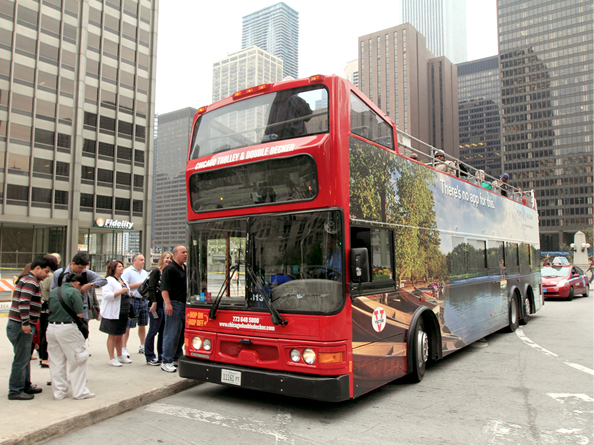
An all-day pass allows you to hop on and off these London-style red buses as you please.
Gray Line Part of a worldwide bus tour company, Gray Line Chicago offers professional tours in well-appointed buses. Excursions run 2 to 5 hours and feature highlights of downtown or various neighborhoods. For an additional fee, some tours include a cruise on Lake Michigan or a visit to the Sears Tower Skydeck.
27 E. Monroe St., Ste. 515.  800/621-4153 or 312/251-3107. www.grayline.com. Tours $20–$50.
800/621-4153 or 312/251-3107. www.grayline.com. Tours $20–$50.
Lake & River Cruises
Chicago Line Cruises This company runs two types of 90-minute cruises: a tour of architecture along the Chicago River, and excursions that travel on the lake and river to explore the development of the city. The atmosphere is more upscale-educational than party-hearty, with knowledgeable guides who make no attempt to double as stand-up comedians. The price includes coffee (Starbucks, no less), soft drinks, cookies, and muffins. During the summer, “cocktail” cruises run daily at 6 and 8pm. For tickets, call or stop by the company’s ticket office on the lower level on the east end of River East Plaza. Advance reservations are recommended.
465 N. McClurg Court, at the end of E. Illinois St.  312/527-1977. www.chicagoline.com. Tickets $38 adults, $32 seniors, $22 children 7–18, free for children 6 and under. May–Oct daily. Tours depart hourly 9am–4pm Memorial Day to Labor Day and every 2 hr. 10am–4pm May, Sept, and Oct.
312/527-1977. www.chicagoline.com. Tickets $38 adults, $32 seniors, $22 children 7–18, free for children 6 and under. May–Oct daily. Tours depart hourly 9am–4pm Memorial Day to Labor Day and every 2 hr. 10am–4pm May, Sept, and Oct.
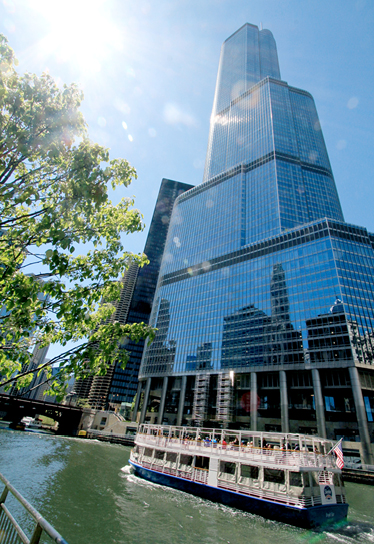
Mystic Blue Cruises A more casual alternative to fancy dinner cruises, this is promoted as more of a “fun” ship (that means DJs at night, although you’ll have to put up with some kind of “live entertainment” no matter when you sail). Daily lunch and dinner excursions are available, as are midnight voyages on weekends. The same company offers more formal (and expensive) cruises aboard the Odyssey (www.odysseycruises.com) and motorboat rides on the 70-passenger Seadog (www.seadogcruises.com), if you really want to feel the water in your face.
Departing from Navy Pier.  877/299-7783. www.mysticbluecruises.com. Lunch cruise $36; dinner cruise $78–$89; midnight cruise $37. Cruises run year-round.
877/299-7783. www.mysticbluecruises.com. Lunch cruise $36; dinner cruise $78–$89; midnight cruise $37. Cruises run year-round.
Shoreline Sightseeing ★ Shoreline launches 30-minute lake cruises every half-hour from its two dock locations at the Shedd Aquarium and Navy Pier. Shoreline has also gotten in on the popularity of architecture tours. Narrated by architectural guides, they cost more than regular tours. A water taxi also runs every half-hour between Navy Pier and the Sears Tower, Michigan Avenue, and the Shedd Aquarium. Tickets for the water taxi cost $5 to $7, depending how far you travel.
Departing from Navy Pier, Shedd Aquarium, and Buckingham Fountain in Grant Park.  312/222-9328. www.shorelinesightseeing.com. Tickets weekdays $14 adults, $13 seniors, $6 children 11 and under ($1 more per ticket on weekends); architectural tours $24 adults, $21 seniors, $12 children 11 and under ($2 more per ticket on weekends). May–Sept daily. Tours depart hourly 10am–7pm Memorial Day to Labor Day and every 30 min. 10am–4pm May and Sept.
312/222-9328. www.shorelinesightseeing.com. Tickets weekdays $14 adults, $13 seniors, $6 children 11 and under ($1 more per ticket on weekends); architectural tours $24 adults, $21 seniors, $12 children 11 and under ($2 more per ticket on weekends). May–Sept daily. Tours depart hourly 10am–7pm Memorial Day to Labor Day and every 30 min. 10am–4pm May and Sept.
The Spirit of Chicago This luxury yacht offers a variety of wining-and-dining harbor cruises, from a lunch buffet to the “Moonlight Dance Party.” This can be a fairly pricey night out if you go for the dinner package; the late-night moonlight cruises are a more affordable option for insomniacs.
Departing from Navy Pier.  866/211-3804. www.spiritcruises.com. Lunch cruise $40–$50; dinner cruise (seated) $80–$110; sunset and midnight cruises $32. Ask about children’s rates. Year-round daily.
866/211-3804. www.spiritcruises.com. Lunch cruise $40–$50; dinner cruise (seated) $80–$110; sunset and midnight cruises $32. Ask about children’s rates. Year-round daily.
Wendella Sightseeing Boats ★ Started in 1935, Wendella is the granddaddy of Chicago sightseeing operators (it’s now run by the original owner’s grandsons). The company operates a 1-hour tour along the Chicago River and a 1½-hour tour along the river and out onto Lake Michigan. (One of the most dramatic events during the boat tour is passing through the locks that separate the river from the lake.) Boats run from late April to early October. The 2-hour sunset tour runs Memorial Day to Labor Day starting at 7:45pm. Scheduling depends on the season and the weather, but cruises usually leave every hour during the summer.
Departing from Michigan Ave. and Wacker Dr. (north side of the river, at the Wrigley Building).  312/337-1446. www.wendellaboats.com. Tickets $26 adults, $25 seniors, $13 children 3–11, free for children 2 and under. Apr–Oct daily.
312/337-1446. www.wendellaboats.com. Tickets $26 adults, $25 seniors, $13 children 3–11, free for children 2 and under. Apr–Oct daily.
Windy ★★ One of the more breathtaking scenes on the lake is this tall ship approaching the docks at Navy Pier. The 148-foot four-masted schooner sets sail for 90-minute cruises two to five times a day, both day and evening. (Because the boats are sometimes booked by groups, the schedule changes each week; check their website or call first to confirm sailing times.) The boats are at the whims of the wind, so every cruise charts a different course. Passengers are welcome to help raise and trim the sails and occasionally take turns at the ship’s helm (with the captain standing close by). The boats are not accessible for people with disabilities.
Departing from Navy Pier.  312/595-5555. www.tallshipadventuresofchicago.com. Tickets $24 adults, $20 seniors and students, $10 children 3–12. Tickets may be purchased online in advance or bought in person 1 hr. before the 1st sail of the day at the ticket office, on the dock at Navy Pier.
312/595-5555. www.tallshipadventuresofchicago.com. Tickets $24 adults, $20 seniors and students, $10 children 3–12. Tickets may be purchased online in advance or bought in person 1 hr. before the 1st sail of the day at the ticket office, on the dock at Navy Pier.
Special-Interest Tours
Chicago Architecture Foundation (CAF) ★★★ Chicago’s architecture is world famous. Luckily, the Chicago Architecture Foundation offers first-rate guided tours to help visitors understand what makes this city’s skyline so special. The foundation offers walking, bike, boat, and bus tours to more than 60 architectural sites and environments in and around Chicago, led by nearly 400 trained and enthusiastic docents (all volunteers). I highly recommend taking at least one CAF tour while you’re in town—they help you look at (and appreciate) the city in a new way. Tours are available year-round but are scheduled less frequently in winter.
One of the CAF’s most popular tours is the 1½-hour Architecture River Cruise, which glides along both the north and the south branches of the Chicago River. Although you can see the same 50 or so buildings by foot, traveling by water lets you enjoy the buildings from a unique perspective. The excellent docents also provide interesting historical details, as well as some fun facts. (David Letterman once called the busts of the nation’s retailing legends that face the Merchandise Mart the “Pez Hall of Fame.”) The docents generally do a good job of making the cruise enjoyable for visitors with all levels of architectural knowledge. In addition to pointing out buildings—Marina City, the Civic Opera House, the Sears Tower—they approach the sites thematically, explaining, for example, how Chicagoans’ use of and attitudes toward the river have changed over time.
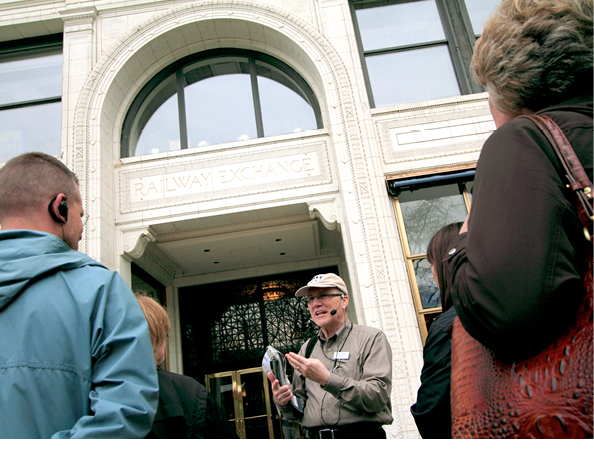
The Chicago Architecture Foundation offers engaging and informative tours of the city.
In the summer (June–Sept), cruises run hourly from 10am to 3pm weekdays and from 9am to 5pm weekends (with more limited schedules in May, Oct, and Nov); the cost is $35 per person. The trips are popular in the summer, so I’d definitely purchase tickets in advance if you’re hoping for a particular date or time. You can buy them online through the Architecture Foundation’s website, but it means shelling out an annoying service charge to Ticketmaster; instead, I’d suggest buying tickets at one of the foundation’s tour centers or from the boat launch on the southeast corner of Michigan Avenue and Wacker Drive.
If you have a limited amount of time in Chicago and want to squeeze in a lot of sightseeing, try the Highlights by Bus tour, a 3½-hour overview that covers the Loop, Hyde Park—including a visit to the interior of Frank Lloyd Wright’s Robie House—and the Gold Coast, plus several other historic districts. Tours start at 9:30am on Friday and Saturday year-round, with additional tours on Wednesdays and Sundays from April through October; tickets are $42 per person.
A 4-hour bus tour of Frank Lloyd Wright sights in Oak Park ($42) is available on the first Saturday of the month from May to October. The tour includes walks through three neighborhoods and commentary on more than 25 houses—but does not take visitors inside Wright’s home and studio. A separate 4-hour bus tour ($52), on Tuesday and Thursday at 9:30am (May–Oct), takes Wright fans inside the master’s home and Oak Park’s Unity Temple.
The CAF offers a variety of guided walking tours. For first-time visitors, I highly recommend two tours for an excellent introduction to the dramatic architecture of the Loop. Historic Downtown: Rise of the Skyscraper (daily 10am) covers buildings built between 1880 and 1940, including the Rookery and the Chicago Board of Trade; Modern Skyscrapers (daily 1pm) includes modern masterpieces by Mies van der Rohe and postmodern works by contemporary architects. The 2-hour tours cost $16 each for adults and $13 each for seniors and students.
The CAF also offers more than 50 neighborhood tours (see website for full list), visiting the Gold Coast, River North, Grant Park, Old Town, the Jackson Boulevard Historic District, and even Lincoln Park Zoo. Most cost $10 and last a couple of hours.
Departing from the Chicago ArchiCenter, 224 S. Michigan Ave.; a few tours leave from the John Hancock Center, 875 N. Michigan Ave.  312/922-3432, or 312/922-TOUR [8687] for recorded information. www.architecture.org. Tickets for most walking tours $12–$16. Subway/El: Brown, Green, Purple, or Orange line to Adams, or Red Line to Jackson.
312/922-3432, or 312/922-TOUR [8687] for recorded information. www.architecture.org. Tickets for most walking tours $12–$16. Subway/El: Brown, Green, Purple, or Orange line to Adams, or Red Line to Jackson.
 The Wright Stuff in the Gold Coast
The Wright Stuff in the Gold Coast
Architecture junkies may want to visit the Charnley-Persky House, 1365 N. Astor St., in the Gold Coast ( 312/915-0105 or 312/573-1365; www.charnleyhouse.org), designed by Frank Lloyd Wright and Louis Sullivan in 1891. Sullivan was Frank Lloyd Wright’s architectural mentor, and although Wright was a junior draftsman on this project, Sullivan allowed him to become involved in the design process. The result is an important landmark in modern architecture that rejected Victorian details and embraced symmetry and simplicity. Free 45-minute tours of the interior are given on Wednesday at noon. A 90-minute tour of the home and the surrounding neighborhood is offered Saturdays at 10am year-round ($10); an additional tour is given at noon April through November. Reservations are not accepted.
312/915-0105 or 312/573-1365; www.charnleyhouse.org), designed by Frank Lloyd Wright and Louis Sullivan in 1891. Sullivan was Frank Lloyd Wright’s architectural mentor, and although Wright was a junior draftsman on this project, Sullivan allowed him to become involved in the design process. The result is an important landmark in modern architecture that rejected Victorian details and embraced symmetry and simplicity. Free 45-minute tours of the interior are given on Wednesday at noon. A 90-minute tour of the home and the surrounding neighborhood is offered Saturdays at 10am year-round ($10); an additional tour is given at noon April through November. Reservations are not accepted.
Chicago Supernatural Tours An offbeat way to experience the real “spirit” of Chicago is to take a narrated bus tour of cemeteries, murder sites, Indian burial grounds, haunted pubs, and other spooky places. Richard Crowe, who bills himself as a “professional ghost hunter,” spins ghost stories, legends, and lore on the 4-hour trip. Yes, there’s plenty of shtick, but Crowe really knows his stuff, so you’ll get an informative history lesson along the way. Reservations are required; Crowe’s tours get especially popular around Halloween, so you’ll definitely want to call ahead.
Crowe also leads 2-hour supernatural boat excursions from July through Labor Day weekend; the tour costs $27 per person and boards at 9:30pm at the Mercury boat dock at Michigan Avenue and Wacker Drive.
Departs from Goose Island Restaurant, 1800 N. Clybourn Ave.  708/499-0300. www.ghosttours.com. $44 per person. Tours offered once or twice a month Fri–Sat nights; call for exact schedule. Subway/El: Red Line to North/Clybourn and short walk.
708/499-0300. www.ghosttours.com. $44 per person. Tours offered once or twice a month Fri–Sat nights; call for exact schedule. Subway/El: Red Line to North/Clybourn and short walk.
Untouchable Tours The days of Al Capone are long gone, but Chicago’s notorious past is still good for business, it seems, given the popularity of these “Gangster Tours.” The 2-hour bus trip takes you to all of the city’s old hoodlum hangouts from the Prohibition era, including O’Bannion’s flower shop and the site of the St. Valentine’s Day massacre. The focus is definitely more on entertainment than history (guides with names such as “Al Dente” and “Ice Pick” appear in costume and role-play their way through the tour), but the trip does give you a pretty thorough overview of the city.
Departs from the southeast corner of Clark and Ohio sts.  773/881-1195. www.gangstertour.com. Tickets $30. Tours depart Mon–Wed 10am; Thurs 10am and noon; Fri 10am, noon, 2pm, and 7:30pm; Sat 10am, noon, 2, and 4pm; Sun 10am and noon.
773/881-1195. www.gangstertour.com. Tickets $30. Tours depart Mon–Wed 10am; Thurs 10am and noon; Fri 10am, noon, 2pm, and 7:30pm; Sat 10am, noon, 2, and 4pm; Sun 10am and noon.
Neighborhood Tours
It’s a bit of a cliché to say that Chicago is a city of neighborhoods, but if you want to see what really makes the place special, that’s where you have to go.
Sponsored by the city’s Department of Cultural Affairs, Chicago Neighborhood Tours ★ (312/742-1190; www.chicagoneighborhoodtours.com) are 4- to 5-hour narrated bus excursions to about a dozen diverse communities throughout the city. Departing at 10am from the Chicago Cultural Center, 77 E. Randolph St., every Saturday, the tours visit different neighborhoods, from Chinatown and historic Bronzeville on the South Side to the ethnic enclaves of Devon Avenue and Uptown on the North Side. Neighborhood representatives serve as guides and greeters along the way as tour participants visit area landmarks, murals, museums, and shopping districts. Tickets (including a light snack) are $30 for adults and $25 for seniors, students, and children 8 to 18. Tours do not run on major holidays (call first) or, usually, in January. Regularly available specialty tours include Literary Chicago; the Great Chicago Fire; Roots of Blues, Gospel & Jazz; Irish Chicago; and Magnificent Churches. These tours, which generally run about 4 to 6 hours and include lunch, are more expensive ($50 adults, $45 seniors and children 8–18).
On Saturday mornings in the summer, the Chicago History Museum offers 2-hour walking tours of the neighborhoods surrounding the museum: the Gold Coast, Old Town, and Lincoln Park. Led by museum docents, they average about four per month June through August. Day and evening tours are available, and a few specialty walking tours are usually offered as well. Tours are $15 per person, and registration is recommended but not required. Tours depart from the museum at Clark Street and North Avenue, and light refreshments are served afterward. In the summer and fall, the museum also offers a few half-day trolley tours that cover unique themes or aspects of the metropolitan area’s history. Led by historians and scholars, they take place in the city and surrounding areas ($45). Tours depart from the Chicago History Museum at Clark Street and North Avenue. Call 312/642-4600, or visit the museum’s website (www.chicagohistory.org) for schedules and to order tickets online.
Groups interested in African-American history should visit Bronzeville (also known as the “Black Metropolis”), the South Side neighborhood where immigrants from the South created a flourishing business-and-artistic community in the 1930s and ’40s. Walking and bus tours of the area can be arranged through the Bronzeville Visitor Information Center, 3501 S. Martin Luther King Dr. (773/373-2842; www.bviconline.info). A locally based company that specializes in black heritage tours, Black CouTours (773/233-8907; www.blackcoutours.com) offers a “Soul Side of the Windy City” tour, which includes Obama-related sites. Tour Black Chicago (773/684-9034; www.tourblackchicago.com) sells self-guided tours on CD, which are best if you’re visiting with a car.
Cemetery Tours
Don’t be scared away by the creepy connotations. Some of Chicago’s cemeteries are as pretty as parks, and they offer a variety of intriguing monuments that are a virtual road into the city’s history.
One of the best area cemeteries is Graceland, stretching along Clark Street in the Swedish neighborhood of Andersonville, where you can view the tombs and monuments of many Chicago notables. When Graceland was laid out in 1860, public parks were rare. The elaborate burial grounds that were constructed in many large American cities around that time had the dual purpose of relieving the congestion of the municipal cemeteries closer to town and providing pastoral recreational settings for the Sunday outings of the living. Indeed, cemeteries like Graceland were the precursors of such great municipal green spaces as Lincoln Park.
The Chicago Architecture Foundation (312/922-TOUR [8687]; www.architecture.org) offers walking tours of Graceland on select Sundays during August, September, and October. The tour costs $15 and lasts about 2 hours. Among the points of interest in these 121 beautifully landscaped acres are the Ryerson and Getty tombs, famous architectural monuments designed by Louis Sullivan. Sullivan himself rests here in the company of several of his distinguished colleagues: Daniel Burnham, Ludwig Mies van der Rohe, and Howard Van Doren Shaw. Chicago giants of industry and commerce buried at Graceland include Potter Palmer, Marshall Field, and George Pullman. The Chicago Architecture Foundation offers tours of other cemeteries, including Rosehill Cemetery, suburban Lake Forest Cemetery, and Oak Woods Cemetery, the final resting place for many famous African-American figures, including Jesse Owens, Ida B. Wells, and Mayor Harold Washington.
Staying Active
Perhaps because winters can be brutal, Chicagoans take their summers seriously. In the warmer months, with the wide blue lake and the ample green parks, it’s easy to think that the city is one big grown-up playground. Whether you prefer your activity in the water or on dry ground, you’ll probably find it here. For information, contact the city’s park district (312/742-PLAY [7529]; www.chicagoparkdistrict.com); for questions about the 29 miles of beaches and parks along Lake Michigan, call the park district’s lakefront region office at 312/747-2474.
Beaches
Public beaches line Lake Michigan all the way up north into the suburbs and Wisconsin, and southeast through Indiana and into Michigan. The best known is Oak Street Beach. Its location, at the northern tip of the Magnificent Mile, creates some interesting sights as sun worshippers sporting swimsuits and carting coolers make their way down Michigan Avenue. The most popular is massive North Avenue Beach, about 6 blocks farther north, where Lincoln Park singles come to play, check each other out, and fly by on bikes and in-line skates. Rows of beach volleyball courts stretch out beside a vintage steamship-shaped beach house; there’s also a Venice Beach–style outdoor gym; Hollywood-Ardmore Beach (officially Kathy Osterman Beach), at the northern end of Lake Shore Drive, is a lovely crescent that’s less congested and has steadily become more popular with gays who’ve moved up the lakefront from the Belmont Rocks, a longtime hangout. For more seclusion, try Ohio Street Beach, an intimate sliver of sand in tiny Olive Park, just north of Navy Pier, which, incredibly enough, remains largely ignored despite its central location. If you have a car, head up to Montrose Beach, a beautiful unsung treasure about midway between North Avenue Beach and Hollywood-Ardmore Beach (with plenty of free parking). It has an expanse of beach mostly uninterrupted by piers or jetties, and a huge adjacent park with soccer fields, one big hill that’s great for kite flying, and even a small bait shop where anglers can go before heading to a nearby long pier designated for fishing.
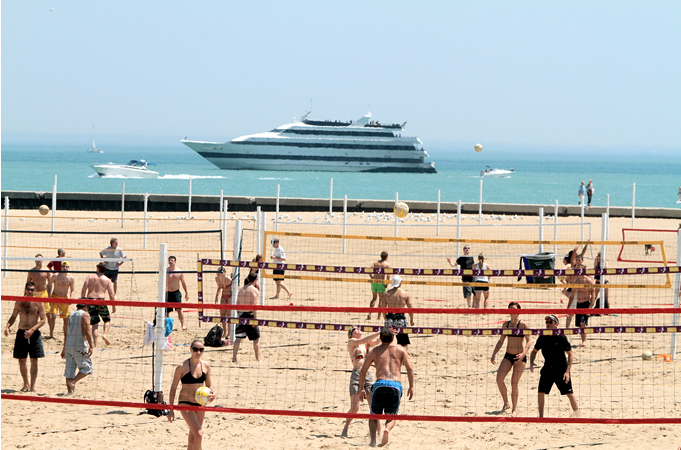
Volleyball on North Avenue Beach.
If you’ve brought the pooch along, you might want to take him for a dip at the doggie beach south of Addison Street, at about Hawthorne and Lake Shore Drive (although this minute spot aggravates some dog owners because it’s in a harbor where the water is somewhat fouled by gas and oil from nearby boats). A tip: Try the south end of North Avenue Beach in early morning, before it opens to the public for the day. (Also consider that, in the off season, all beaches are fair game for dogs. The police won’t hassle you, I promise.)

Relaxing in the sun at the doggie beach on Hawthorne and Lake Shore Drive.
Beaches officially open with a full retinue of lifeguards on duty around June 20, though swimmers can wade into the chilly water from Memorial Day to Labor Day. Only the bravest souls venture into the water before July, when the temperature creeps up enough to make swimming an attractive proposition. Please take note that the entire lakefront is not beach, and don’t go do anything stupid such as dive off the rocks.
Biking
Biking is a great way to see the city, particularly along the lakefront bike path that extends for more than 18 miles. The stretch between Navy Pier and North Avenue Beach gets extremely crowded in the summer (you’re jostling for space with in-line skaters, joggers, and dawdling pedestrians). If you’re looking to pick up some speed, I recommend biking south (once you’re past the Museum Campus, the trail is relatively wide open, and you can zip all the way to Hyde Park). If you want a more leisurely tour with people-watching potential, head north (through the crowds). After you pass Belmont Harbor, the traffic lets up a bit. Ride all the way to Hollywood Beach (where the lakefront trail ends) for a good but not exhausting workout.

Chicago’s lakefront bike batch extends for more than 18 miles.
To rent bikes, try Bike and Roll Chicago (www.bikechicago.com), which has locations at Navy Pier (312/595-9600), North Avenue Beach (773/327-2706), and Millennium Park (888/BIKE-WAY [245-3929]). Open from 8am to 8pm May through October (weather permitting), Bike Chicago stocks mountain and touring bikes, kids’ bikes, strollers, and—most fun of all—quadcycles, which are four-wheel contraptions equipped with a steering wheel and canopy that can accommodate four or five people. Rates for bikes start at $10 an hour, $30 a day, with helmets, pads, and locks included. If you’d like to cycle your way past some Chicago landmarks, guided tours are also available.
Both the park district (312/742-PLAY [7529]) and the Active Transportation Alliance (312/427-3325; www.activetrans.org) offer free maps that detail popular biking routes. The latter, which is the preeminent organization for cyclists in Chicago, sells a much larger, more extensive map ($10) that shows routes within a seven-county area. The federation sponsors a number of bike rides throughout the year, including the highly enjoyable Boulevard Lakefront Tour, held in September, which follows the historic circle of boulevards that had their genesis in the Chicago Plan of 1909. It starts in Hyde Park at the University of Chicago campus.
A word of caution: Never head anywhere on the city’s streets without first strapping on a helmet. Designated bike lanes have been added to many main thoroughfares, but most cabbies and drivers tend to ignore them. Bike with extreme caution on city streets (you can get a ticket for biking on the sidewalk), and stick to the lakefront path if you’re not an expert rider. Locking your bike anywhere you go is a no-brainer.
Golfing
For a major metropolis, Chicago has an impressive number of golf options within the city limits (not to mention many plush and pricey suburban courses). The closest you’ll get to golfing downtown is the Green at Grant Park (312/987-1818; www.thegreenonline.com), an 18-hole putting course on Monroe Street between Columbus Avenue and Lake Shore Drive, just east of Millennium Park. It’s not exactly tournament-level play, but it’s more challenging than miniature golf—and the setting can’t be beat. The course is open daily from May through October from 10am to 10pm, and putters and golf balls are provided. Rates are $12 per round for adults, $6 for children 12 and under.
To warm up your swing, head to the Diversey Driving Range, 141 W. Diversey Pkwy. (312/742-7929), in Lincoln Park just north of Diversey Harbor. This two-level range attracts all levels—from show-off heavy hitters to beginners—and is very popular on weekends with young singles who live in the surrounding apartment buildings. The price is right ($14 for a bucket of 100 balls), and the setting is pretty much perfect.
The Chicago Park District runs six golf courses in the city. One of the most popular is the 9-hole Sydney Marovitz Course, 3600 N. Lake Shore Dr. (at Waveland Ave.), which many Chicagoans simply call Waveland. Thanks to its picturesque lakefront location, it’s always full on weekends, so make a reservation well in advance (and don’t expect a quick game—this is where beginners come to practice). Another good bet—and usually less crowded—is the 18-hole course in Jackson Park on the South Side (63rd St. and Stoney Island Ave.). These city-run courses are open from mid-April through November; for information on greens fees, location, and hours, call the Chicago Park District golf office (312/245-0909; www.cpdgolf.com).
For information about suburban golf courses, visit the website of the Chicago District Golf Association (www.cdga.org).
Ice Skating
The city’s premier skating destination is the McCormick-Tribune Ice Rink at Millennium Park, 55 N. Michigan Ave. (312/742-5222). The location is pretty much perfect: You’re skating in the shadows of grand skyscrapers and within view of the lake. The rink is open daily from 10am to 10pm November through March. Admission is free, and skate rentals are $10.
The park district runs dozens of other skating surfaces throughout the city, along the lakefront and in neighborhood parks. Call 312/742-PLAY [7529] for locations. There’s also a relatively small rink at Navy Pier, 600 E. Grand Ave. (312/595-PIER [7437]).
In-Line Skating
The wheeled ones have been battling bikers over control of Chicago’s lakefront paths since the early 1990s. If you want to join in the competition, Londo Mondo, 1100 N. Dearborn St. (312/751-2794; www.londomondo.com), on the Gold Coast, rents blades for $7 an hour or $20 a day. The best route to skate is the lakefront trail that leads from Lincoln Park down to Oak Street Beach. Beware, though, that those same miles of trail are claimed by avid cyclists, and collisions between distracted ’bladers and bikers have been known to happen. On busy summer days, approach Chicago lakefront traffic as carefully as you would a major expressway.
Sailing
It seems a shame just to sit on the beach and watch all those beautiful sailboats gliding across the lake, so go on, get out there. Chicago Sailing, in Belmont Harbor (773/871-SAIL [7245]; www.chicagosailing.com), rents J-22 and J-30 boats from 9am to sunset, weather permitting, May through October. A J-22, which holds four or five adults, rents for $55 to $75 an hour; a J-30, which accommodates up to 10 people, costs $95 to $110 per hour. If you want to take the boat out without a skipper, you need to demonstrate your skills first (for an additional $15 fee). If you’d rather sit back and relax, you can charter a boat. Reservations are recommended.
Swimming
The Chicago Park District maintains about 30 indoor pools for lap swimming and general splashing around, but none is particularly convenient to downtown. The lakefront is open for swimming until 9:30pm Memorial Day to Labor Day in areas watched over by lifeguards (no swimming off the rocks, please). But be forewarned: The water is usually freezing. If you’re willing to take a dip anyway, a good place for lake swimming is the water along the wall beginning at Ohio Street Beach, slightly northwest of Navy Pier. The Chicago Triathlon Club marks a course here each summer with a buoy at both the quarter- and half-mile distances. This popular swimming route follows the shoreline in a straight line. The water is fairly shallow. For more information, call the park district’s beach and pool office (312/742-PLAY [7529]).
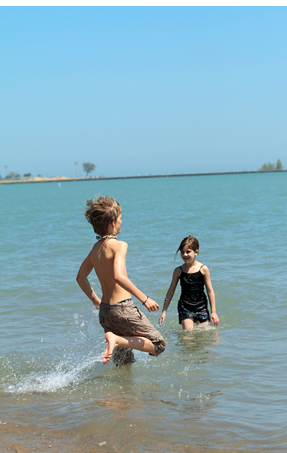
Be forewarned: The water in Lake Michigan is usually freezing!
In the Grandstand: Watching Chicago’s Athletic Events
Baseball
Baseball is imprinted on the national consciousness as part of Chicago, not because of victorious dynasties, but because of the opposite—the Black Sox scandal of 1919 and the perennially losing Cubs.
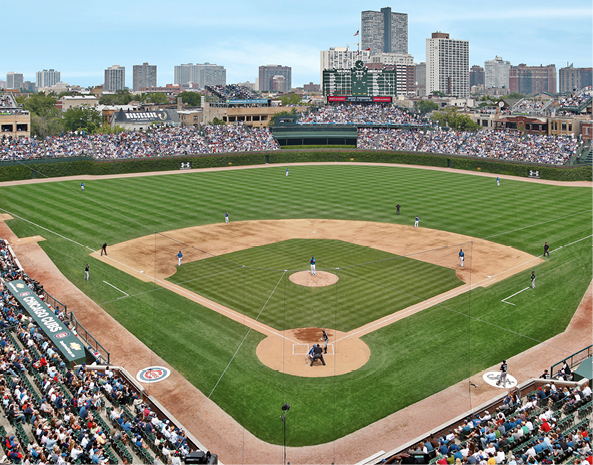
Despite the Cubs’ losing record, locals and visitors alike flock to scenic Wrigley field.
The Chicago Cubs haven’t made a World Series appearance since 1945 and haven’t been world champs since 1908, but that doesn’t stop people from catching games at historic Wrigley Field ★★, 1060 W. Addison St. (773/404-CUBS [2827]; www.cubs.mlb.com), with its ivy-covered outfield walls, its hand-operated scoreboard, its view of the shimmering lake from the upper deck, and its “W” or “L” flag announcing the outcome of the game to the unfortunates who couldn’t attend. After all the strikes, temper tantrums, and other nonsense, Wrigley has managed to hold on to something like purity. Yes, Wrigley finally installed lights (it was the last major-league park to do so), but by agreement with the residential neighborhood, the Cubs still play most games in the daylight, as they should. Because Wrigley is small, just about every seat is decent.
No matter how the Cubs are doing, tickets ($15–$90) go fast; most weekend and night games sell out by Memorial Day. Your best bet is to hit a weekday game, or try your luck buying a ticket on game day outside the park, when you’ll often find some season ticket holders looking to unload a few seats.
Wrigley’s easy to reach by El; take the Red Line to the Addison stop, and you’re there. Or take the no. 22 bus, which runs up Clark Street. To buy tickets in person, stop by the ticket windows at Wrigley Field Monday through Friday from 9am to 6pm, Saturday from 9am to 4pm, and on game days. Call 800/THE-CUBS [843-2827] for tickets through Tickets.com (866/652-2827 outside Illinois); you can also order online through the team website.
Despite their stunning World Series win in 2005, the Chicago White Sox still struggle to attract the same kind of loyalty (despite the fact that they regularly win more games than the Cubs). Longtime fans rue the day owner Jerry Reinsdorf replaced admittedly dilapidated Comiskey Park with a concrete behemoth that lacks the yesteryear charm of its predecessor. That said, the current stadium, U.S. Cellular Field, 333 W. 35th St. (312/674-1000; www.whitesox.mlb.com), in the South Side neighborhood of Bridgeport, has spectacular sightlines from every seat (if you avoid the vertigo-inducing upper deck), and the park has every conceivable amenity, including above-average food concessions, shops, and plentiful restrooms. The White Sox’s endearing quality is the blue-collar aura with which so many Cubs-loathing Southsiders identify. Games rarely sell out—an effect, presumably, of Reinsdorf’s sterile stadium and the blighted neighborhood that surrounds it. All of this makes it a bargain for bona fide baseball fans. Tickets cost $20 to $68 and are half-price on Monday.
To get Sox tickets, call Ticketmaster (866/SOX-GAME [769-4263]), or visit the ticket office, open Monday through Friday from 10am to 6pm, Saturday and Sunday from 10am to 4pm, with extended hours on game days. To get to the ballpark by El, take the Red Line to Sox/35th Street.
 Field of Dreams
Field of Dreams
Built in 1914, Wrigley Field is the second-oldest major-league ballpark, after Boston’s Fenway Park, and remains one of the only surviving old-time baseball stadiums in the country (no luxury boxes here!). Known as the “friendly confines,” Wrigley Field was the site of Babe Ruth’s “called shot,” when Ruth allegedly pointed to a bleacher location in the 1932 World Series and then hit a home run to that exact spot. For an intimate look at the historic ballpark, take one of the behind-the-scenes tours offered almost daily throughout the summer; stops include the visitors’ and home team locker rooms, press box, security headquarters, and, yes, a walk around the field itself (be sure to check out the original scoreboard, built in 1937). Some dates do sell out, so buy tickets ($25) in advance online, if possible. Keep in mind that if you take a tour on a game day, some areas (such as the locker rooms) will be off-limits. Call  773/404-CUBS [2827], or stop by the box office at 1060 W. Addison St.; you can also buy tickets online through the Cubs website (www.mlb.com/chc/ballpark/wrigley_field_tours.jsp).
773/404-CUBS [2827], or stop by the box office at 1060 W. Addison St.; you can also buy tickets online through the Cubs website (www.mlb.com/chc/ballpark/wrigley_field_tours.jsp).
Basketball
When it comes to basketball, Chicagoans still live in the past, associating the Chicago Bulls (312/455-4000; www.nba.com/bulls) with the glory days of Michael Jordan and the never-ending championships of the 1990s. The fact that Jordan chose to remain in town after his playing days were over—a decision almost unheard of in professional sports—has only burnished his image here, and locals are still wowed by occasional Jordan sightings. The downside is that he’s a constant reminder of our ever-more-distant winning past.
Although the current players don’t inspire the same city-wide fervor, the Bulls have rebounded somewhat from the dismal seasons following Jordan’s departure and even made some respectable showings in post-season play. The Bulls don’t consistently sell out, which means you might be able to catch a game at the cavernous United Center, 1901 W. Madison St. (312/455-4500; www.unitedcenter.com). Yes, the space is massive and impersonal, but the pre-game buildup, with flashing lights and thumping music, is undeniably dramatic. Most tickets run $20 to $100 through Ticketmaster (312/559-1212), although be aware that the cheap seats are practically in the rafters. If money is no object, you can usually score good seats through local ticket brokers without much advance notice.
Football
The Chicago Bears play at Soldier Field, Lake Shore Drive and 16th Street (847/295-6600; www.chicagobears.com), site of a controversial renovation that added what looks like a giant space ship on top of the original stadium’s elegant colonnade. Architecturally, it’s a disaster, but from a comfort perspective, the place is much improved—although that doesn’t impress longtime fans who prided themselves on surviving blistering-cold game days and horrifying bathrooms. The Bears themselves have been inspiring high hopes—most recently, winning a trip to the Super Bowl in 2007. But even during losing seasons, tickets are hard to come by. (Most are snapped up by season ticket holders long before the season starts.) If you plan ahead, individual tickets run $45 to $300; expensive seats are usually available through ticket brokers or online sites.
The Northwestern Wildcats play Big Ten college ball at Ryan Field, 1501 Central St., in nearby Evanston (847/491-CATS [2287]). Unfortunately, Northwestern grads are not particularly loyal to their long-suffering team. In fact, fans of the visiting team often outnumber NU supporters in the stands.
Hockey
The Chicago Blackhawks have devoted, impassioned fans who work themselves into a frenzy with the first note of “The Star-Spangled Banner,” but for years, they had to put up with mediocre play and less-than-stellar management. Over the past few seasons, though, the team that once boasted legends such as Bobby Hull and Tony Esposito has made a comeback, winning the Stanley Cup in 2010. Going to a Hawks games has once again become a rousing—and sometimes rowdy—experience. The Blackhawks play at the United Center, 1901 W. Madison St. (312/455-7000; www.chicagoblackhawks.com). Tickets cost $15 to $100.
For a more affordable and family-friendly outing, catch the semipro Chicago Wolves at Allstate Arena, 6920 N. Mannheim Rd., Rosemont (847/724-GOAL [4625]; www.chicagowolves.com). The team has been consistently excellent over the past few years, and the games are geared toward all ages, with fireworks beforehand and plenty of on- and off-ice entertainment (tickets $13–$30).
Horse Racing
Thoroughbreds race at Arlington International Racecourse, 2200 W. Euclid Ave., Arlington Heights (847/385-7500; www.arlingtonpark.com), in the northwest suburbs. Live local bands and DJs add to the party atmosphere on Fridays and Saturdays from Memorial Day weekend until Labor Day, starting at 2:30pm. The Chicago area’s other major racetrack, Hawthorne Race Course, 3501 S. Laramie Ave., Stickney (708/780-3700; www.sportsmanspark.com), is located in the southwest suburbs, about a half-hour drive from downtown.
Soccer
Chicago’s Major League Soccer team, the Chicago Fire, plays at its own 20,000-seat stadium in suburban Bridgeview (about 12 miles southwest of downtown). The season runs from late May through October (888/MLS-FIRE [657-3473]; www.chicago-fire.com). Games have a family feel, with plenty of activities for kids and affordable ticket prices ($15–$60).